inbox and environment news: Issue 556
September 25 - October 1, 2022: Issue 556
100 Trees For 100 Years Of Avalon Beach
Above are some of the 100 trees that have been planted in and around the Avalon Beach village centre over the past few months to celebrate the Avalon Beach Centenary.
An Avalon 100 Centenary wildlife talk is scheduled for Sunday 16th October at 11am in the Avalon RSL.
Roger Treagus of the Avalon 100 Committee states;
''One of the important features of Avalon life is its wildlife. We will have three speakers at the event - John Dengate will talk about the general scene and is keen to answer lots of questions that residents may have. Then Andrew Gregory, famed wildlife photographer will show his stunning pictures of the powerful owl. Finally we have Merinda Air from WIRES to explain what to do when encountering injured wildlife.''
Australian water dragon, Intellagama lesueurii, catching some afternoon sun at Careel Creek, Avalon Beach. Photos: A J Guesdon
Watch Out - Shorebirds About
.JPG.opt1460x973o0,0s1460x973.jpg?timestamp=1663629195339)
West Head Lookout Upgrade
- The area of outlook unencumbered by fencing has been substantially reduced yet the information email highlights a cross section through this area. In fact most of the site will be affected by a crude metal perimeter fence similar to a pool fence - see red highlight on plan below.
- The scheme is represented as a concept design whereas it is in fact part of a tender set presumably advanced to call tenders for construction. This is a barrier to addressing any design concerns raised.
- The site is widely recognised as an exceptional example of landscape architecture within a national park. The National Trust is similarly concerned with developments proposed for this location.
- It appears the concerns originally raised by so many in the community either have not been heard or appreciated. These relate to the lookout serving as a place where the public have been able to enjoy unimpeded views over Pittwater and North to Bouddhi. The lookout has been a quiet place of contemplation as well as a place for small numbers of people to stop for impromptu picnics. The imposition of a 1200 high crude metal fence will impact the enjoyment currently experienced. The proposal as it stands is a regressive step and detracts from the experience of visiting this exceptional site.
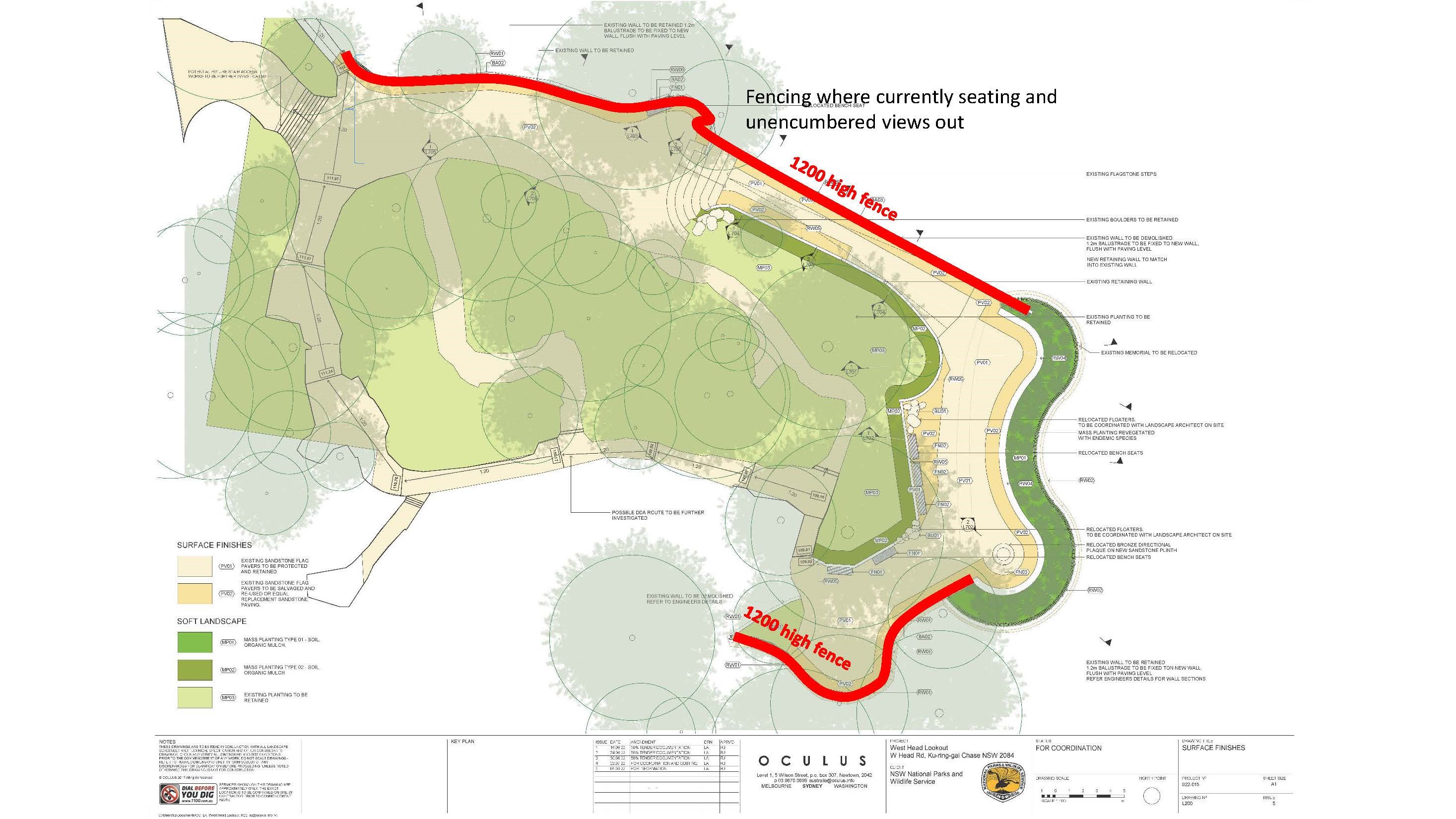
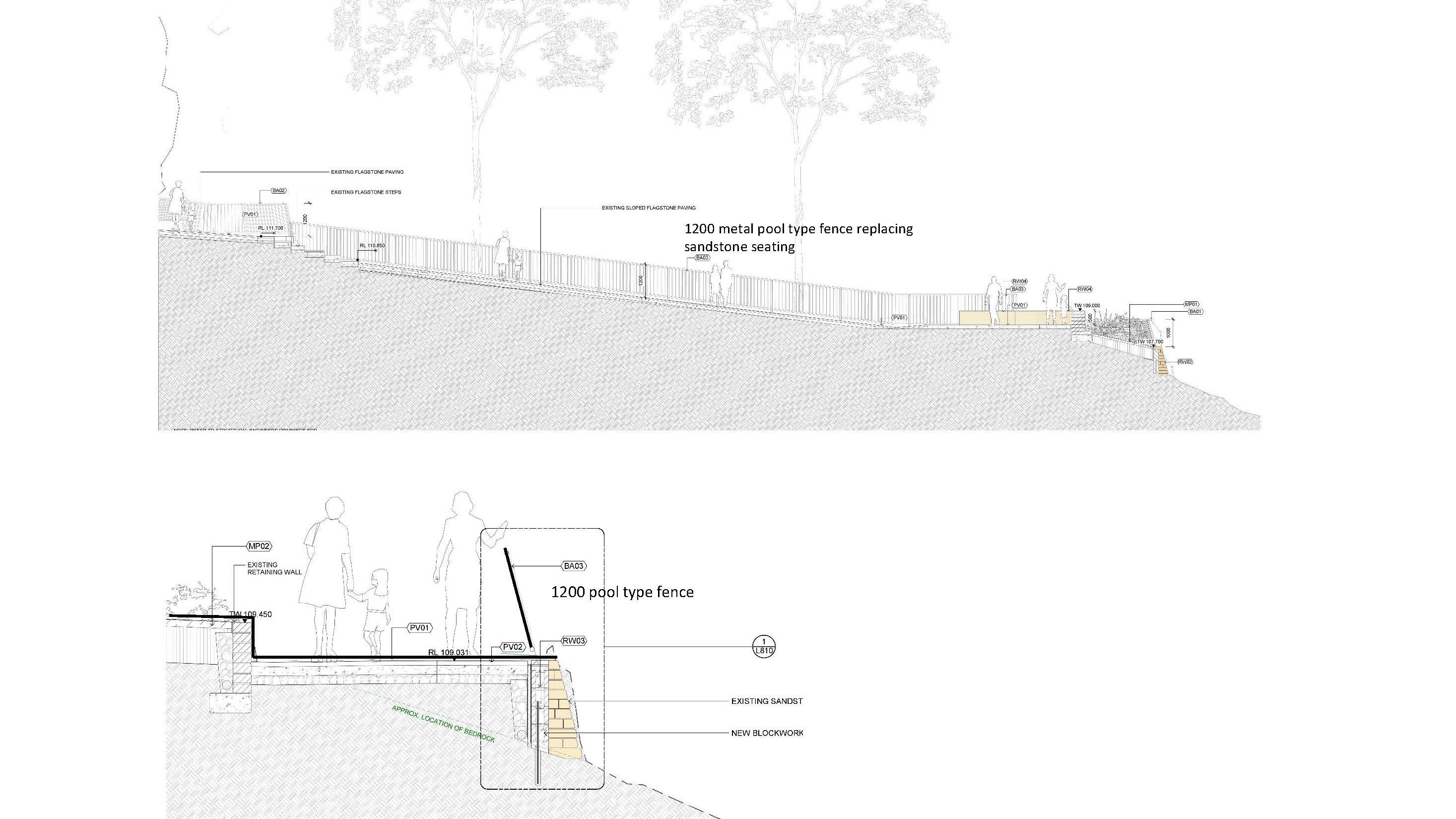
Over A Hectare Of Crown Land At Belrose To Be Sold: Transferred Public Lands
 Residents have contacted Pittwater Online regarding the transfer of over one hectare of Crown Land at Blackbutts road Belrose to Aruma (formerly House With No Steps).
Residents have contacted Pittwater Online regarding the transfer of over one hectare of Crown Land at Blackbutts road Belrose to Aruma (formerly House With No Steps). Scotland Island Spring Garden Festival
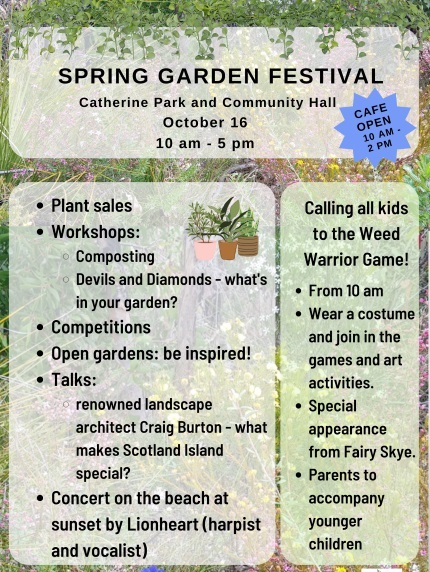
Weed Alert: Corky Passionflower At Mona Vale + Narrabeen Creek
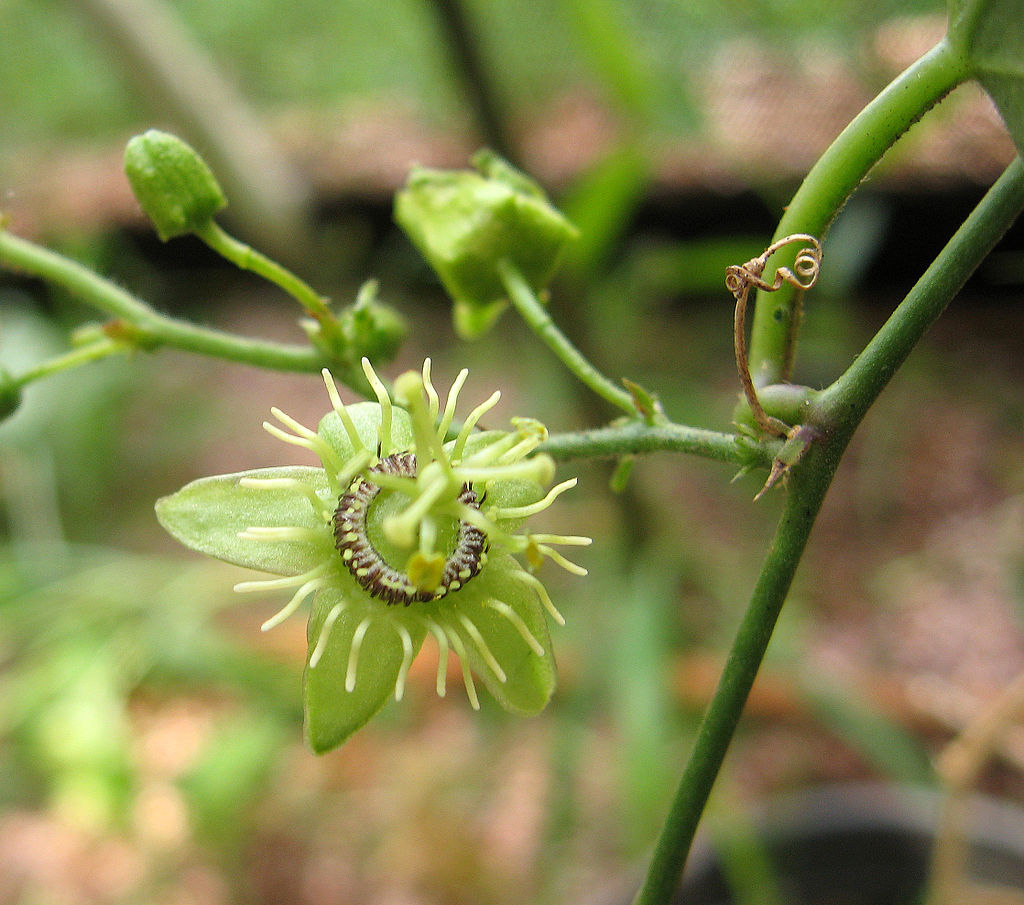
.jpg?timestamp=1663392221562)
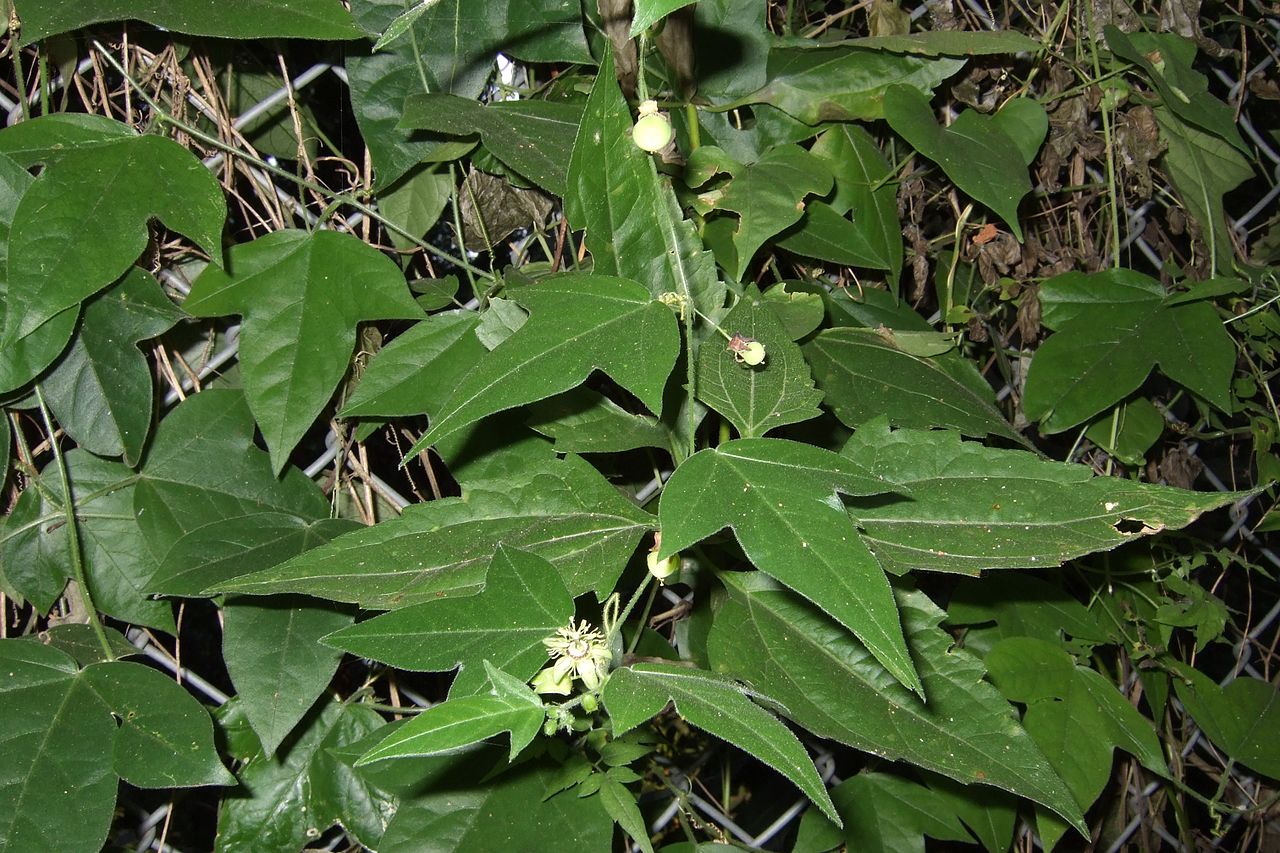
Northern Beaches Clean Up Crew: Clontarf September 25
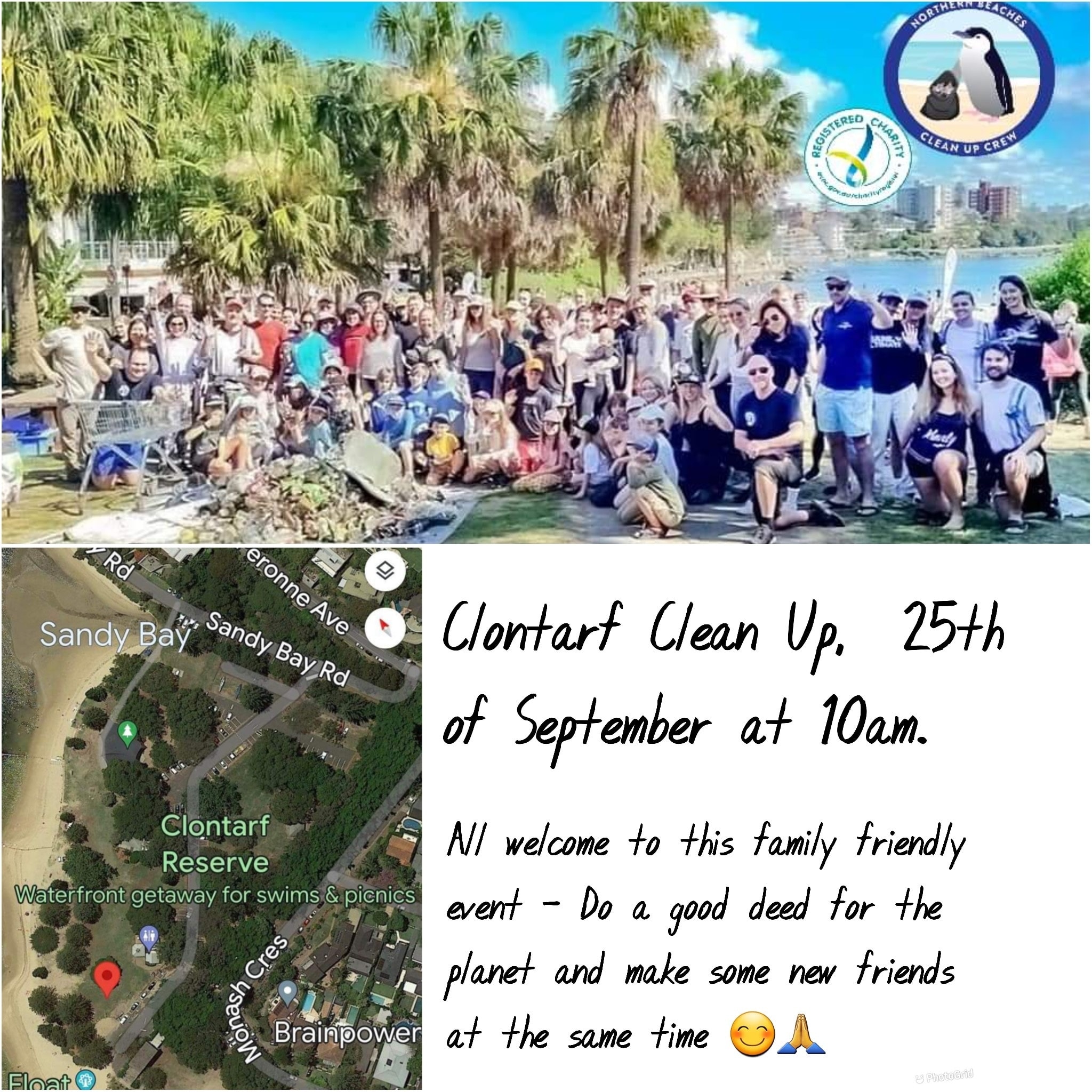
Want noisy miners to be less despotic? Think twice before filling your garden with nectar-rich flowers
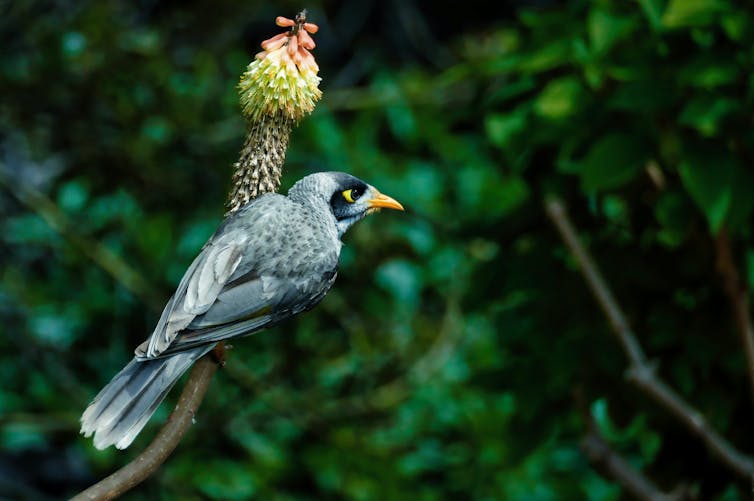
Noisy miners are complicated creatures. These Australian native honeyeaters live in large cooperative groups, use alarm calls to target specific predators, and sometimes help raise the young of other miners. But they’re perhaps best known for their aggressive and coordinated attacks on other birds – a behaviour known as “mobbing”.
We conducted a study investigating some of the possible factors that influence mobbing. We were interested in whether access to human food left on plates at cafes, or a high nectar supply thanks to planted gardens, might give urban miners extra energy and time to mob other species more often. We also examined whether miners were more aggressive towards some species over others.
Our study, published in the journal Emu - Austral Ornithology, found it wasn’t cafes with access to sugar-rich food that led to more miner aggression. In fact, gardens were where we recorded the highest amount of aggressive behaviour.
Understanding mobbing is important, because this behaviour can drive out other birds and reduce diversity. Smaller birds with a similar diet to noisy miners are particularly vulnerable.
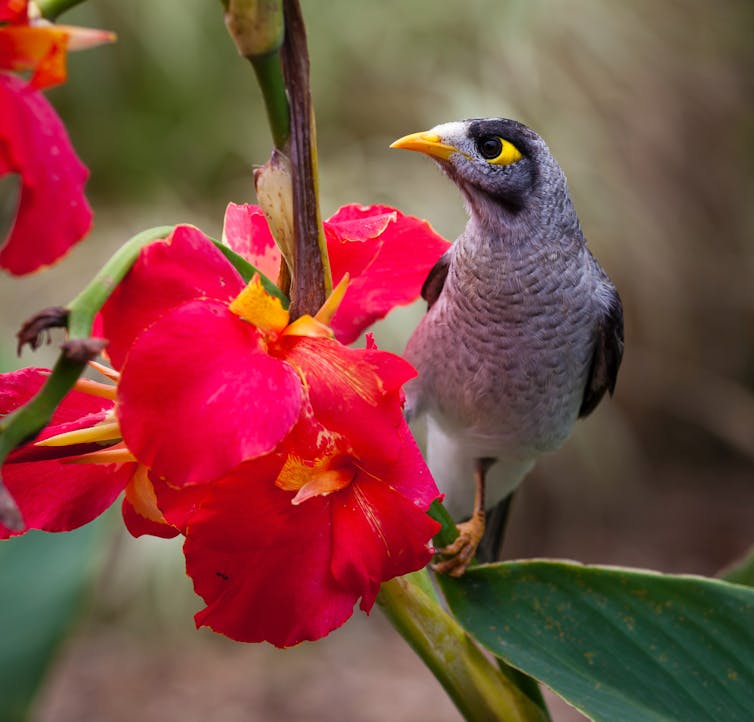
What We Did
The noisy miner’s preferred habitat is along the edges of open eucalypt forest, including cleared land and urban fringes. Their numbers have grown in recent decades, presenting a significant conservation problem.
We know from previous research that urban noisy miners tend to be more aggressive compared with rural populations.
But to examine mobbing behaviour more closely, we placed museum taxidermies (stuffed animals) of different species of birds in three different types of habitat around Canberra:
urban cafes with lots of food leftovers
urban gardens that had higher-than-usual supplies of nectar
bush areas more typical of “natural” miner habitat.
For each habitat, we then presented the resident noisy miners with three different types of museum taxidermy models of birds:
food competitors with a similar diet to miners, both of the same size (musk lorikeets) and a much smaller species (spotted pardalote)
potential predators, including a dangerous species that preys on miners (brown goshawk) and a species that robs nests but poses less of a risk to adult miners (pied currawong)
neutral species, meaning a bird that does not prey upon nor compete with miners for food (in our study, we used a model of an eastern rosella).
We wanted to see how miners responded to these “intruders” in various settings. We also set up a speaker nearby to broadcast alarm calls, to see how miners reacted.

What We Found
We found interesting differences in how miners responded to our taxidermy models and the broadcasted alarm calls.
Noisy miners exhibited aggressive behaviours for a much longer time in gardens and cafés in comparison to natural bush areas.
Surprisingly, however, access to sugar-rich food from cafes didn’t yield the most aggressive behaviour. Rather, we recorded the highest levels of aggressive behaviour near garden sites.
Nectar-rich plants (such as grevilleas and bottlebrushes) are attractive to birds with a sweet tooth, and miners are no exception. Newer cultivars flower for longer, meaning miners living in our gardens may have access to an almost year-round source of food.
Ready access to these flowering shrubs may affect aggression by providing more time, energy or reward to noisy miners defending these uber-rich resources.
The type of model presented also impacted miner response.
More miners were attracted to an area and mobbed the subject for longer when the model was of a predator.
Miners showed even greater aggression to food competitor models, however. They were more likely to physically strike food competitor models with a peck or swoop compared to predator models.
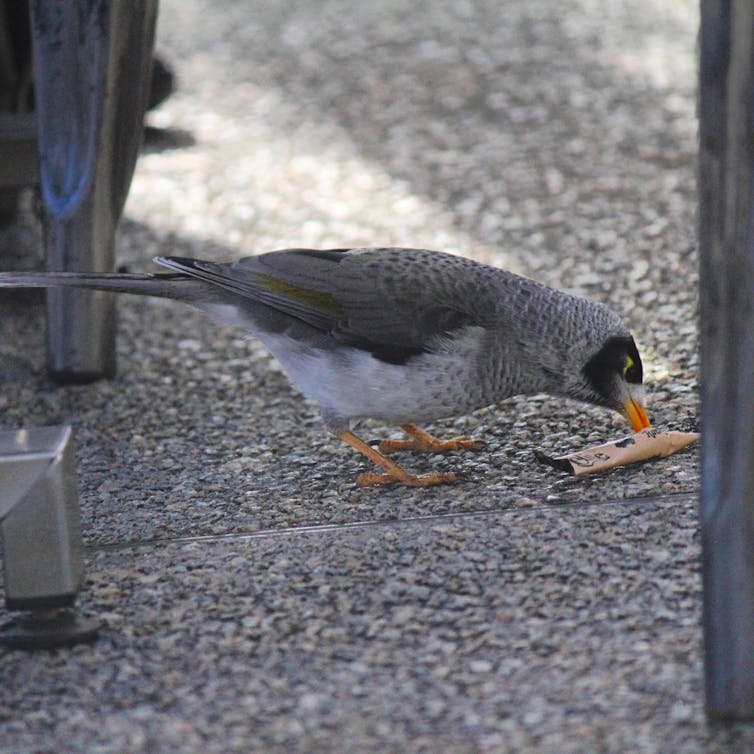
What Can Gardeners Do With These Findings?
Our research shows the importance of considering how gardens – whether in back yards, in parks or new housing estates – can affect local ecosystems, including bird behaviour. Previous studies have drawn a link between the types of plants humans choose to plant and the local mix of bird species.
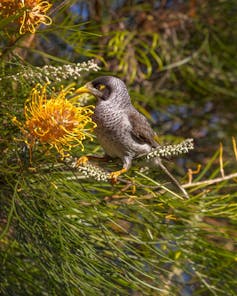
To reduce the risk of creating a perfect habitat for despotic miners in your garden, aim to:
plant multi-layered levels in your garden – that means including ground cover, small shrubs, medium shrubs and trees to provide shelter at different heights for various birds and animals
consider planting plenty of dense shrubs with small flowers to attract insects and provide shelter for small birds
use a mix of nectar-rich and non-flowering shrubs and grasses (instead of focusing too heavily on flowering plants)
try to avoid planting too many exotic species; opt instead for native plants local to your area and suited to the climate, as these benefit native plants and animals whilst minimising benefits to aggressive noisy miners.

Jade Fountain, PhD Student, University of Adelaide and Paul McDonald, Professor of Animal Behaviour, University of New England
This article is republished from The Conversation under a Creative Commons license. Read the original article.
Sydney Pig And Cattle Feed Check Helps Protect Livestock Industries
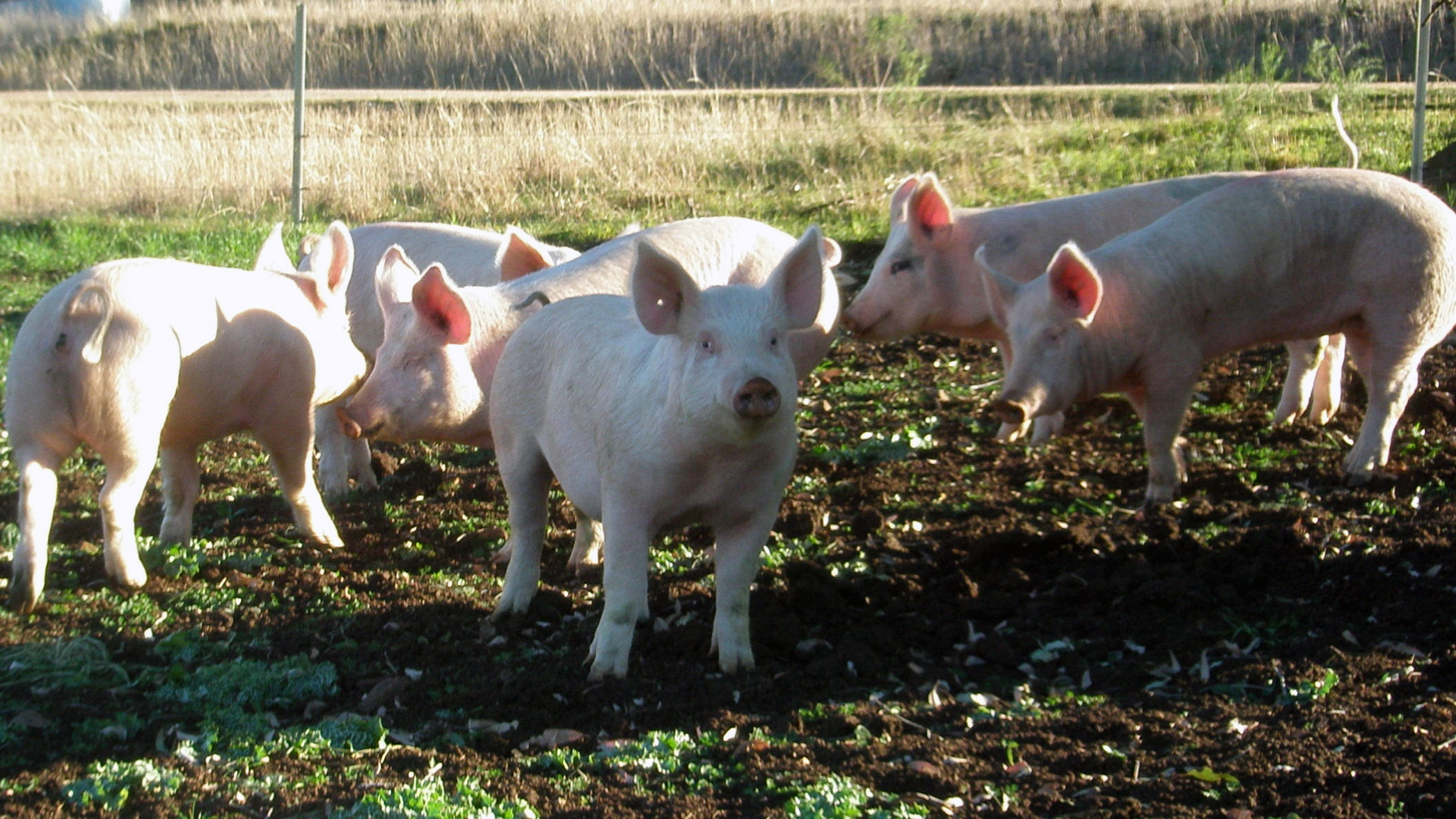
Hunter Residents Encouraged To Be On The Lookout For Toxic Cane Toads
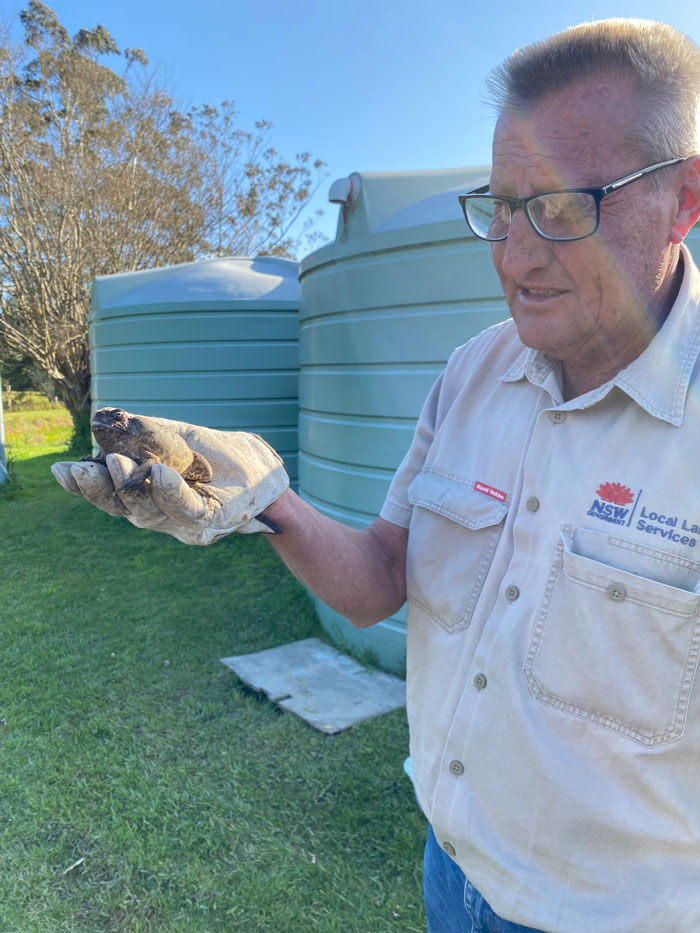
New Research Facilities To Put NSW Seafood Industry In Box Seat
- Double marine finfish fingerling production capacity over the next five years;
- Support the oyster industry with continued selective breeding, while assisting the emergence of new industries based on seaweeds and microalgae;
- Attract an additional three new research partnerships in the next three years; and,
- Ensure the continuity of spat and fingerling supply for existing and developing aquaculture, and for marine fish stocking exercises, including Mulloway and Dusky Flathead.
Katandra Bushland Sanctuary Open
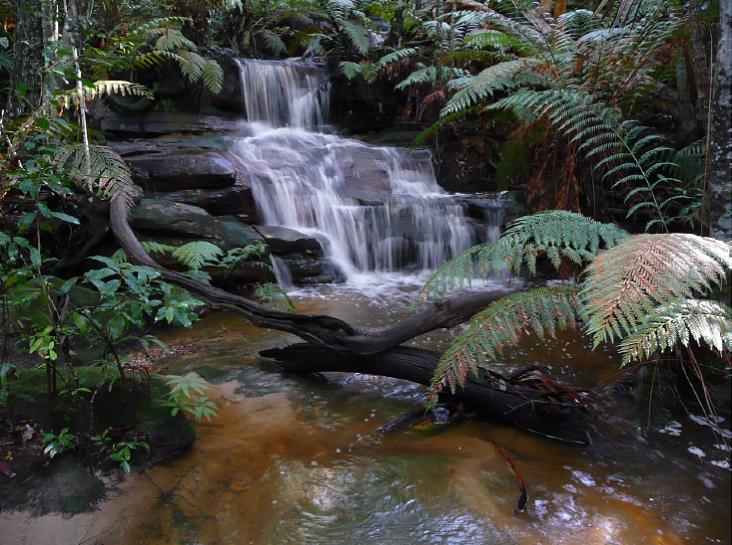
Ku-Ring-Gai Sculpture Trail For 2022 Eco Festival
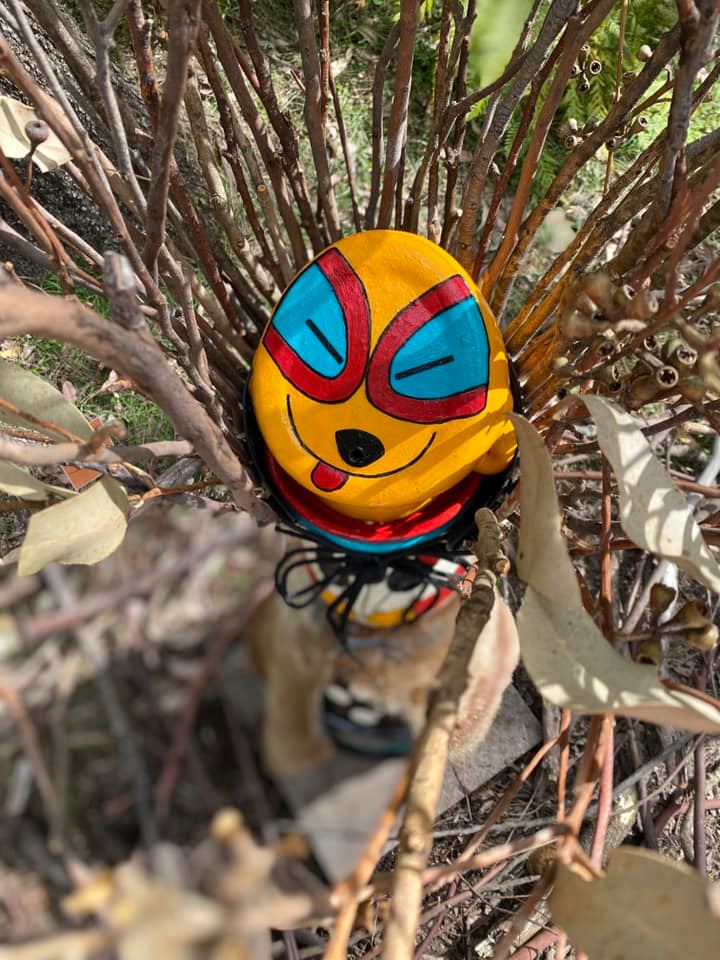
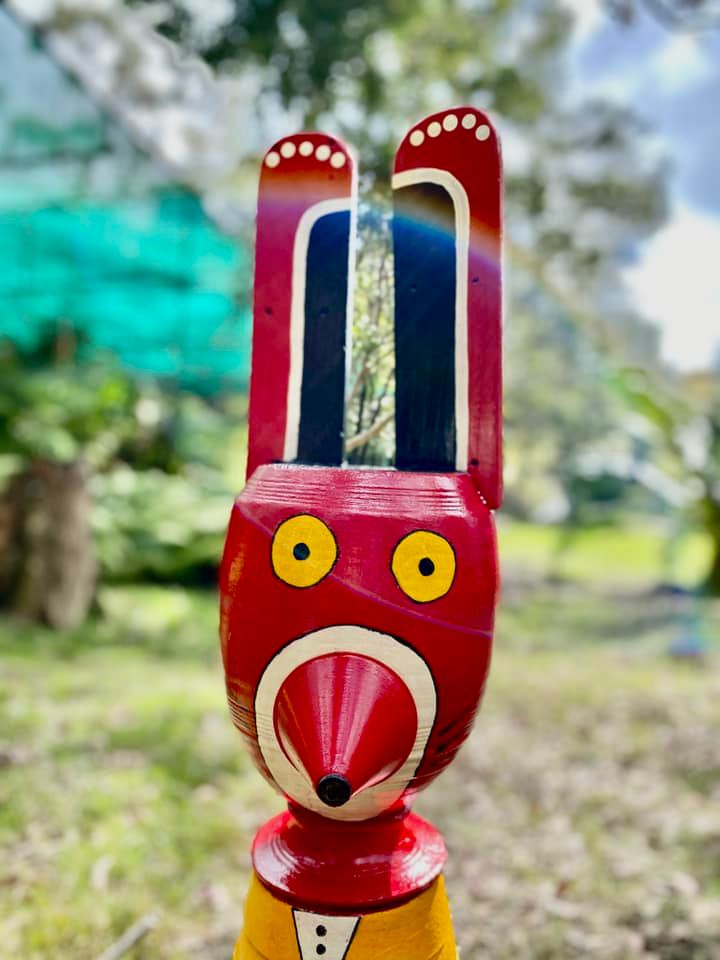
Dust Off Your Picnic Blankets For The First Ever Statewide Picnic For Nature
Echidna 'Love Train' Season Commences
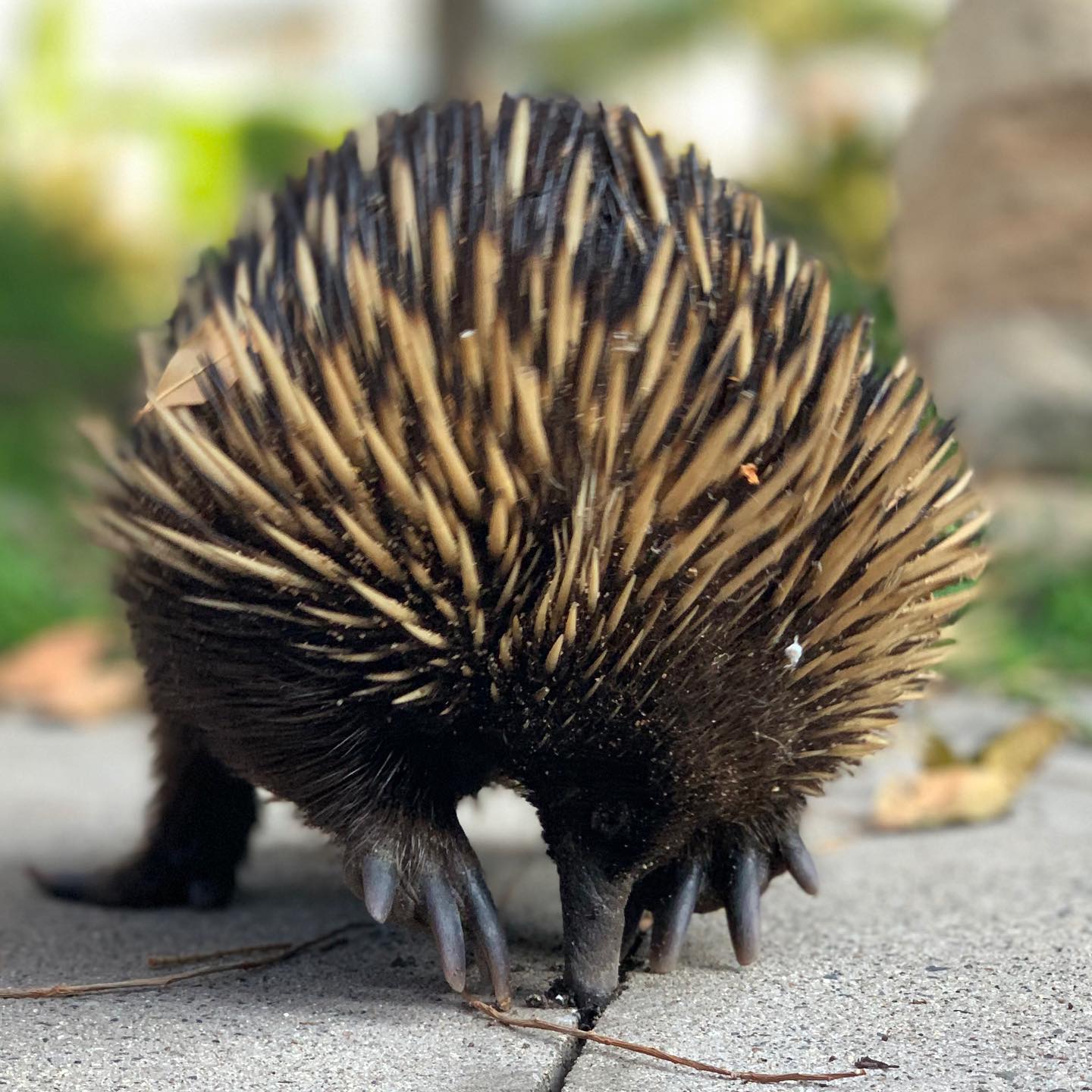
EPA Releases Climate Change Policy And Action Plan
September 8, 2022
The NSW Environment Protection Authority (EPA) is taking action to protect the environment and community from the impacts of climate change, today releasing its new draft Climate Change Policy and Action Plan which works with industry, experts and the community to reduce greenhouse gas emissions and support resilience.
NSW EPA Chief Executive Officer Tony Chappel said the EPA has proposed a set of robust actions to achieve a 50 per cent reduction in carbon emissions by 2030 (from 2005 levels), ensure net zero emissions by 2050, and improve resilience to climate change impacts.
“NSW has ambitious targets that align with the world’s best scientific advice and the Paris commitments, to limit global warming to an average of 1.5 degrees in order to avoid severe impacts on ecosystems,” Mr Chappel said.
“Over the past few years we have seen first-hand just how destructive the impacts of climate change are becoming, not only for our environment, but for NSW communities too.
“We know the EPA has a critical role to play in achieving the NSW Government’s net-zero targets and responding to the increasing threat of climate change induced weather events.
“Equally, acting on climate presents major economic opportunities for NSW in new industries such as clean energy, hydrogen, green metals, circular manufacturing, natural capital and regenerative agriculture.
“This draft Policy sends a clear signal to regulated industries that we will be working with them to support and drive cost-effective decarbonisation while implementing adaptation initiatives that build resilience to climate change risks.
“Our draft plan proposes a staged approach that ensures the actions the EPA takes are deliberate, well informed and complement government and industry actions on climate change. These actions will support industry and allow reasonable time for businesses to plan for and meet any new targets or requirements.
“Climate change is an issue that we all face so it’s important that we take this journey together and all play our part in protecting our environment and communities for generations to come.”
Actions include:
- working with industry, government and experts to improve the evidence base on climate change
- supporting licensees prepare, implement and report on climate change mitigation and adaptation plans
- partnering with NSW Government agencies to address climate change during the planning and assessment process for activities the EPA regulates
- establishing cost-effective emission reduction targets for key industry sectors
- providing industry best-practice guidelines to support them to reduce their greenhouse gas emissions
- phasing in the introduction of greenhouse gas emission limits on environment protection licences for key industry sectors
- developing and implementing resilience programs, best-practice adaptation guidance and harnessing citizen science and education programs
- working with EPA Aboriginal and Youth Advisory Committees to improve the EPA’s evolving climate change response
EPA Acting Chair Carolyn Walsh said the EPA is a partner in supporting and building on the NSW Government’s work to address climate change for the people of NSW.
“The draft Policy and Action Plan adopts, supports and builds on the strong foundations that have been set by the NSW Government through the NSW Climate Change Policy Framework, Net Zero Plan and Climate Change Adaptation Strategy,” Ms Walsh said.
The EPA will work with stakeholders, including licensees, councils, other government agencies, and the community to help implement the actions.
The draft EPA Climate Change Policy and Action Plan is available at https://yoursay.epa.nsw.gov.au/ and comments are open until 3 November 2022.
Wanted: Photos Of Flies Feeding On Frogs (For Frog Conservation)
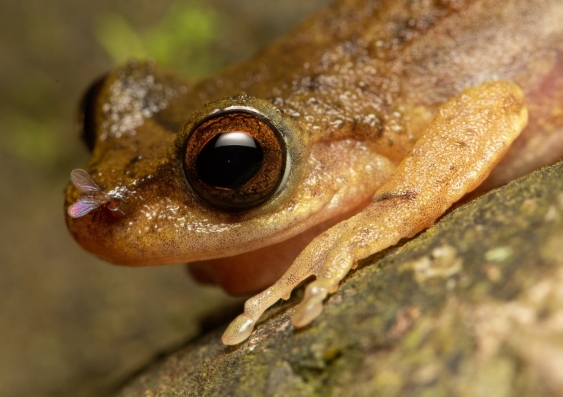
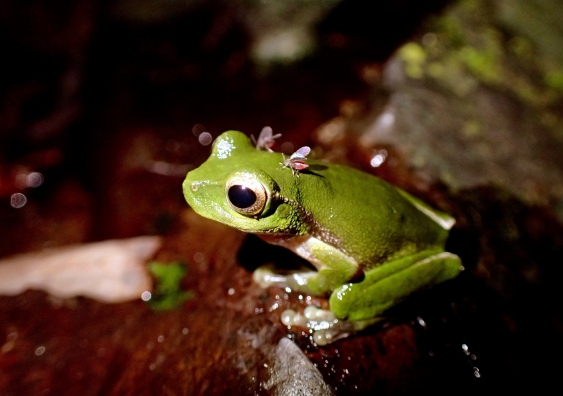
Possums In Your Roof?: Do The Right Thing

Local Wildlife Rescuers And Carers State That Ongoing Heavy Rains Are Tough For Us But Can Be Tougher For Our Wildlife:
- Birds and possums can be washed out of trees, or the tree comes down, nests can disintegrate or hollows fill with water
- Ground dwelling animals can be flooded out of their burrows or hiding places and they need to seek higher ground
- They are at risk crossing roads as people can't see them and sudden braking causes accidents
- The food may disappear - insects, seeds and pollens are washed away, nectar is diluted and animals can be starving
- They are vulnerable in open areas to predators, including our pets
- They can't dry out and may get hypothermia or pneumonia
- Animals may seek shelter in your home or garage.
You can help by:
- Keeping your pets indoors
- Assessing for wounds or parasites
- Putting out towels or shelters like boxes to provide a place to hide
- Drive to conditions and call a rescue group if you see an animal hit (or do a pouch check or get to a vet if you can stop)
- If you are concerned take a photo and talk to a rescue group or wildlife carer
There are 2 rescue groups in the Northern Beaches:
Sydney Wildlife: 9413 4300
WIRES: 1300 094 737
Please be patient as there could be a few enquiries regarding the wildlife.
Generally Sydney Wildlife do not recommend offering food but it may help in some cases. Please ensure you know what they generally eat and any offerings will not make them sick. You can read more on feeding wildlife here
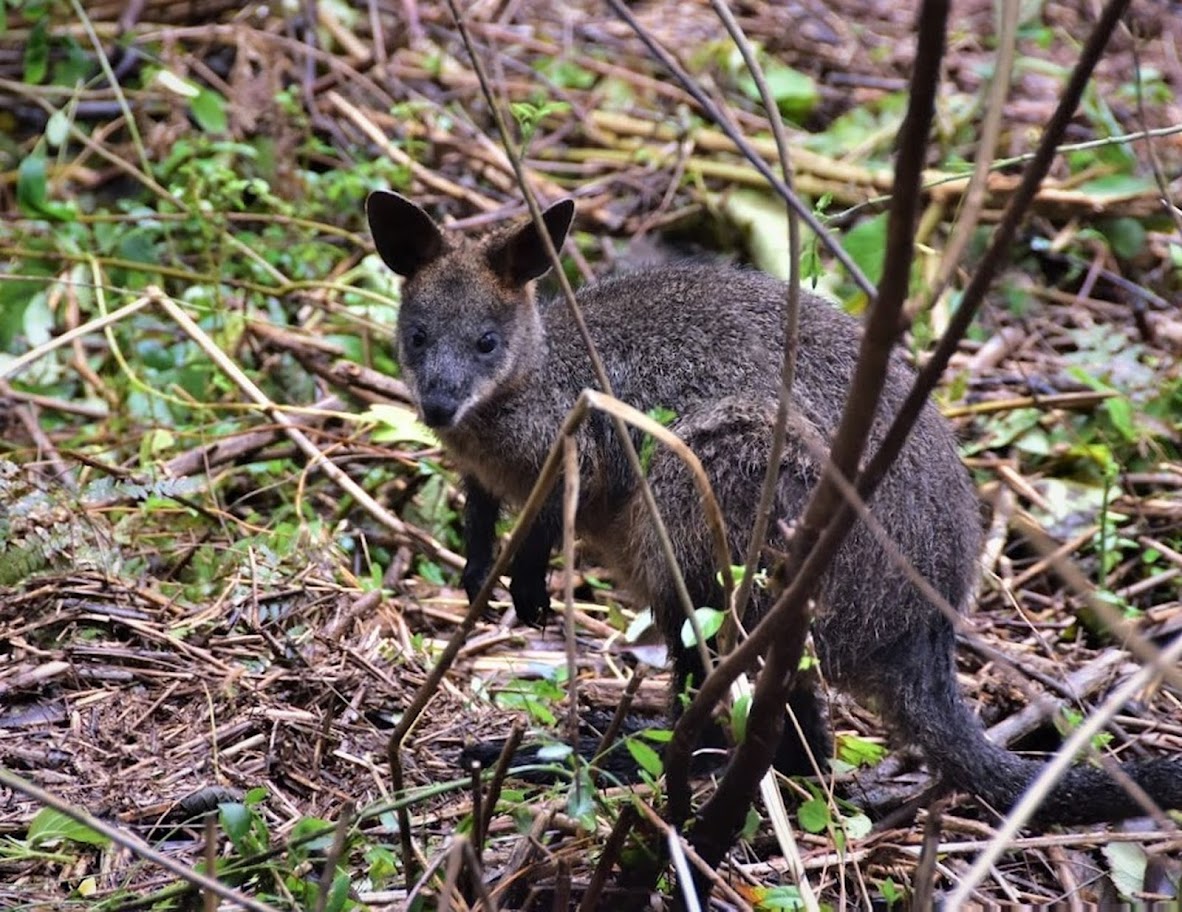
Information courtesy Ed Laginestra, Sydney Wildlife volunteer. Photo: Warriewood Wetlands Wallaby by Kevin Murray, March 2022.
Aviaries + Possum Release Sites Needed

Sydney Wildlife Rescue: Helpers Needed
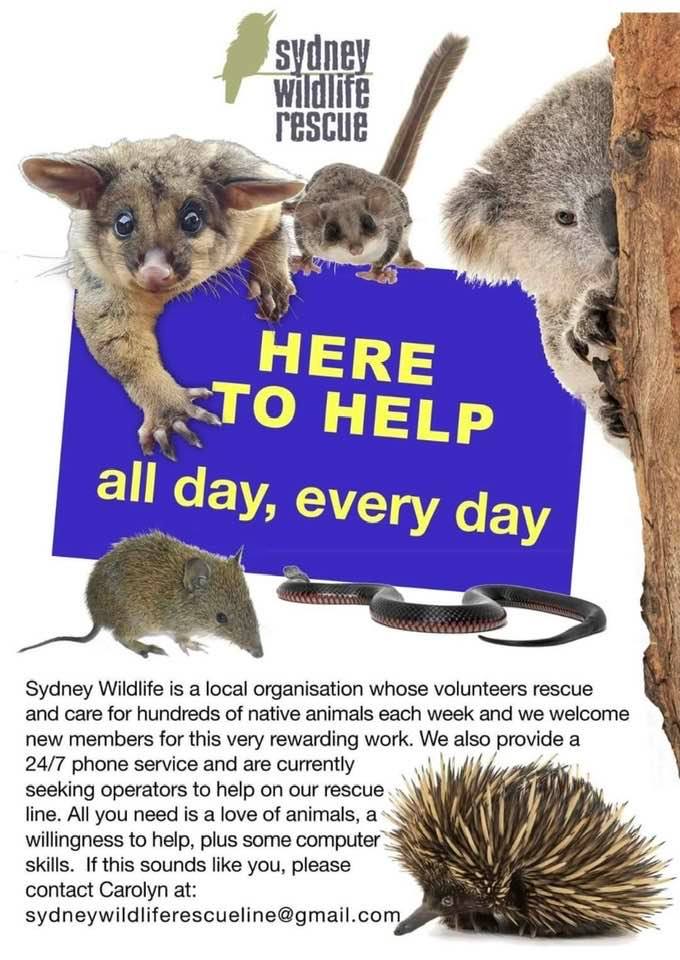
Bushcare In Pittwater
Where we work Which day What time
Avalon
Angophora Reserve 3rd Sunday 8:30 - 11:30am
Avalon Dunes 1st Sunday 8:30 - 11:30am
Avalon Golf Course 2nd Wednesday 3 - 5:30pm
Careel Creek 4th Saturday 8:30 - 11:30am
Toongari Reserve 3rd Saturday 9 - 12noon (8 - 11am in summer)
Bangalley Headland 2nd Sunday 9 to 12noon
Bayview
Winnererremy Bay 4th Sunday 9 to 12noon
Bilgola
North Bilgola Beach 3rd Monday 9 - 12noon
Algona Reserve 1st Saturday 9 - 12noon
Plateau Park 1st Friday 8:30 - 11:30am
Church Point
Browns Bay Reserve 1st Tuesday 9 - 12noon
McCarrs Creek Reserve Contact Bushcare Officer To be confirmed
Clareville
Old Wharf Reserve 3rd Saturday 8 - 11am
Elanora
Kundibah Reserve 4th Sunday 8:30 - 11:30am
 Mona Vale
Mona Vale Mona Vale Beach Basin 1st Saturday 8 - 11am
Mona Vale Dunes 2nd Saturday +3rd Thursday 8:30 - 11:30am
Newport
Bungan Beach 4th Sunday 9 - 12noon
Crescent Reserve 3rd Sunday 9 - 12noon
North Newport Beach 4th Saturday 8:30 - 11:30am
Porter Reserve 2nd Saturday 8 - 11am
North Narrabeen
Irrawong Reserve 2nd Saturday 2 - 5pm
Palm Beach
North Palm Beach Dunes 3rd Saturday 9 - 12noon
Scotland Island
Catherine Park 2nd Sunday 10 - 12:30pm
Elizabeth Park 1st Saturday 9 - 12noon
Pathilda Reserve 3rd Saturday 9 - 12noon
Warriewood
Warriewood Wetlands 1st Sunday 8:30 - 11:30am
Whale Beach
Norma Park 1st Friday 9 - 12noon
Western Foreshores
Coopers Point, Elvina Bay 2nd Sunday 10 - 1pm
Rocky Point, Elvina Bay 1st Monday 9 - 12noon
Gardens And Environment Groups And Organisations In Pittwater
Sneezing with hay fever? Native plants aren’t usually the culprit

Hay fever is a downside of springtime around the world. As temperatures increase, plant growth resumes and flowers start appearing.
But while native flowering plants such as wattle often get the blame when the seasonal sneezes strike, hay fever in Australia is typically caused by introduced plant species often pollinated by the wind.
A Closer Look At Pollen
Pollen grains are the tiny reproductive structures that move genetic material between flower parts, individual flowers on the same plant or a nearby member of the same species. They are typically lightweight structures easily carried on wind currents or are sticky and picked up in clumps on the feathers of a honeyeater or the fur of a fruit bat or possum.
Hay fever is when the human immune system overreacts to allergens in the air. It is not only caused by pollen grains but fungal spores, non-flowering plant spores, mites and even pet hair.
The classic symptoms of hay fever are sneezing, runny noses, red, itchy, and watery eyes, swelling around the eyes and scratchy ears and throat.
The problem with pollen grains is when they land on the skin around our eyes, in our nose and mouth, the proteins found in the wall of these tiny structures leak out and are recognised as foreign by the body and trigger a reaction from the immune system.
So What Plants Are The Worst Culprits For Causing Hay Fever?
Grasses, trees, and herbaceous weeds such as plantain are the main problem species as their pollen is usually scattered by wind. In Australia, the main grass offenders are exotic species including rye grass and couch grass (a commonly used lawn species).
Weed species that cause hay fever problems include introduced ragweed, Paterson’s curse, parthenium weed and plantain. The problematic tree species are also exotic in origin and include liquid amber, Chinese elm, maple, cypress, ash, birch, poplar, and plane trees.
Although there are some native plants that have wind-spread pollen such as she-oaks and white cypress pine, and which can induce hay fever, these species are exceptional in the Australian flora. Many Australian plants are not wind pollinated and use animals to move their clumped pollen around.
For example, yellow-coloured flowers such as wattles and peas are pollinated by insect such as bees. Red- and orange-coloured flowers are usually visited by birds such as honeyeaters. Large, dull-coloured flowers with copious nectar (the reward for pollination) are visited by nocturnal mammals including bats and possums. Obviously Australian plant pollen can still potentially cause the immune system to overreact, but these structures are less likely to reach the mucous membranes of humans.
What Can We Do To Prevent Hay Fever Attacks At This Time Of The Year?
With all of this in mind, here are some strategies to prevent the affects of hay fever:
- stay inside and keep the house closed up on warm, windy days when more pollen is in the air
- if you must go outside, wear sunglasses and a face mask
- when you return indoors gently rinse (and don’t rub) your eyes with running water, change your clothes and shower to remove pollen grains from hair and skin
- try to avoid mowing the lawn in spring particularly when grasses are in flower (the multi-pronged spiked flowers of couch grass are distinctive)
- when working in the garden, wear gloves and facial coverings particularly when handling flowers
- consider converting your garden to a native one. Grevilleas are a great alternative to rose bushes. Coastal rosemary are a fabulous native replacement for lavender. Why not replace your liquid amber tree with a fast growing, evergreen and low-allergenic lilly pilly tree?
If You Do Suffer A Hay Fever Attack
Sometimes even with our best efforts, or if it’s not always possible to stay at home, hay fever can still creep up on us. If this happens:
- antihistamines will reduce sneezing and itching symptoms
- corticosteroid nasal sprays are very effective at reducing inflammation and clearing blocked noses
- decongestants provide quick and temporary relief by drying runny noses but should not be used by those with high blood pressure
- salt water is a good way to remove excessive mucous from the nasal passages.
Behavioural changes on warm, windy spring days are a good way of avoiding a hay fever attack.
An awareness of the plants around us and their basic reproductive biology is also useful in preventing our immune systems from overreacting to pollen proteins that they are not used to encountering.![]()
John Dearnaley, Associate Professor, University of Southern Queensland
This article is republished from The Conversation under a Creative Commons license. Read the original article.
UN Committee Finds Australia Violated Torres Strait Islanders’ Rights To Enjoy Culture And Family Life: Impacts Of Climate Change
- Climate change was indeed currently impacting the claimants’ daily lives;
- To the extent that their rights are being violated; and,
- That Australia was breaching its human rights obligations to the people of the Torres Strait by failing to cut its greenhouse gas emissions quickly enough.
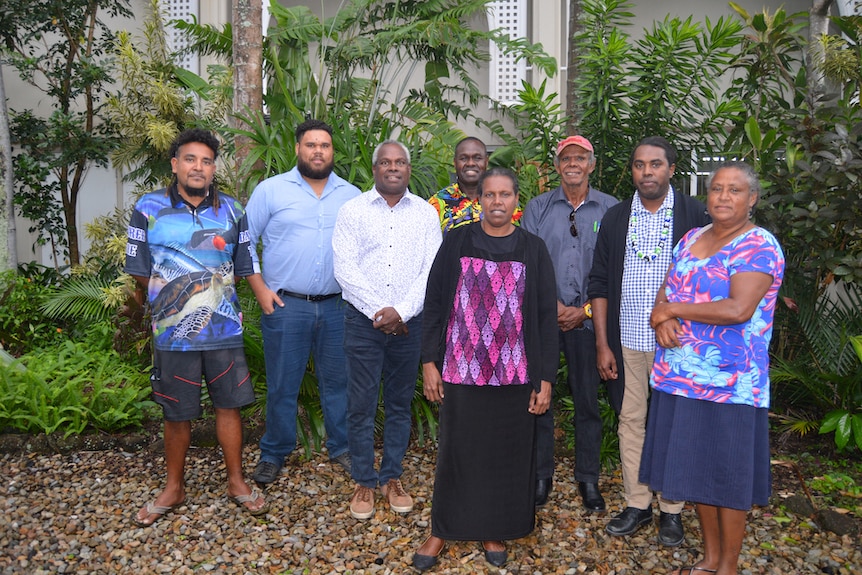
Climate change threatens up to 100% of trees in Australian cities, and most urban species worldwide
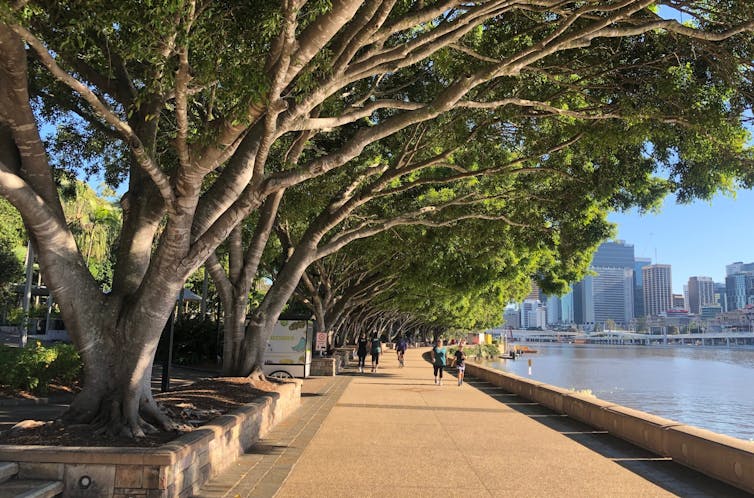
To anyone who has stepped off a hot pavement into a shady park, it will come as little surprise that trees (and shrubs) have a big cooling effect on cities.
Our study published today in Nature Climate Change found climate change will put 90-100% of the trees and shrubs planted in Australian capital cities at risk by 2050. Without action, two-thirds of trees and shrubs in cities worldwide will be at potential risk from climate change.
Increasing city temperatures mean their trees are becoming more important than ever. More than just shade umbrellas, the natural air-conditioning magic of trees happens as water moves up from the soil through their roots and evaporates out of their leaves into the air.
But how will the trees themselves cope with climate change as conditions shift beyond their natural tolerance limits for high temperatures or lack of water? Our team of scientists from Australia and France examined the impacts of temperature and rainfall changes projected for coming decades on 3,129 tree and shrub species planted in 164 cities across 78 countries.
About half of these urban tree and shrub species are already experiencing climate conditions beyond their natural tolerance limits.
These findings sound bleak – but read on. We have also identified steps people can take to help their local trees survive, thrive and keep on cooling.
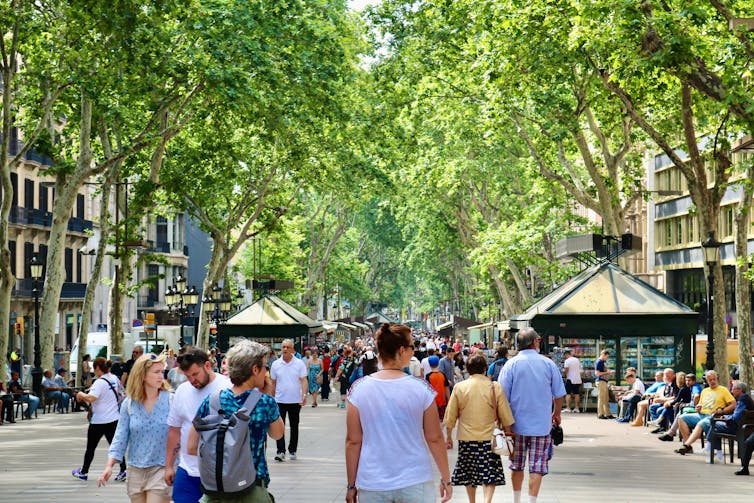
Risks In Australia Are Higher
In Australia, reduced rainfall will be the most common stress on urban trees, but increasing temperatures will also be a major factor, especially in Darwin.
By 2050, the proportion of urban tree species that might be at risk of projected temperature increases in Australian cities is very high. Among the major cities with inventories of urban plantings, those with high percentages at risk include: Cairns 82%, Melbourne 93%, Perth 95%, Hobart 95%, Sydney 96%, Canberra 98% and Darwin 100%.
Common native species, including manna gum, swamp gum, yellow box, narrow-leaved peppermint, blackwood and brush box, and well-loved introduced species, such as jacaranda, oaks, elms, poplars and silver birch, are among the trees that could be at risk in Australia.
By at risk, we mean these species might be experiencing stressful climatic conditions that could affect their health and performance. However, we could buffer the risk for these species by providing water or creating other microclimate conditions. Also, urban trees may exhibit plasticity in traits that govern survival, growth and environmental tolerance, which can help them to adapt to local environmental conditions.

More Than 1,000 Tree Species At Risk Globally
Worldwide, we found common species of cherry plums, oaks, maples, poplars, elms, pines, lindens, wattles, eucalypts and chestnuts are among more than 1,000 species that have been flagged at risk due to climate change in most cities where they occur.
Even more worryingly, the number of species affected, and the scale of the impacts, will increase markedly by 2050 as temperatures increase. These trends jeopardise the health and longevity of urban forests and the benefits they provide to society.

The United Nations predicts the world’s population will grow to around 8.5 billion by 2030, with more than half of those people living in cities. Climate change will further heat up the urban heat islands created by millions of people, vehicles and industries generating heat that’s retained among buildings and other infrastructure.
Urban trees have a vital role to play in keeping cities liveable. As they cool their surroundings, they reduce our electricity use for air conditioning, while also absorbing carbon dioxide, purifying the air, reducing city noise and providing wildlife habitat. They are also inherently beautiful, living things that underpin much of the biodiversity on Earth.
Being around their natural greenness also improves our mental health and well-being. Trees have helped us through stressful times such as pandemics.
However, when climatic conditions exceed the natural tolerance of trees, not only can this lead to poor tree health and limited growth, but it can also reduce their cooling effect and eventually lead to tree dieback. During drought or heat stress, trees can stop releasing water vapour from their leaves or shed leaves to reduce tissue damage. This means that at a time when we most need their natural air conditioning, they are more likely to be switching off.
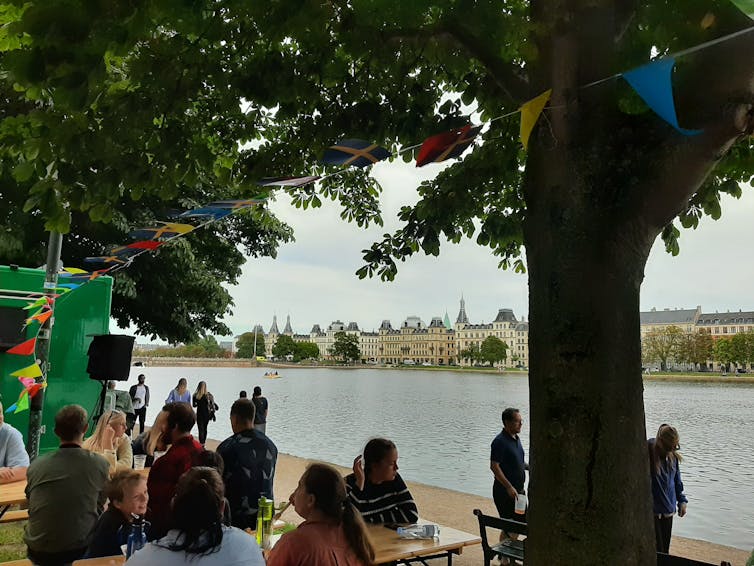
What Can We Do To Protect Our Trees?
Increasing the number of trees and shrubs in our cities, collectively called urban forests, is a key climate change adaptation and liveability strategy being used around the world. Until now, though, little information was available on whether or not current climatic conditions exceed what urban forests can stand, or how these conditions compare with projected changes in temperature and precipitation (drought, rain and snow) around the world.
Our study provides guidance to urban forest managers in 164 cities about which species might be at risk and should be monitored. It also identifies which species are likely to be resilient to climate change and so suitable for future plantings.
People can help urban forests to survive and keep providing their many benefits in a few simple ways:
1) reduced rainfall and soil moisture are a big threat to many species, so you can help rain soak into the ground to ensure precious water is not wasted down the drain – consider diverting water from your downpipe to a raingarden or a rainwater tank that trickle-feeds the garden (this also helps your local creek).
2) plant even more trees and shrubs, which helps to keep city temperatures comfortable for them and us – get advice from your local council or horticulturalists about suitable climate-resilient species for your area.
3) leave trees and shrubs in place – think twice before cutting down trees and shrubs, as they are providing you with more benefits than you realise.![]()
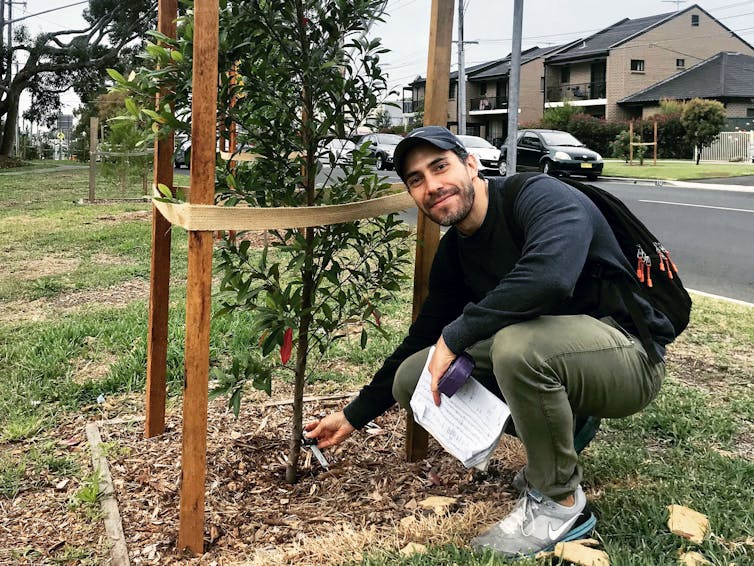
Manuel Esperon-Rodriguez, Lecturer and Research Fellow, Hawkesbury Institute for the Environment, Western Sydney University; Jaana Dielenberg, University Fellow, Charles Darwin University; Jonathan Lenoir, Senior Researcher in Ecology & Biostatistics (CNRS), Université de Picardie Jules Verne (UPJV); Mark G Tjoelker, Professor and Associate Director, Hawkesbury Institute for the Environment, Western Sydney University, and Rachael Gallagher, Associate Professor, Hawkesbury Institute for the Environment, Western Sydney University
This article is republished from The Conversation under a Creative Commons license. Read the original article.
Half of Western Sydney foodbowl land may have been lost to development in just 10 years
Nicky Morrison, Western Sydney University and Awais Piracha, Western Sydney UniversityMore and more farming land is being lost to other land uses such as housing on the outskirts of our cities. But how much land is being lost? And why does it matter?
Our newly published research used the Western Sydney region as a case study of land lost since the 2011 census, and newly released Australian Bureau of Statistic (ABS) data allowed us to update our findings. While changes in ABS land-use definitions make precise comparisons difficult, Western Sydney may have lost as much as 60% of its agricultural land over the past ten years.
The significance of these losses is that Western Sydney has long been seen as the foodbowl of Greater Sydney. It produces more than three-quarters of the total value of agricultural produce in the metropolitan region. The city relies heavily on Western Sydney for livestock, vegetables, eggs, grapes and nuts.
We also interviewed people from different tiers of government working in Western Sydney. Our study highlights growing tensions between the New South Wales government and its attempts to manage population growth and housing pressures, and local councils and their efforts to protect food production on the city outskirts. The loss of productive land around our major cities is an increasingly urgent issue for our food security.
Food Systems Under Pressure
Like many cities, Sydney is being hit by many shocks and stresses – drought, bushfires, storms, floods and the COVID-19 pandemic’s impacts on supply chains. This rapid succession of shocks tests the resilience of local food security. Communities face soaring food prices as part of a broader surge in costs of living.
A lack of political will, short-term election cycles with shifting priorities, and low public awareness have meant the importance of retaining farming land close to the city isn’t well understood. Perishable foods grown close to urban markets not only reduce transport and energy costs, and emissions, but also improve a city’s food security.
Our study quantifies the loss of land categorised as agricultural or primary production in Western Sydney over time. Based on ABS data for land use by mesh blocks (the smallest geographic areas defined by the ABS), we estimate Western Sydney lost 9% of its primary production land from 2016 to 2021. The worst-affected council areas over this period, The Hills Shire, Blacktown, Camden and Campbelltown, lost 43%, 39%, 26% and 19% respectively.
Changes in ABS mesh block land-use definitions (from “agriculture” in 2011 to “primary production” in 2016 and 2021), as well as changes to mapping standards, make it difficult to accurately calculate the loss of land between 2011 and 2021. However, if these land-use categories in 2011, 2016 and 2021 are assumed to be broadly comparable, we can estimate that Western Sydney lost roughly 60% of its farming land over the past ten years.
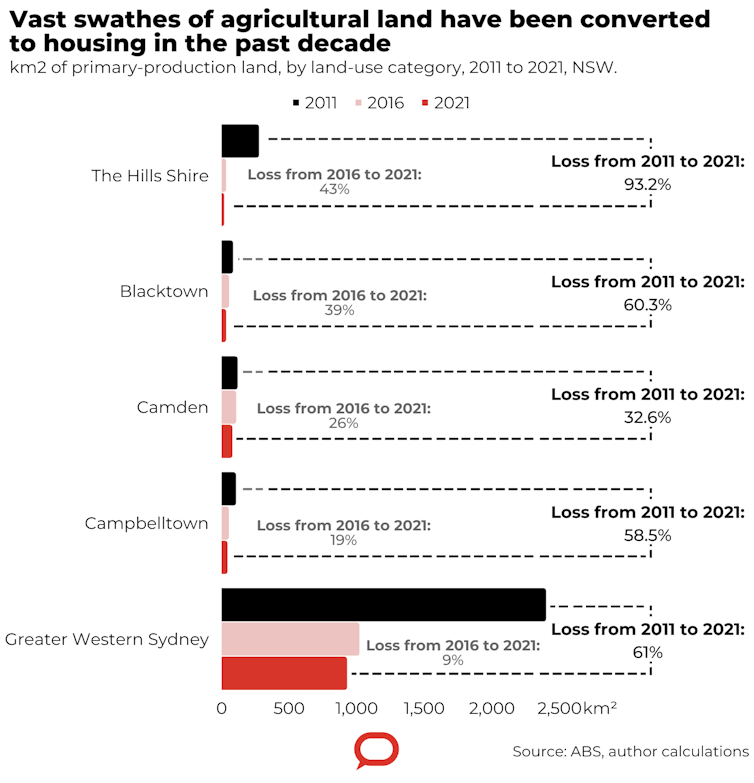
The Pressures Of Growth
The NSW government has historically looked to Western Sydney to accommodate Greater Sydney’s growing population.
The population in Western Sydney is estimated to increase from 2.4 million residents in 2016 to 4.1 million in 2041. The Department of Planning and Environment’s latest housing supply forecast predicts the region will supply roughly 60% of Greater Sydney’s new dwellings in the period 2021-2025.
Attempts have been made to concentrate new development in two designated growth areas – the North-West and South-West – from 2006 onwards. These locations used to contain swathes of undeveloped greenfield land. But local council policies to retain productive farmland have been put aside to accommodate state government growth plans.
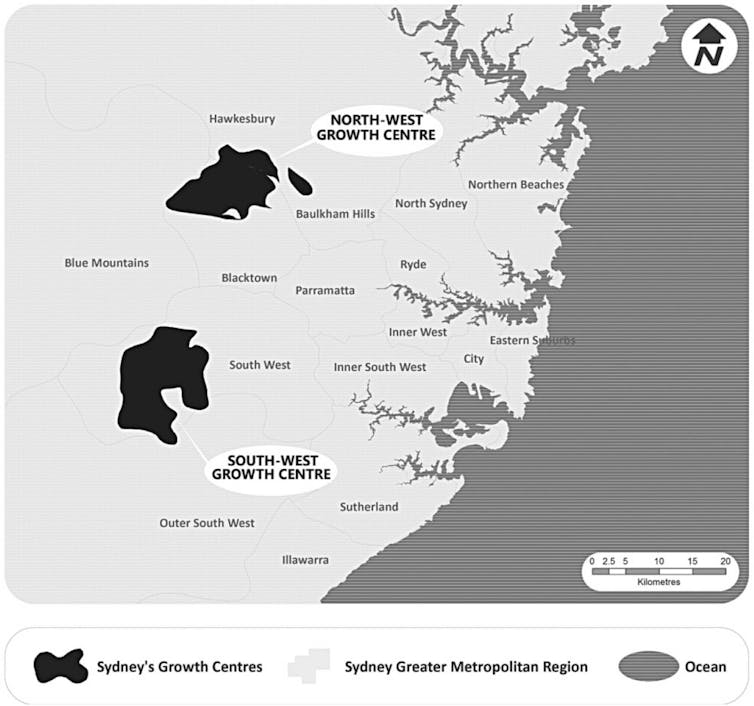
The Greater Sydney Commission (now the Greater Cities Commission) introduced the concept of Metropolitan Rural Areas (MRAs) to help preserve the remaining peri-urban rural land. The MRA is defined as the land uses outside the established and planned urban areas of Greater Sydney. It broadly comprises rural towns and villages, farmland, floodplains, defence land, national parks and wilderness areas.
Satellite imagery from our research reveals a slow but steady housing sprawl into surrounding rural land. Is the MRA concept too late to stem urban encroachment?
Why Are Farmers Selling Up?
Why is farming land disappearing? Part of the answer lies in the cost-price squeezes farmers face. Costs of farming inputs have risen, while farmgate prices have fallen because of pressure from major retailers and competition.
As the cost of land and farming costs increase, low returns mean many farmers consider selling up to capitalise on land speculation. We estimate price differences between rural and residential land plots of up to 200% in Western Sydney (using the NSW Valuer General online tools).
The potential value uplift is a big incentive for farmers to approach the council and seek land rezoning to convert their rural holdings to more profitable land uses, such as housing and other urban uses. It makes financial sense. Who can blame them?
Local Food Production Has Been Undervalued
Our study suggests some questioning of a pro-urban growth agenda has begun. There is growing recognition of the importance of preserving agricultural and rural land on the outskirts of our major cities to help us withstand and recover from crises.
We are seeing shortages of essential items, supply-chain disruptions and rises in the prices of foods affected by climate-related events. These developments highlight the need to reduce dependence on distant food supplies.
Australian cities must find ways to maximise the sustainable use of available natural resources for more localised food production. We should also consider more carefully the role that farming land plays in other land-use functions, including flood mitigation.
Amy Lawton, consultant in the advisory team at the Institute for Public Policy and Governance at UTS, was a co-author of this article, and of the journal publication while at WESTIR Ltd.![]()
Nicky Morrison, Professor of Planning and Director of Urban Transformations Research Centre, Western Sydney University and Awais Piracha, Associate Professor of Urban Planning, Director Academic Programs, Geography Tourism and Urban Planning, Western Sydney University
This article is republished from The Conversation under a Creative Commons license. Read the original article.
We helped fill a major climate change knowledge gap, thanks to 130,000-year-old sediment in Sydney lakes
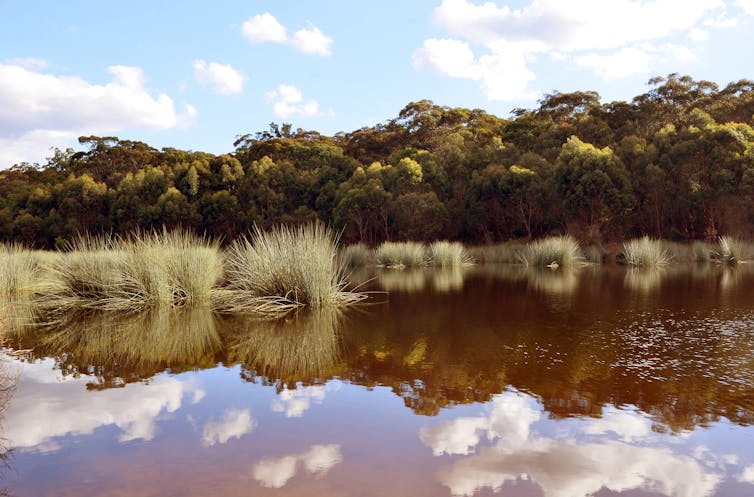
Plants capture around half the carbon we emit by burning fossil fuels, making them a crucial part of mitigating climate change. But carbon is often released back into the atmosphere when plants die, decompose and eventually turn into dirt.
Carbon is only permanently removed from the atmosphere if it’s stored in sediments that accumulate at the bottom of oceans, lakes, reservoirs, or in peat bogs.
Our latest research on the Thirlmere Lakes near Sydney aimed to find out how trees, shrubs and soils in Australia’s eastern tablelands responded to climate changes over the last 130,000 years. The key question we sought to answer was whether carbon stored in Australia’s trees, shrubs, and soils contribute to the pool of carbon stored safely in lake sediment.
The answer, we determined, depends on a number of crucial factors, and erosion plays an essential, previously neglected, part.
Erosion is like a conveyer belt for carbon – it transports carbon to the lake from nearby hills where plants die. We found when the climate near Sydney was warm and wet, then trees and shrubs flourished and erosion was reduced. So while more carbon was stored in plants, it took longer for carbon in soil to be safely buried in the lake.
Previous research has shown ignoring the impact of erosion on carbon burial has caused Australia to overestimate the amount of carbon emitted into the atmosphere over the last 50 years, by a staggering 40%.
The Cycle Of Carbon
Plants capture carbon dioxide from the atmosphere during photosynthesis, and store carbon in their tissue. So what happens when plants die?
The equation is easier for the oceans: dead phytoplankton (tiny algae floating close to the surface) sinks to seafloor, where most of its captured carbon is stored safely far away from the atmosphere. On land things are more complex.
When trees and shrubs die, they cover the surface, decompose and become part of the soil. In fact, 80% of carbon on land is stored in soils. Decomposition releases some of the captured carbon back into the atmosphere, unless they’re buried deep.
In Australia, much more carbon is stored when weather conditions are wetter. During the strong La Niña event of 2010-2012, large areas of the Australia’s dry interior and temperate landscape experienced significant “greening”.
Research shows 20% more carbon was captured from the Earth’s atmosphere during this La-Niña event due to increasing plant growth. Australia contributed more than half of this.
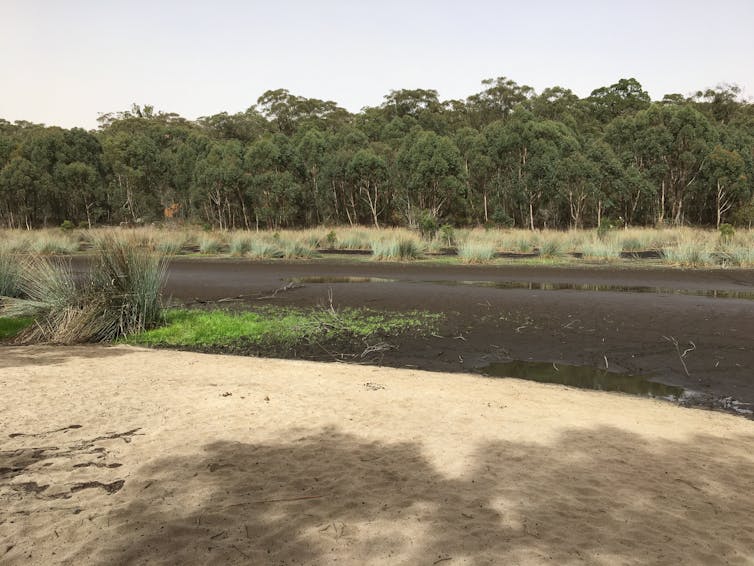
The Last 130,000 Years
The story is even more dramatic if you look back at the last 130,000 years. During this time, the planet experienced cycles of two climate phenomena: glacial periods and interglacial periods.
A “glacial” period is characterised by much colder and drier conditions, when wide parts of northern Europe, Eurasia, and America were covered by ice kilometres thick. The last time it peaked was around 21,000 years ago.
Australia endured warmer and wetter conditions during “interglacial” periods, which peaked around 125,000 years ago and again over the last 11,600 years.
For our research, we drilled deep into Sydney’s Thirlmere Lake mud, and pulled up long columns of sediment containing traces of vegetation, climate, and erosion from the last 130,000 years. We observed significant changes in the types of vegetation growing in the catchment over this time.
Shrubs and large trees such as eucalypts flourished during warmer and wetter interglacial periods. They were less abundant when it was colder and dry during glacial periods, when grass and herbs became more common.
Large trees capture more carbon dioxide from the atmosphere than grasses and herbs. And this captured carbon then accumulates in the surface of soils when the plant dies.
But how is the soil-carbon transported from the slopes where the trees and shrubs grow, to the bottom of the lake?
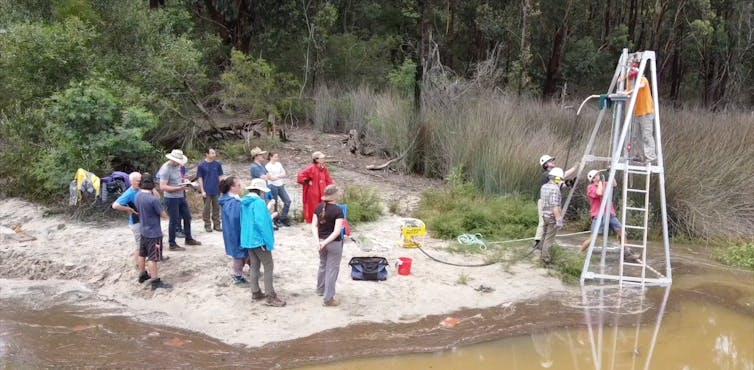
Soil Erosion
Erosion – whether gravity, water or wind - forms our landscape and is essential for the accumulation of soil carbon in lakes, reservoirs and the oceans.
The deeper the carbon is buried in the sediments of these reservoirs, the more efficiently it is locked away from the atmosphere. In contrast, the longer it remains on the slopes and in soils close to the surface, the more it decomposes, and carbon dioxide is released back into the atmosphere.
For the wider Sydney region, more plant growth occurred during the interglacial period, which take up vast amounts of carbon dioxide from the atmosphere. But this may be offset by decreased erosion. And indeed, our data suggests decreased erosion during interglacial periods.
This decreased erosion is because of the protection of trees which, for example, stabilise the soil with their roots. Indeed, we found tree cover slows the rate that soil carbon moves from slope to lake by nearly 10 times.
This means there’s much more time for soils to decompose on the slope, and to release carbon back into the atmosphere.
Nevertheless, we still recorded significantly higher carbon storage in lake sediments during warmer and wetter periods, thanks largely to the greater growth of trees and shrubs compared to grasses, which are more abundant during interglacial periods. This compensates for the reduced erosion.
We also found the lake transformed into a productive wetland during warm periods. This means more carbon is also captured by plants growing in the lake.
What Will Happen Under Climate Change?
The interplay between climate, vegetation, and erosion is difficult to quantify. Our research fills a critical gap in knowledge, as climate models currently don’t account for soil-carbon erosion.
Those models assume all soil-carbon is eventually emitted back into the atmosphere, introducing uncertainties into climate predictions.

Future climate change may raise the risk of the Thirlmere Lakes drying out, which means the sediments will be exposed, which promotes decomposition. This means the previously stored carbon will be emitted back into the atmosphere as carbon dioxide.
Extreme aridity may also reduce terrestrial plant growth, as it did during the millennium drought.
Further, destruction of vegetation by severe bushfires reduce biomass yield to the wetlands. Preserving Australia’s unique native terrestrial vegetation and wetlands is therefore essential to sustain the continent’s role in the global carbon cycle.![]()
Alexander Francke, Research Fellow, University of Adelaide; Anthony Dosseto, Professor, University of Wollongong; Haidee Cadd, Research associate, University of Wollongong, and Tim Cohen, Associate Professor and ARC Future Fellow, University of Wollongong
This article is republished from The Conversation under a Creative Commons license. Read the original article.
In a win for Traditional Owners, Origin is walking away from the Beetaloo Basin. But the fight against fracking is not over
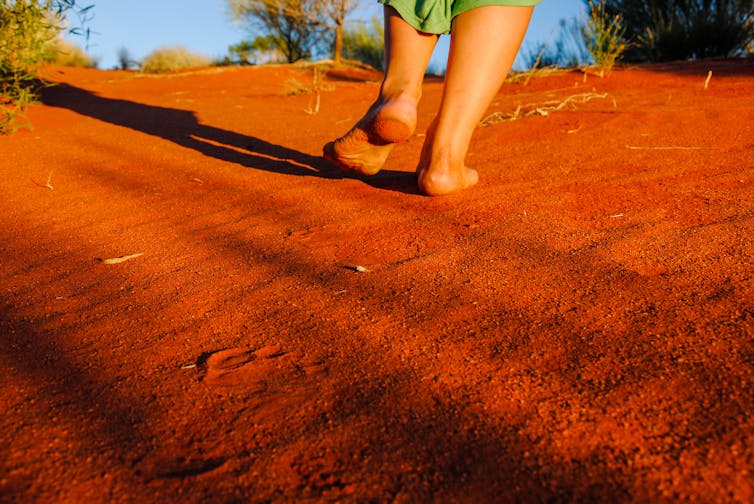
What a difference six months makes. Before the federal election, the Beetaloo Basin in the Northern Territory was to have spearheaded Australia’s “gas-led recovery”. But Origin Energy this week announced it would sell its share of the basin project ahead of a wider exit from new gas ventures.
The Beetaloo Basin holds a truly enormous amount of fossil carbon – prompting Greens leader Adam Bandt to describe it as a “climate bomb”.
Origin’s exit is not a killing blow to the controversial project. But it shows increasing corporate jitters about investing in gas. And the announcement came as major iron miner Fortescue announced plans to eliminate fossil fuel use within eight years.
Origin’s exit is a major win for the region’s Traditional Owners, many of whom feared the fracking would cause large-scale environmental damage, as well as harming the climate. But Origin has sold its rights to frack Beetaloo – so the fight is far from over.

What Is This Basin And Why Does It Matter?
Oil and gas are usually found in geological basins – large, low-lying areas filled with rocks and sediment. The Beetaloo Basin covers 28,000 square kilometres and lies around 500 kilometres south-east of Darwin. Origin’s former exploration area lies near the town of Daly Waters.
Fracking the basin has been planned since 2004. The former Morrison Coalition government planned a so-called “gas led recovery” to accelerate its development, fuelled by large amounts of taxpayer money to encourage the fossil fuel industry to frack the remote area.
The move was unpopular with the region’s Traditional Owners, with fracking described by Traditional Owner Ned Jampijinpa Hargraves as “digging up my body, breaking my Tjukurpa (Dreaming)” in a government inquiry.
Local Traditional Owners formed the Nurrdalinji Native Title Aboriginal Corporation to fight fracking, in partnership with local pastoralists.
Origin’s statement makes no mention of these tensions in its decision. Indeed, it talks of “strong support” from the local community, including native title holders.
Despite this rhetoric, the work by Traditional Owners and pastoralists created enormous pressure for Origin to back out of the project.
This win demonstrates yet again how Indigenous people around the world are playing a key role in warding off the worst of the climate crisis.
This occurs not only when Indigenous people oppose fossil fuel projects on their land, but through their management of 38 million square kilometres of land across 87 countries.
This is an enormous estate – one quarter of the Earth’s land surface – and often covers land rich in biodiversity.
Australia’s First Nations peoples hold rights and interests in land covering about 40% of the continent, again land that has been sustainably managed by First Nations peoples for thousands of years and is therefore highly environmentally valuable.
Land management is central to combating climate change, through nature-based solutions such as storing carbon in trees, soils and mangroves and seagrass meadows. First Nations communities have at least 60,000 years of knowledge of how to care for Country in ways which can aid climate adaptation, mitigation and repair.
What Next?
Origin has sold its rights to a company half-owned by Tamboran Resources Limited.
Under the previous Coalition government, Tamboran subsidiary Sweetpea Petroleum received A$7.5 million of public money to drill exploration wells in the Beetaloo. Tamboran and Sweetpea refused to appear at a 2021 Senate inquiry into oil and gas activities in the Beetaloo Basin – a move the Senate committee declared was “unacceptable”.
Tamboran is now trying to raise $133 million to pay Origin for the rights and invest the rest in developing the project.
As the International Energy Agency has warned, we cannot open new fossil fuel projects if we hope to limit global temperature rise to the crucial 1.5℃ threshold.
For more than a decade, climate activists have called on institutions to divest themselves of their fossil fuel holdings. Origin has divested itself of Beetaloo and BHP is divesting its oil and gas portfolio.
But these are not true victories for the climate if the fossil fuel assets are sold to be extracted and burned by another company.
Keeping It In The Ground
If we are serious about saving our planet we need to legislate to close down fossil fuel assets and force shareholders and investors to cop the losses.
In selling its share, Origin has taken an estimated loss of up to $90 million. But the fight against fracking in the Beetaloo is not over.
Still, it’s important to recognise what’s been achieved. As Johnny Wilson, Chair of Nurrdalinji Corporation said:
We hope this is the start of more companies turning their back on gas production where we live. Fracking is not what we want … The government should give up backing the industry with taxpayers’ money and invest in health, education and clean energy from the sun because that’s what will keep our future strong.
Lily O'Neill, Senior Research Fellow, The University of Melbourne and Ben Neville, A/Prof and Deputy Director of Melbourne Climate Futures, The University of Melbourne
This article is republished from The Conversation under a Creative Commons license. Read the original article.
Dugongs and turtles are starving to death in Queensland seas – and La Niña’s floods are to blame
Kathy Ann Townsend, University of the Sunshine CoastTo rescue a turtle, University of the Sunshine Coast PhD candidate Caitlin Smith half-swam, half-crawled across mud on an inner tube. She tied a harness around its chest and front flippers, so the rest of the team could carefully pull it to safety. It was just one of 15 sick green turtles our team discovered in recent weeks in the Great Sandy Strait near Queensland’s Hervey Bay.
It’s not just turtles struggling at the moment. A dead dugong was found nearby, while another emaciated dugong was found still alive up the Noosa River.
They’re starving. Huge rains and floods have washed large quantities of sediment out to sea, where it smothers the seagrass these marine creatures rely on. There’s no relief in sight, as we enter our third wet year of La Niña.
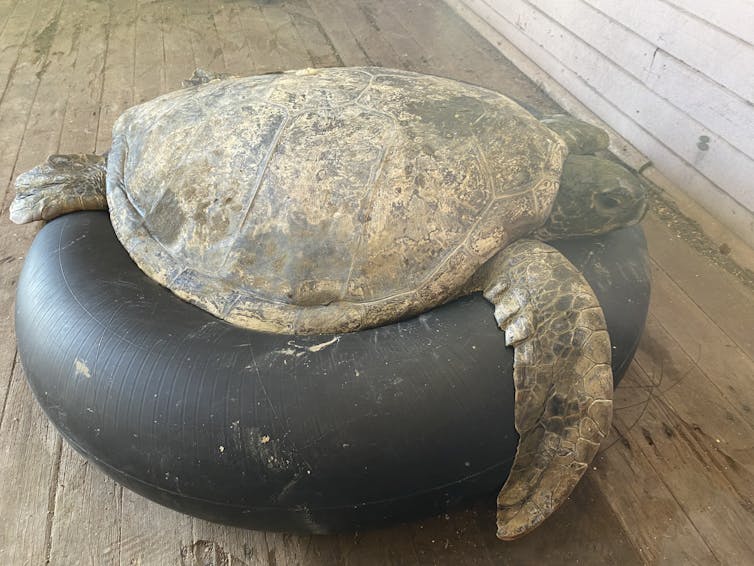
Why Is This Happening?
Most of the sick sea turtles we found – as well as those found by Queensland’s Department of Environment and Science team – showed signs of starvation and illness, including the newly identified soft shell disease.
What lies behind these deaths are the rains and floods brought by La Nina.
Like much of New South Wales and Queensland, the Great Sandy Strait has been heavily hit by flooding this year, with three major floods engorging the Mary River. Floodwaters have carried huge amounts of sediment into Hervey Bay, reducing the water quality and flushing pollutants into sea turtle and dugong habitat.
In normal years, sediment from rivers brings a flush of nutrients, which can actually cause a seagrass boom once the water quality improves. The problem is, there’s been just too much sediment. With one La Niña after another, it’s been harder for seagrass to recover or regrow.
As sediment from the floods spread out over the shallow seas, it made the water murkier. Soon, sunlight couldn’t penetrate the gloom to reach the seagrass meadows. Worse, floods release a cocktail of chemicals, including pesticides and herbicides, unintentionally washed down from farms and inundated townships.
The result has been widespread devastation in the Great Sandy Straits region. In May this year, a James Cook University team surveyed 2,300 square kilometres across the region and found almost no seagrass left in waters ranging from 1 metre to 17 metres.
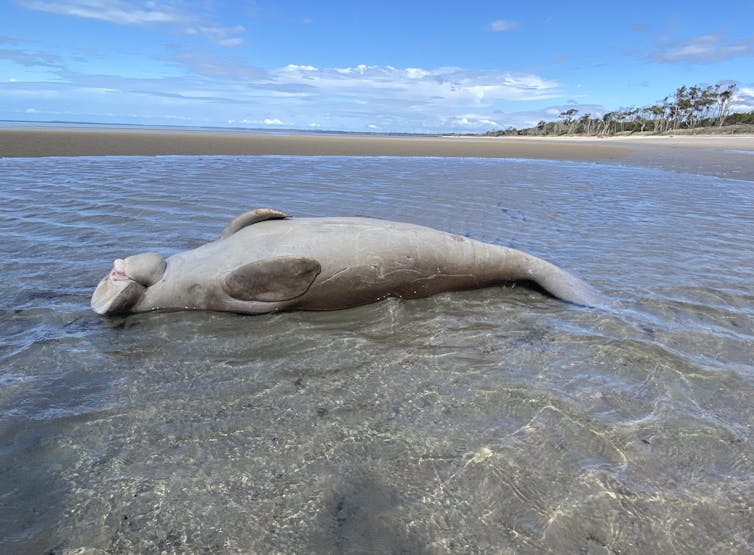
Green sea turtles and dugongs are the grazers of the Australian seas and rely heavily on seagrass. In good years, they drift over these lush meadows of seagrass – which resemble grassy fields on land – eating as they go.
Summers are when our seagrass meadows usually flourish, letting turtles and dugong fatten up for the winter. During winter, seagrass naturally dies back. This year, local sea turtles and dugongs went into winter in poor condition, having missed out on fattening up during the summer season.
That’s why we’re seeing so many sick or dying animals. From January 1 to August 31 this year, volunteers from Turtles in Trouble Rescue have taken 91 sea turtles from the region to the nearest wildlife hospital, 300 kilometres away. By contrast, in 2019, before the La Niña cycle began, the group had only 12 transports.
Is There Nowhere Else They Can Get Food From?
In flood-affected areas, turtles and dugongs have only two choices: move away, or try eating something else.
During the large 2010 floods, dugongs from Hervey Bay were found more than 200 kilometres south in Moreton Bay, offshore from Brisbane. Unfortunately, their migration didn’t leave them much better off – the seagrass in Moreton Bay had been hit by Brisbane River sediment. But we do know some survived.
Others were found dead, washed up 900 kilometres south after trying to find food and failing. Turtles can migrate too, but they’re often so weak from starvation that disease and parasites that they die before finding an alternative food source.

What about finding something else to eat? When our team analysed the stomachs of dead sea turtles from the Hervey Bay region, we found many were full of mangrove leaves.
Unfortunately, these trees have a range of natural toxins designed to stop animals eating them, such as the toxic sap of the milky mangrove. Worse, as the “kidneys of the coast”, mangroves use their leaves to store concentrated salt and toxins such as heavy metals. In short, this diet is no substitute.
Is This Part Of A Natural Cycle Of Boom And Bust?
While turtles and dugongs do have natural variation in their populations over time – and often due to food availability – there are limits. Turtles and dugongs cannot respond to climate-induced pressures the same way fast-breeding mice can.
Female green sea turtles have to be 30 to 40 years old before they can begin to reproduce. They only undertake their long migrations to breed every three to eight years. They lay over 1,000 eggs in the hope just one hatchling will survive the perilous seas long enough to hit reproductive age.
Dugongs, meanwhile, only raise a single calf every three to seven years. These reproductive strategies make it very difficult to respond to fast changes to their environments.
Successive lean years caused by back-to-back La Niña events will hit both the survival rate and reproductive ability of these animals.
Sea turtles in poor condition will not be able to migrate successfully, which means they’re heading for a poor nesting season. Dugongs, too, will struggle. Without stores of fat, the females won’t be able to support their calves through to weaning stage. That will make it harder to replenish the population and recover from losses from starvation or relocation. We won’t know the full impact of this event until years from now.

In response to the crisis, local volunteers have stepped up. The Turtles in Trouble Rescue group has gone from five to 50 trained members, and are working with the University of the Sunshine Coast to create a sea turtle rehabilitation centre in the area. We’ll be better prepared for the next flooding event. ![]()
Kathy Ann Townsend, Senior Lecturer in Animal Ecology, University of the Sunshine Coast
This article is republished from The Conversation under a Creative Commons license. Read the original article.
Young cold-blooded animals are suffering the most as Earth heats up, research finds
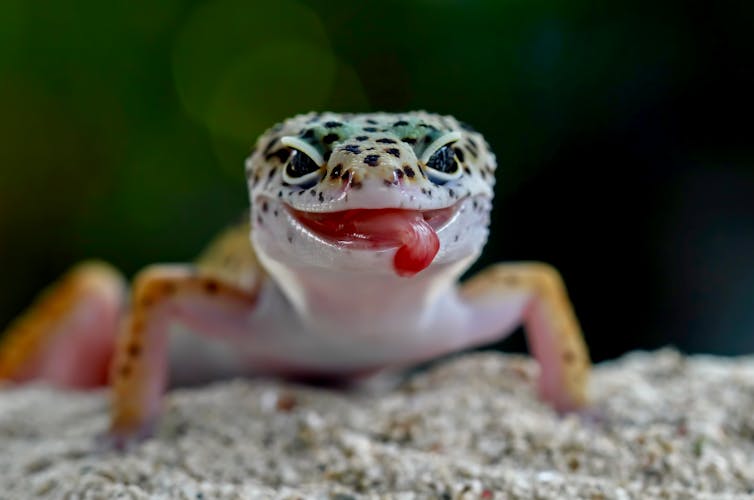
Climate change is making heatwaves worse. Many people have already noticed the difference – and so too have other animals.
Sadly, research by myself and colleagues has found young animals, in particular, are struggling to keep up with rising temperatures, likely making them more vulnerable to climate change than adults of their species.
The study focused on “ectotherms”, or cold-blooded animals, which comprise more than 99% of animals on Earth. They include fish, reptiles, amphibians and insects. The body temperature of these animals reflects outside temperatures – so they can get dangerously hot during heat waves.
In a warming world, a species’ ability to adapt or acclimatise to temperatures is crucial. Our study found that young ectotherms, in particular, can struggle to handle more heat as their habitat warms up. That may have dramatic consequences for biodiversity as climate change worsens.
Our findings are yet more evidence of the need to urgently reduce greenhouse gas emissions to prevent catastrophic global heating. Humans must also provide and retain cool spaces to help animals navigate a warmer future.
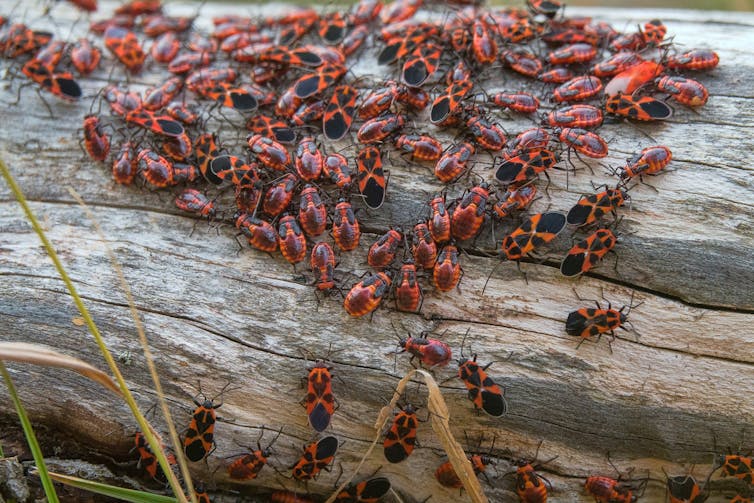
Tolerating Heat In A Changing Climate
The body temperature of ectotherms is extremely variable. As they move through their habitat, their body temperature varies according to the outside conditions.
However, there’s only so much heat these animals can tolerate. Heat tolerance is defined as the maximum body temperature ectotherms can handle before they lose functions such as the ability to walk or swim. During heat waves, their body temperature gets so high they can die.
Species, including ectotherms, can adapt to challenges in their environment over time by evolving across generations. But the rate at which global temperatures are rising means in many cases, this adaptation is not happening fast enough. That’s why we need to understand how animals acclimatise to rising temperatures within a single lifetime.
Unfortunately, some young animals have little to no ability to move and seek cooler temperatures. For example, baby lizards inside eggs cannot move elsewhere. And owing to their small size, juvenile ectotherms cannot move great distances.
This suggests young animals may be particularly vulnerable during intense heat waves. But we know very little about how young animals acclimatise to high temperatures. Our research sought to find out more.
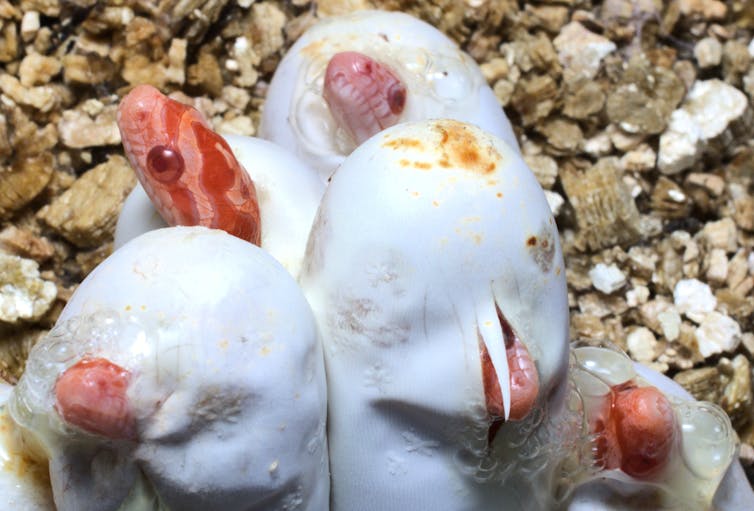
Young Animals At Risk
Our study drew on 60 years of research into 138 ectotherm species from around the world.
Overall, we found the heat tolerance of embryos and juvenile ectotherms increased very little in response to rising temperatures. For each degree of warming, the heat tolerance of young ectotherms only increased by an average 0.13℃.
The physiology of heat acclimatisation in animals is very complex and poorly understood. It appears linked to a number of factors such as metabolic activity and proteins produced by cells in response to stress.
Our research showed young land-based animals were worse at acclimatising to heat than aquatic animals. This may be because moving to a cooler temperature on land is easier than in an aquatic environment, so land-based animals may not have developed the same ability to acclimatise to heat.
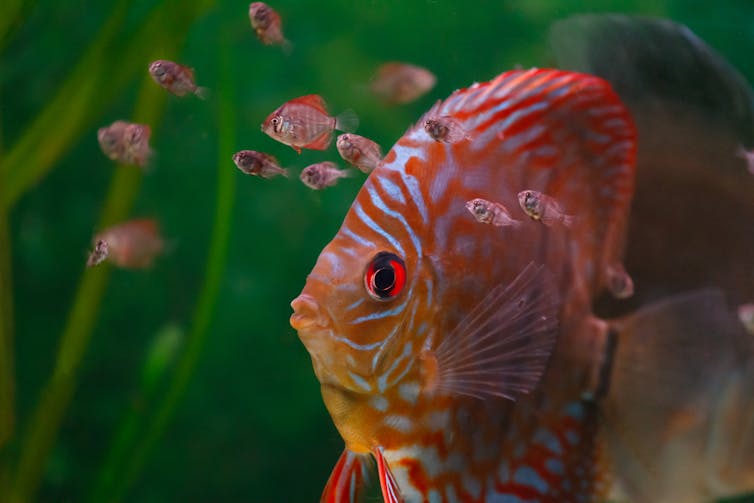
Heat tolerance can vary within a species. It can depend on what temperatures an animal has experienced during its lifetime and, as such, the extent to which it has acclimatised. But surprisingly, our research found past exposure to high temperatures does not necessarily help a young animal withstand future high temperatures.
Take, for example, Lesueur’s velvet gecko which is found mostly along Australia’s east coast. Research shows juveniles from eggs incubated in cooler nests (23.2℃) tolerated temperatures up to 40.2℃. In contrast, juveniles from warmer nests (27℃) only tolerated temperatures up to 38.7℃.
Those patterns can persist through adulthood. For example, adult male mosquito fish from eggs incubated to 32℃ were less tolerant to heat than adult males that experienced 26℃ during incubation.
These results show embryos are especially vulnerable to extreme heat. Instead of getting better at handling heat, warmer eggs tend to produce juveniles and adults less capable of withstanding a warmer future.
Overall, our findings suggest young cold-blooded animals are already struggling to cope with rising temperatures – and conditions during early life can have lifelong consequences.
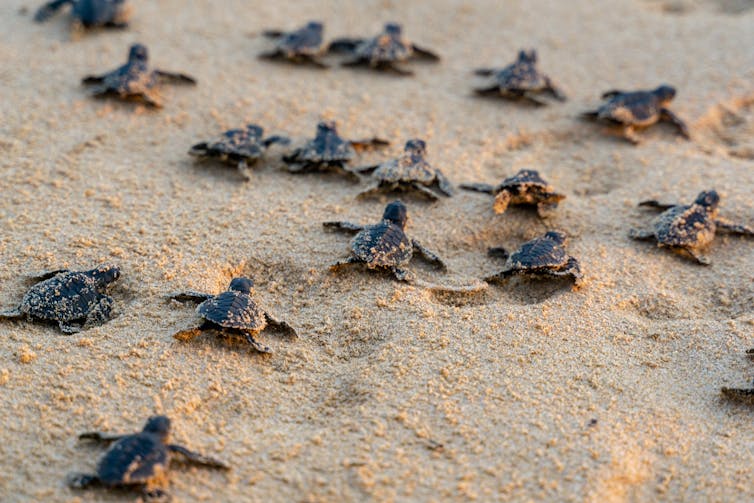
What’s Next?
To date, most studies on the impacts of climate change have focused on adults. Our research suggests animals may be harmed by heatwaves long before they reach adulthood – perhaps even before they’re born.
Alarmingly, this means we may have underestimated the damage climate change will cause to biodiversity.
Clearly, it’s vitally important to limit global greenhouse gas emissions to the extent required by the Paris Agreement.
But we can also act to protect species at a finer scale – by conserving habitats that allow animals to find shade and shelter during heatwaves. Such habitats include trees, shrubs, burrows, ponds, caves, logs and rocks. These places must be created, restored and preserved to help animals prosper in a warming world.![]()
Patrice Pottier, PhD Candidate in Ecology and Evolutionary Biology, UNSW Sydney
This article is republished from The Conversation under a Creative Commons license. Read the original article.
Pando In Pieces: Understanding The New Breach In The World's Largest Living Thing
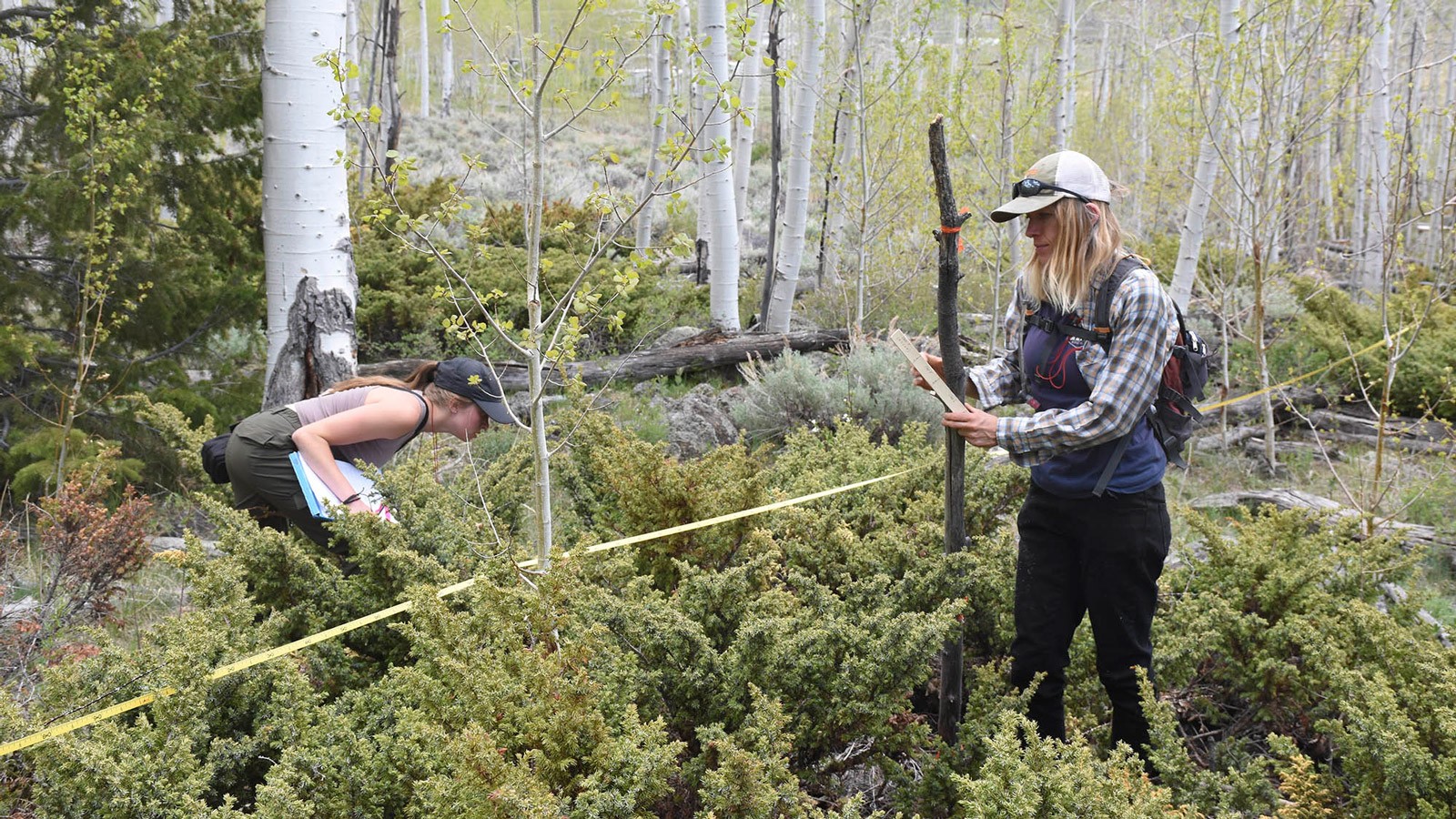
From crumbling rock art to exposed ancestral remains, climate change is ravaging our precious Indigenous heritage
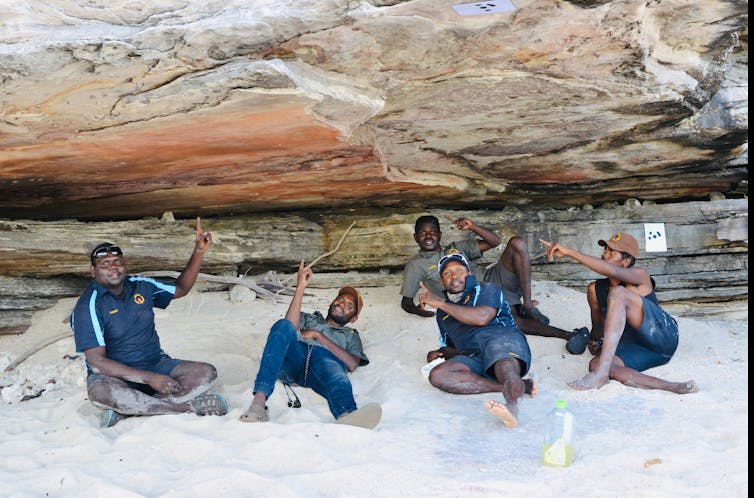
Climate change is rapidly intensifying. Amid the chaos and damage it wreaks, many precious Indigenous heritage sites in Australia and around the world are being destroyed at an alarming rate.
Sea-level rise, flooding, worsening bushfires and other human-caused climate events put many archaeological and heritage sites at risk. Already, culturally significant Indigenous sites have been lost or are gravely threatened.
For example, in Northern Australia, rock art tens of thousands of years old has been destroyed by cyclones, bushfires and other extreme weather events.
And as we outline below, ancestral remains in the Torres Strait were last year almost washed away by king tides and storm surge.
These examples of loss are just the beginning, unless we act. By combining Indigenous Traditional Knowledge with Western scientific approaches, communities can prioritise what heritage to save.
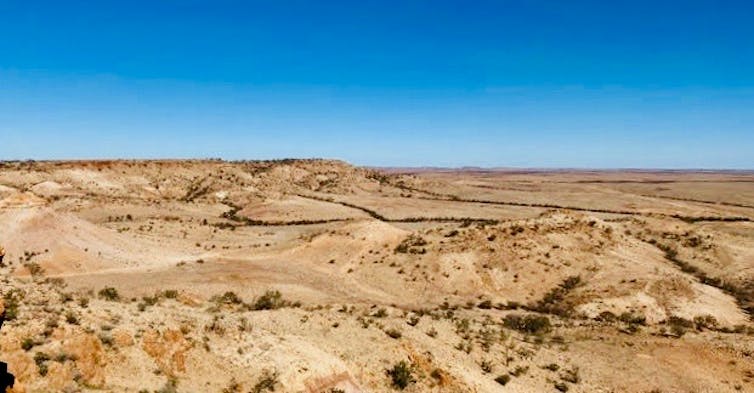
Indigenous Heritage On The Brink
Indigenous Australians are one of the longest living cultures on Earth. They have maintained their cultural and sacred sites for millennia.
In July, Traditional Owners from across Australia attended a workshop on disaster risk management at Flinders University. The participants, who work on Country as cultural heritage managers and rangers, hailed from as far afield as the Torres Strait Islands and Tasmania.
Here, three of these Traditional Owners describe cultural heritage losses they’ve witnessed, or fear will occur in the near future.
- Enid Tom, Kaurareg Elder and a director of Kaurareg Native Title Aboriginal Corporation:
Coastal erosion and seawater inundation have long threatened the Torres Strait. But now efforts to deal with the problem have taken on new urgency.
In February last year, king tides and a storm surge eroded parts of a beach on Muralug (or Prince of Wales) Island. Aboriginal custodians and archaeologists rushed to one site where a female ancestor was buried. They excavated the skeletal remains and reburied them at a safe location.
It was the first time such a site had been excavated at the island. Kaurareg Elders now worry coastal erosion will uncover and potentially destroy more burial sites.
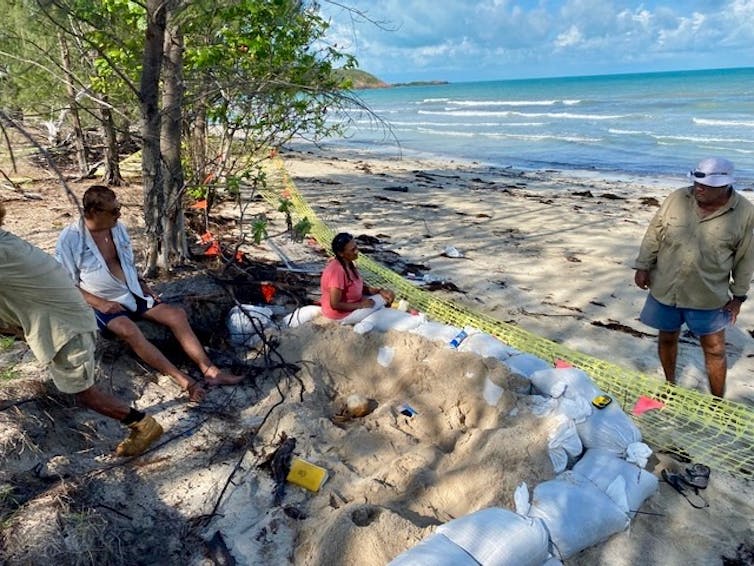
- Marcus Lacey, Senior Gumurr Marthakal Indigenous Ranger:
The Marthakal Indigenous Protected Area covers remote islands and coastal mainland areas in the Northern Territory’s North Eastern Arnhem Land. It has an average elevation of just one metre above sea level, and is highly vulnerable to climate change-related hazards such as severe tropical cyclones and sea level rise.
The area is the last remnant of the ancient land bridge joining Australia with Southeast Asia. As such, it can provide valuable information about the first colonisation of Australia by First Nations people.
It is also an important place for understanding contact history between Aboriginal Australians and the Indonesian Maccassans, dating back some 400 years.
What’s more, the area provides insights into Australia’s colonial history, such as Indigenous rock art depicting the ships of British navigator Matthew Flinders. Sea level rise and king tides mean this valuable piece of Australia’s history is now being eroded.
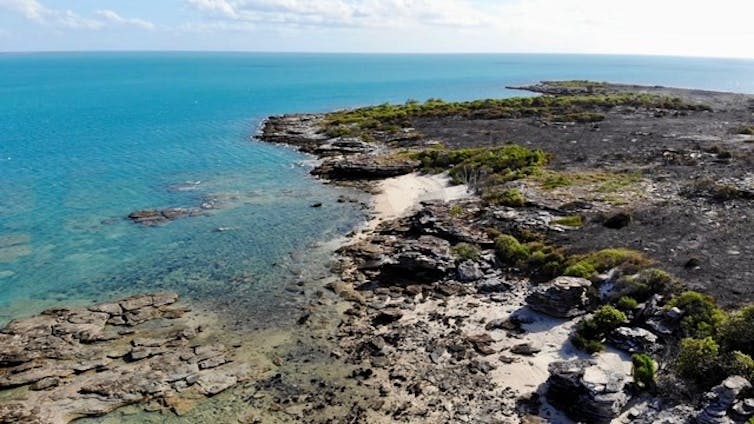
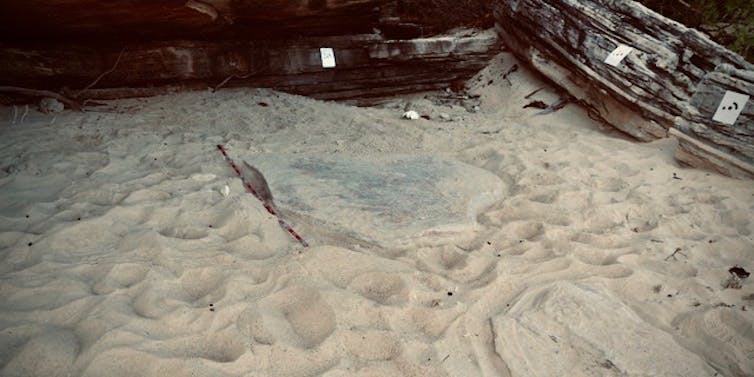
- Shawnee Gorringe, operations administrator at Mithaka Aboriginal Corporation:
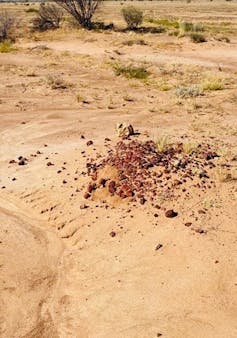
On Mithaka land, in remote Queensland, lie important Indigenous heritage sites such as stone circles, fireplaces and examples of traditional First Nations water management infrastructure.
But repeated drought risks destroying these sites – a threat compounded by erosion from over-grazing.
To help solve these issues, we desperately need Indigenous leadership and participation in decision-making at local, state and federal levels. This is the only way to achieve a sustainable future for environmental and heritage protection.
Mithaka Aboriginal Corporation general manager Joshua Gorringe has been invited to the United Nations’ COP27 climate conference in Egypt in November. This is a step in the right direction.
So What Now?
The loss of Indigenous heritage to climate change requires immediate action. This should involve rigorous assessment of threatened sites, prioritising those most at risk, and taking steps to mitigate damage.
This work should be undertaken not only by scientists, engineers and heritage workers, but first and foremost by the Indigenous communities themselves, using Traditional Knowledge.
Last year’s COP26 global climate conference included a climate heritage agenda. This allowed global Indigenous voices to be heard. But unfortunately, Indigenous heritage is often excluded from discussions about climate change.
Addressing this requires doing away with the usual “top down” Western, neo-colonial approach which many Indigenous communities see as exclusive and ineffective. Instead, a “bottom up” approach should be adopted through inclusive and long-term initiatives such as Caring for Country.
This approach should draw on Indigenous knowledge – often passed down orally – of how to manage risk. This should be combined with Western climate science, as well as the expertise of governments and other organisations.
Incorporating Indigenous knowledge into cultural heritage policies and procedures will not just improve heritage protection. It would empower Indigenous communities in the face of the growing climate emergency.![]()
Anna M. Kotarba-Morley, Senior Lecturer in Archaeology, Flinders University; Enid Tom, Kaurareg Elder and director of Kaurareg Native Title Aboriginal Corporation, Indigenous Knowledge; Marcus Lacey, Senior Gumurr Marthakal Indigenous ranger, Indigenous Knowledge, and Shawnee Gorringe, Manager at Mithaka Aboriginal Corporation, Indigenous Knowledge
This article is republished from The Conversation under a Creative Commons license. Read the original article.
What if carbon border taxes applied to all carbon – fossil fuels, too?

The European Union is embarking on an experiment that will expand its climate policies to imports for the first time. It’s called a carbon border adjustment, and it aims to level the playing field for the EU’s domestic producers by taxing energy-intensive imports like steel and cement that are high in greenhouse gas emissions but aren’t already covered by climate policies in their home countries.
If the border adjustment works as planned, it could encourage the spread of climate policies around the world. But the EU plan, as well as most attempts to evaluate the impact of such policies, is missing an important source of cross-border carbon flows: trade in fossil fuels themselves.
As energy analysts, we decided to take a closer look at what including fossil fuels would mean.
In a newly released paper, we analyzed the impact and found that including fossil fuels in carbon border adjustments would significantly alter the balance of cross-border carbon flows.
For example, China is a major exporter of carbon-intensive manufactured goods, and its industries will face higher costs under the EU border adjustment if China doesn’t set sufficient climate policies for those industries. But when fossil fuels are considered, China becomes a net carbon importer, so setting its own comprehensive border adjustment could be to its energy producers’ benefit.
The U.S., on the other hand, could see harm to its domestic fuel producers if other countries imposed carbon border adjustments on fossil fuels. But the U.S. would still be a net carbon importer, and adding a border adjustment could help its domestic manufacturers.
What Is A Carbon Border Adjustment?
Carbon border adjustments are trade policies designed to avoid “carbon leakage” – the phenomenon in which manufacturers relocate their production to other countries to get around environmental regulations.
The idea is to impose a carbon “tax” on imports that is commensurate with the costs domestic companies face related to a country’s climate policy. The carbon border adjustment is imposed on imports from countries that do not have similar climate policies. In addition, countries can give rebates to exports to ensure domestic manufacturers remain competitive in the global market.
This is all still in the future. The EU plan phases in starting in 2023 but currently isn’t scheduled to fully go into effect until 2026. However, other countries are closely watching as they consider their own policies, including some members of the U.S. Congress who are considering carbon border adjustment legislation.
Capturing All Cross-Border Carbon Flows
One issue is that current discussions of carbon border taxes focus on “embodied” carbon – the carbon associated with the production of a good. For example, the EU proposal covers cement, aluminum, fertilizers, power generation, iron and steel.
But a comprehensive border adjustment, in theory, should seek to address all cross-border carbon flows. All the major analyses to date, however, leave out the carbon content of fossil fuels trade, which we refer to as “explicit” carbon.
In our analysis, we show that when only manufactured goods are considered, the U.S. and EU are portrayed as carbon importers because of their “embodied” carbon balance – they import a lot of high-carbon manufactured goods – while China is portrayed as a carbon exporter. That changes when fossil fuels are included.
The Impact Of Including Fossil Fuels
By assessing the impact of a carbon border adjustment based only on embodied carbon flows, those involving manufactured goods, policymakers are missing a significant part of total carbon traded across their borders – in many cases, the largest part.
In the EU, our findings largely reinforce the current motivation behind a carbon border adjustment, since the bloc is an importer of both explicit carbon and embodied carbon.
For the U.S., however, the results are mixed. A carbon border adjustment could protect domestic manufacturers but harm the international competitiveness of domestic fossil fuels, and at a time when Russia’s invasion of Ukraine is placing renewed importance on the U.S. as a global energy supplier.
The Chinese economy, as an exporter of embodied carbon in manufactured goods, would suffer if its trading partners imposed a carbon border adjustment on China’s products. On the other hand, a Chinese domestic border adjustment could benefit Chinese domestic energy producers at the expense of foreign competitors who fail to adopt similar policies.
Interestingly, our analysis suggests that, by including explicit carbon flows, the U.S., EU and China are all net importers of carbon. All three key players could be on the same side of the discussion, which could improve the prospects for future climate negotiations – if all parties recognize their common interests.![]()
Joonha Kim, Graduate fellow, Baker Institute, Rice University and Mark Finley, Fellow in Energy and Global Oil, Baker Institute for Public Policy, Rice University
This article is republished from The Conversation under a Creative Commons license. Read the original article.
How you can help protect sharks – and what doesn’t work
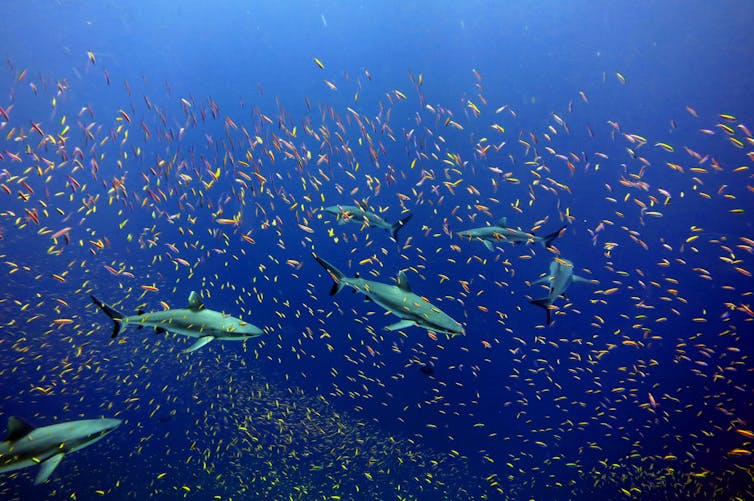
Sharks are some of the most ecologically important and most threatened animals on Earth. Recent reports show that up to one-third of all known species of sharks and their relatives, rays, are threatened with extinction. Unsustainable overfishing is the biggest threat by far.
Losing sharks can disrupt coastal food webs that billions of people depend on for food. When food chains lose their top predators, the rest can unravel as smaller prey species multiply.
In my years of talking with the public about sharks and ocean conservation, I’ve found that many people care about sharks and want to help but don’t know how. The solutions can be quite technical, and it’s challenging to understand and appreciate the scale and scope of some of the threats.
At the same time, there is an enormous amount of oversimplification and even misinformation about these important topics, which can lead well-intentioned people to support policies that experts know won’t work.
I am a marine conservation biologist and have sought to improve this situation by surveying shark researchers and helping scientists identify research topics that can advance conservation. I’ve also written a book, “Why Sharks Matter: A Deep Dive With the World’s Most Misunderstood Predator.” Here are three ways that anyone can make a difference for sharks and avoid taking steps that are ineffective or even harmful.
Don’t Eat Unsustainable Seafood
The No. 1 threat to sharks and rays – and arguably, to marine biodiversity in general – is unsustainable overfishing. Some fishing methods are incredibly destructive to marine life and habitats.
They can also produce high rates of bycatch – the unintended catch of nontarget species. For example, fishermen pursuing tuna may accidentally catch sea turtles or sharks swimming near the tuna.
The single most effective thing that individual consumers can do is to avoid seafood produced using these harmful methods. This does not mean completely avoiding seafood, as some advocates urge. Seafood is healthy, delicious and culturally important, and there are environmentally friendly ways of catching it sustainably. There are even sustainable fisheries for sharks.
Reputable organizations such as California’s Monterey Bay Aquarium publish sustainable seafood guides that rate different types of seafood based on how they are caught or raised. While experts may quibble over details of some of these rankings, consumers can follow these guidelines and know that they are helping to protect sharks and ocean life in general.
Support Reputable Environmental Nonprofits, Not Harmful Extremists
Lots of great environmental nonprofit organizations work on shark issues and offer opportunities to get involved, such as donating money and communicating with elected officials and other decision-makers. In my book, I describe the work of many of these groups, including my favorite, Shark Advocates International.
Unfortunately, some organizations promote pseudoscience that doesn’t help anyone or anything. In a 2021 study, colleagues and I surveyed employees of 78 nonprofits that work on shark conservation issues to understand whether and how these organizations engaged with the science of shark conservation.
We found that a small but vocal minority had never read scientific reports or spoken with scientists, and held blatantly incorrect and harmful views that cannot help sharks. For example, some organizations are trying to get certain airlines to stop carrying shark products like dried fins, without acknowledging that well over 95% of fins are shipped by sea or that sustainable sources of these fins exist.
One of my particular pet peeves is amateur online petitions that may not reflect actual conditions. For example, in the spring of 2022, some 60,000 people signed a petition calling for Florida to ban the practice of shark finning – without recognizing that Florida had banned shark finning in the early 1990s. As I explain in my book, it is essential to identify organizations that use science in support of worthwhile conservation goals and avoid promoting others that do not.
Look To Experts
Many ocean science, management and conservation experts are active on social media. Following them is a great way to learn about fascinating new scientific discoveries and conservation issues.
Unfortunately, sharks also get a lot of sensational coverage in the media, and well-intentioned but uninformed people often spread misinformation on social media. For example, you may have seen posts celebrating Hawaii for banning shark fishing in its waters – but these posts don’t note that about 99% of fishing in Hawaii occurs in federal waters.
Don’t take the bait. By getting your information from reliable sources, you can help other people learn more about these fascinating, ecologically important animals, why they need humans’ help and the most effective steps to take.![]()
David Shiffman, Post-Doctoral and Research Scholar in Marine Biology, Arizona State University
This article is republished from The Conversation under a Creative Commons license. Read the original article.
Patagonia’s founder has given his company away to fight climate change and advance conservation: 5 questions answered
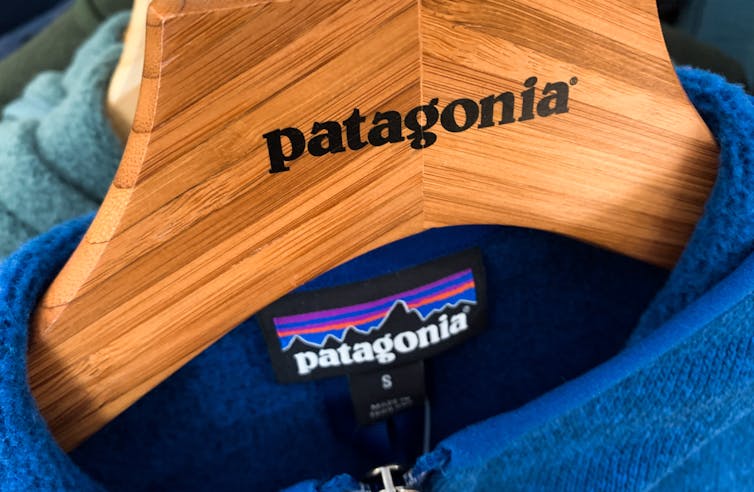
Patagonia founder Yvon Chouinard, his wife and their two adult children have irrevocably transferred their ownership of the outdoor apparel company to a set of trusts and nonprofit organizations.
From now on, the corporation’s profits will fund efforts to deal with climate change, as well as protect wilderness areas. It will, however, remain a privately held enterprise. According to initial reports about this unusual approach to philanthropy that ran on Sept. 14, 2022, Patagonia is worth about US$3 billion and its profits that will be donated in perpetuity could total $100 million every year.
The Conversation U.S. asked Indiana University’s Ash Enrici – a scholar who studies how philanthropy affects the environment – to explain why this arrangement is so significant.
1. Is This Move Part Of A Trend?
The biggest donors, those giving away billions of dollars, are increasingly making climate change a priority. Amazon founder Jeff Bezos, for example, announced in 2020 that he was putting $10 billion into his Earth Fund, and Laurene Powell Jobs, the widow of Apple co-founder Steve Jobs, said in 2021 that she would devote $3.5 billion of her fortune to fighting climate change.
Likewise, big donors are increasing their funding of conservation efforts.
In September 2021, the Earth Fund joined with eight other philanthropic powerhouses to pledge $5 billion to “support the creation, expansion, management and monitoring of protected and conserved areas of land, inland water and sea” around the world. This initiative aims to conserve 30% of Earth by 2030.
Within days of Chouinard’s announcement, another splashy climate gift emerged, setting a similar precedent. Filmmaker Adam McKay said he will donate $4 million he made from the movie “Don’t Look Up,” which he wrote, co-produced and directed. Those proceeds from his satirical film, which was a metaphor regarding climate inaction, will fund a climate activism group.
No matter how frequently these donations occur, it’s important to keep in mind that the cost of meeting the world’s environmental challenges is enormous and will cost trillions of dollars. So while all of these gifts are certainly significant in their scale, donors and governments will need to do and spend much more.
2. What Makes It Stand Out?
What’s unusual about Chouinard’s climate-change gift is its structure. By giving away his company and directing that the profits be spent fighting climate change in the long term in the form of regular installments, he is creating a new model for large-scale donations.
It also sets a notable precedent. Chouinard and his family are giving away the source of their wealth and setting things up in a way that is going to result in a predictable form of support for work on climate issues – an estimated $100 million each year from Patagonia’s profits.
I think it’s a great example for other business owners and very wealthy people to follow.
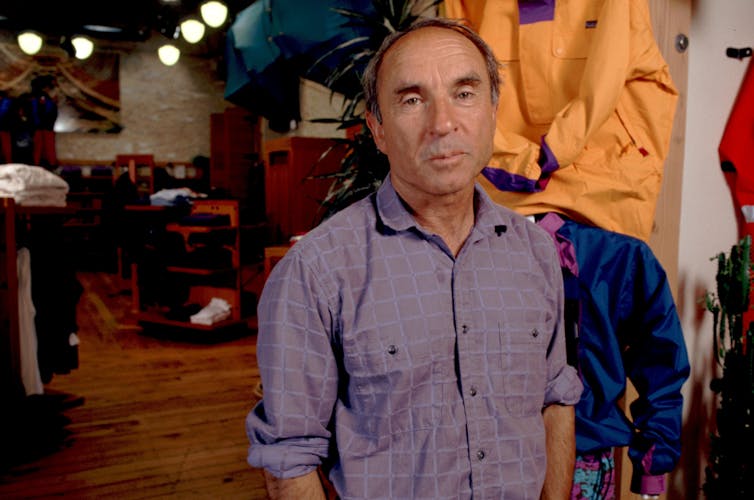
3. How Are Conservation And Climate Change Efforts Connected?
Journalists, scholars and the public often treat addressing climate change and conserving ecosystems as being two distinct priorities. But they are instead closely related. Having ecosystems thrive in a way that protects biodiversity is a way to slow the pace of climate change.
Climate change itself will harm ecosystems and contribute to the loss of biodiversity through, for example, raising temperatures in large bodies of water to the point where established marine ecosystems become so disrupted that many species die off.
And the flip side of that is that maintaining healthy ecosystems can help counter climate change. For example, mangroves are often cut down for shrimp farming and other industries. But protecting them offers the potential to retain as much, or more, carbon as tropical rain forests, while also safeguarding the animals and plants on the land and in the water.
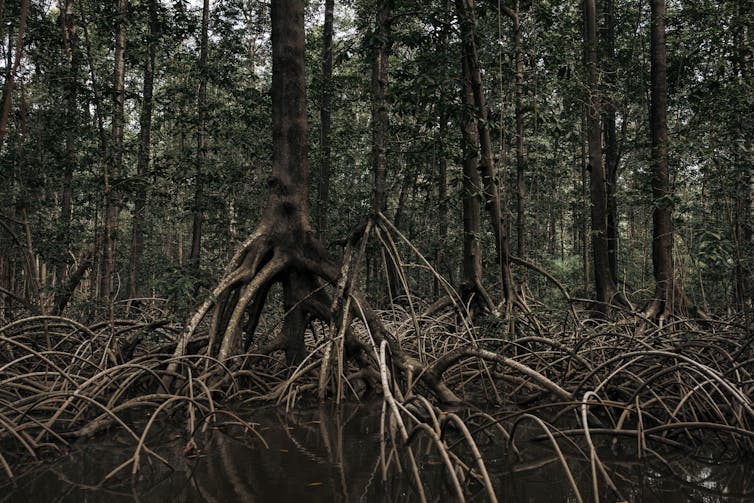
4. What Do You Think This Money Should Fund?
To me, how they – the newly minted Patagonia Purpose Trust, which will own and run the company, and the Holdfast Collective, the nonprofit funded by Patagonia’s profits – operate will be just as important as what they fund.
Based on research I’m engaged in, I believe that they can do more good by reflecting on how they work, hopefully in ways that are both equitable and effective. For example, they can consider highly collaborative approaches, incorporate flexibility for adapting circumstances and long-term funding to match ecological timescales. It’s also essential that indigenous people living in the places affected by environmental work have a say and are heard.
Because the Holdfast Collective is a social welfare group, rather than a charity, it will be free to emphasize policy reform – which I think should be a major priority.
Government and international aid agencies are often too constrained by bureaucracy to be able to adapt and adjust their practices in a way that might be needed to address urgent environmental challenges.
Philanthropists are more free in terms of how they work. That means funders like Patagonia’s trust can provide seed money to jump-start new initiatives that later may be more heavily funded and scaled up by governments.
5. Why Are Many People Troubled By Gifts Like This?
In recent years, scrutiny of philanthropy of all kinds has been on the rise. Some of the criticism takes aim at big donors, like Bezos, whose sources of wealth contribute to the problems their gifts are supposed to be solving.
Concerns about how philanthropy can perpetuate or excuse discrimination and oppression are also growing, leading to calls for its “decolonization.”
Even avid environmentalists are expressing deep concerns about the potential downsides of this new model. They’re asking whether it might be used to fund causes championed by other wealthy donors with starkly different agendas.
Regardless of what concerns you may have about what the Chouinard family decided to do, or regarding other billion-dollar donations that take aim at climate change, one thing is for sure: The cost of doing nothing at all will surely be much higher than taking action, however imperfectly.![]()
Ash Enrici, Assistant Professor of Philanthropic Studies, Indiana University
This article is republished from The Conversation under a Creative Commons license. Read the original article.
Desalinating seawater sounds easy, but there are cheaper and more sustainable ways to meet people’s water needs
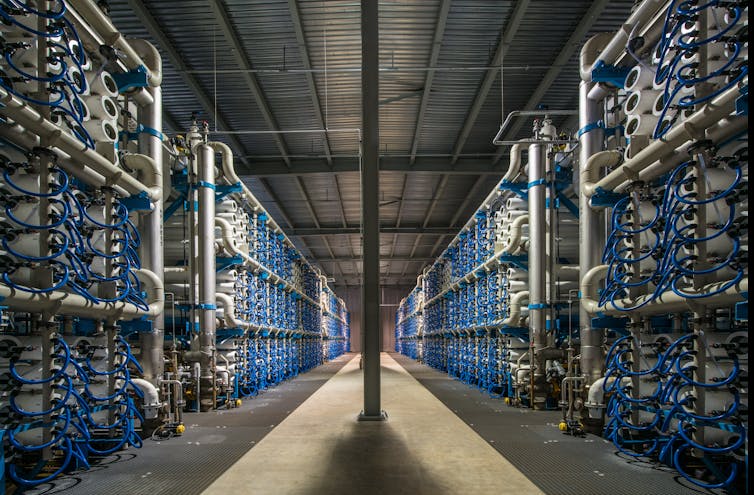
Coastal urban centers around the world are urgently looking for new, sustainable water sources as their local supplies become less reliable. In the U.S., the issue is especially pressing in California, which is coping with a record-setting, multidecadal drought.
California Gov. Gavin Newsom recently released a US$8 billion plan for coping with a shrinking water supply. Along with water conservation, storage and recycling, it includes desalination of more seawater.
Ocean desalination, which turns salt water into fresh, clean water, has an intuitive appeal as a water supply strategy for coastal cities. The raw supply of salt water is virtually unlimited and reliable.
Ocean desalination is already a major water source in Israel and the United Arab Emirates. Cities in the Middle East, Australia, Mediterranean Europe, the U.S. Southwest and Australia also rely on it. There are more than 20 ocean desalination plants operating in California, plus a few in Florida. Many more plants across the U.S. remove salt from brackish (salty) water sources such as groundwater inland, especially in Texas.
Nonetheless, current evidence shows that even in coastal cities, ocean desalination may not be the best or even among the best options to address water shortfalls. Here are the main issues that communities evaluating this option should consider.
Killing Aquatic Life
Scalable technologies for removing salt from water have improved steadily over the past few decades. This is especially true for treating brackish groundwater, which is less salty than seawater.
But desalination still can have major environmental impacts. Fish can be killed when they are trapped against screens that protect desalination plants’ intake valves, and small organisms such as bacteria and plankton can be sucked into the plants and killed when they pass through the treatment system. In May 2022, the California Coastal Commission unanimously rejected a proposed $1.4 billion ocean desalination plant in Huntington Beach, partly because of its potential effect on sea life.
Desalination plants discharge brine and wastewater, which can also kill nearby aquatic life if the process is not done properly. And generating the large quantity of energy that the plants consume has its own environmental impacts until it can be done carbon-free, which is still years off in most cases.
Unaffordable Water From Costly Plants
Cost is another major hurdle. In most areas, the cost of ocean desalination is projected to remain considerably higher than the cost of feasible alternatives such as conservation for the next several decades – the timeline that utilities use when planning new investments. My colleagues and I found this in our research comparing water supply alternatives for Huntington Beach, even though we made favorable assumptions about ocean desalination costs.
Cost breakthroughs on major, market-ready technology in the near to medium term are unlikely. And desalination costs may increase in response to rising energy prices, which represent up to half the cost of removing salt from water.
Moreover, capital cost projections for desalination plants often greatly understate these facilities’ true cost. For example, the final cost ($1 billion) to build the ocean desalination plant in Carlsbad, California, which opened in late 2015, was four times higher than the original projection.
Our center has also explored whether piping in desalinated ocean water is a viable option for small, typically rural areas with public water systems or private wells that have run dry or are close to giving out. In diverse parts of California where this has happened, such as Porterville in the Central Valley and Montecito along the coast, the state is paying over $1 per gallon to truck in small supplies of bottled and vended water. That’s much higher than even the most expensive desalinated seawater.
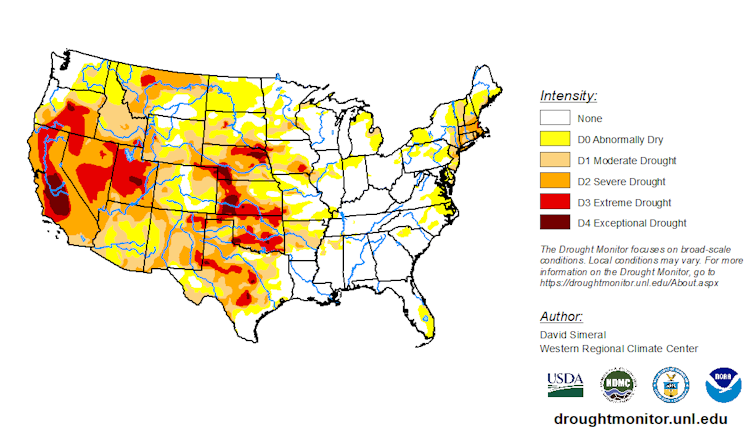
In these cases, we have found that the relative economics and even the environmental impact may pencil out, but the politics and management of new pipelines do not. This is because water supply is typically governed locally, and many local areas beyond those benefiting would need to agree to a new pipeline from the coast.
More broadly, we find that proponents of these projects do not proactively pursue strategies that would make water access more equitable, such as designing utility rate structures that shield low-income households from higher costs, providing financial aid to small communities or consolidating water systems.
Better Options: Conservation, Reuse, Storage And Trading
In most places, several other supply options can and should be pursued in tandem before ocean desalination. All of these steps will provide more water at a lower cost.
The first and relatively cheapest way to address water shortages is by using less. Finding ways to get people to use less water could reduce existing demand by 30%-50% in many urban areas that have already begun conservation efforts.
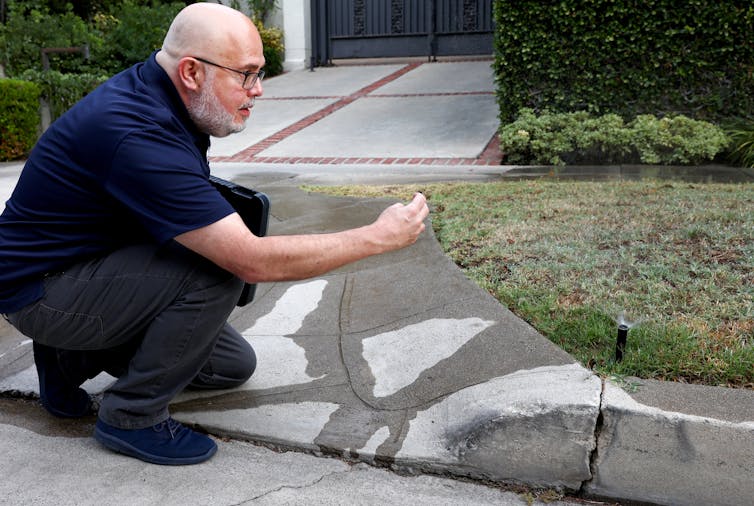
Second, recycling or reusing treated wastewater is often less expensive than desalination. Technology and regulations in this area are advancing, and this is already making large investments in recycling possible in many arid regions.
Third, storage capacity for enhanced capture of stormwater – even in areas where it rains infrequently – can be doubled or quadrupled in regions like Los Angeles and parts of Australia, at one-third to one-half of the cost per unit of desalinated water.
Even cleaning up polluted local groundwater supplies and purchasing water from nearby agricultural users, although these are costly and politically difficult strategies, may be prudent to consider before ocean desalination.
The feasibility of desalination as a local supply option will hopefully change by midcentury as water scarcity problems mount because of climate change. For the medium term, however, ocean desalination is still likely to play a small role if it figures at all in holistic water strategies for coastal urban areas.![]()
Gregory Pierce, Co-Director, Luskin Center for Innovation, University of California, Los Angeles
This article is republished from The Conversation under a Creative Commons license. Read the original article.
Thwaites Glacier: the melting, Antarctic monster of sea level rise – podcast
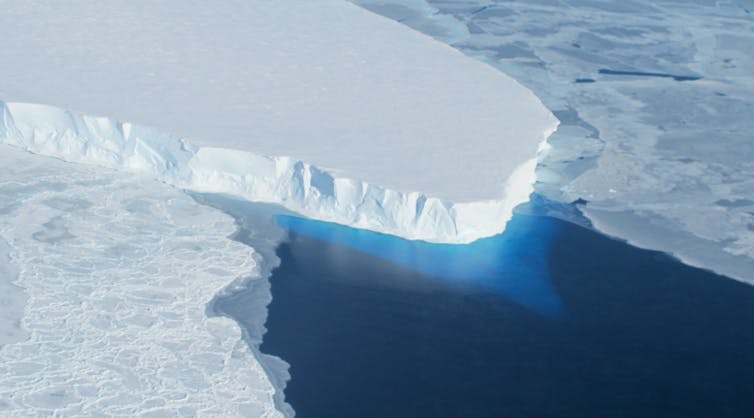
This episode of The Conversation Weekly podcast is about the Thwaites Glacier in Antarctica. Thwaites is among the largest glaciers on Earth and one of the single most important factors for future global sea level rise. We talk to three experts about what makes Thwaites so uniquely significant, why it’s melting and the creative techniques scientists are using to study it.
Thanks to climate change, ice all over the world is melting. Greenland, the Arctic the Himalayas and Antarctica are all experiencing the fastest melting in recorded history.
As ice that is currently sitting on land melts, it flows downhill and eventually reaches the ocean. If the ice melts faster than snow replenishes the glaciers, sea level rises.
The Thwaites Glacier is one of many bodies of ice that are melting, but this massive, Antarctic glacier is uniquely important when it comes to sea level rise. “We’re talking about an area that’s the size of the island of Great Britain,” says Ted Scambos, a glacier scientist at the University of Colorado in the US and the principal investigator of the Science Coordination Office of the International Thwaites Glacier Collaboration.
If – or when – the entire Thwaites Glacier melts, Scambos says it will result in around 0.6 meters of sea level rise. But the interior section of Thwaites is surrounded by other massive ice sheets that cover west Antarctica. And since Thwaites sits in a giant, low elevation basin, if it melts, the rest of the ice will flow into the basin and melt, too. Add all that ice up and you get more than three meters of sea level rise.
What makes Thwaites such a significant contributor to sea level rise is where it sits on the continent of Antarctica. It’s shaped sort of like a lollipop with the candy part sitting in a giant basin and the stick extending out from the continent to the ocean. And that stick is melting quickly.
Yixi Zheng is an oceanographer at the University of East Anglia in England and has recently been down to Antarctica to study how Thwaites is melting. She describes the scene in visceral terms. “You can really see the icebergs and the glaciers and they are melting. You can see the water dripping from the glaciers,” she tells us. “We get really emotional. They were pretty much crying.”
Paul Holland, an ocean and ice scientist with the British Antarctic Survey, has been looking at why the ice is melting, focusing on changes to the winds that bring warmer water down to the Amundsen Sea next to Thwaites. “The question is, if we reverse these greenhouse gas induced wind changes, what effect does that have? What’s going to happen to the ice sheet? Will it regrow or will it take many centuries to stabilise and then it might regrow?” says Holland. Thanks to his work and the work of researchers like Zheng and Scambos, scientists are starting to find the answers.
Listen to the full episode to hear how Thwaites’ unique shape makes it so scary, what researchers know about why it’s melting now and how seals are helping collect data on the glacier in places no human could ever go.
This episode was produced by Mend Mariwany, with sound design by Eloise Stevens. The executive producer was Gemma Ware. Our theme music is by Neeta Sarl. Sound of seals snoring in this episode from Nick Roden, and ice cubes from Idalize via Freesound.
You can find us on Twitter @TC_Audio, on Instagram at theconversationdotcom or via email. You can also sign up to The Conversation’s free daily email here. A transcript of this episode will be available shortly.
You can listen to The Conversation Weekly via any of the apps listed above, download it directly via our RSS feed, or find out how else to listen here.![]()
Daniel Merino, Assistant Science Editor & Co-Host of The Conversation Weekly Podcast, The Conversation and Gemma Ware, Editor and Co-Host, The Conversation Weekly Podcast, The Conversation
This article is republished from The Conversation under a Creative Commons license. Read the original article.
Net zero: Copenhagen’s failure to meet its 2025 target casts doubt on other major climate plans

The city of Copenhagen, often celebrated as one of the world’s greenest for its cycling culture and other initiatives, recently defaulted on its pledge to become carbon-neutral by 2025. This early failure in the global race to net zero emissions (a balance between CO₂ emitted and absorbed) may foreshadow backtracking by other target-setters, indicating that pledges to cease contributing to climate change demand greater scrutiny.
Since 2012, when Copenhagen launched its plan to become the first carbon-neutral city in the world by 2025, the city has enjoyed international recognition and a significant branding boost. It expects to reduce emissions by 80% by, for instance, switching its power and district heating systems to biomass, wind and solar, renovating buildings to make them energy efficient and improving public transport.
The remaining emissions were supposed to be mopped up by installing carbon capture and storage (CCS) technology at the local waste-to-energy plant. This would remove CO₂ from the smokestack before it is emitted to the atmosphere, isolating it for later underground storage.
But at the beginning of August 2022, the semi-public utility Amager Resource Center (ARC) which manages the plant announced it was ineligible for national CCS funding. This funding, it argued, would otherwise have enabled them to capture CO₂ generated by burning the city’s waste. And so, Copenhagen has given up on its pledge.

Cities such as Glasgow and Helsinki, countries like Sweden and the UK, and companies including IKEA and Apple have made similar pledges to be net zero by 2030, 2045 or 2050. This gives the impression that sufficient measures to address climate change are in the pipeline.
Yet various reports and studies suggest that these pledges often skimp on important details, by failing to include progress reports or specify the emissions they target. Critics have warned that the idea of net zero may only serve to greenwash reputations and diminish the urgency around decarbonisation.
Copenhagen is unlikely to be the last to renege on its net zero pledge. The city’s example of relying on immature technology and external funding indicates how similar climate plans might disintegrate in future.
Faith In Technology
Copenhagen’s experience highlights two problems which could scupper other net zero strategies. First, the city’s reliance on immature technology.
Copenhagen’s plan to reach net zero emissions did not always include CCS. When the city announced its 2025 goal in 2012, the Danish parliament had just rejected an application from Swedish energy company Vattenfall to deploy CCS at its coal power plant in northern Jutland. Danish politicians wanted to monitor experiences with CCS abroad before allowing it in Denmark.
Instead, in 2012 Copenhagen’s net zero plan relied on the expectation of reducing the energy-to-waste plant’s emissions by recycling more plastic waste and increasing the ratio of organic waste (since it would count as carbon neutral). But when the third and final road map for Copenhagen’s transition was presented in 2021, it included a shortfall of 430,000 tonnes of CO₂.
Alongside other measures, CCS was – in line with new national policy – supposed to be installed at the plant to bridge the gap by cutting 390,000 tonnes of CO₂. The utility managing the plant suggested the technology could capture up to 500,000 tonnes.

Copenhagen is not alone in including CCS in its climate strategy. Neighbouring capitals Oslo and Stockholm expect to reach net zero with it too. Denmark’s national climate strategy expects CCS to cut between 3.5 million tonnes and 8 million tonnes of CO₂ by 2030.
Despite the faith invested in it, carbon capture technology has a poor track record. A new study by the Institute for Energy Economics and Financial Analysis think tank found that CCS projects tend to underperform on their emission reduction targets.
Dedicated investment in carbon storage technology has been sluggish too. As a result, CCS is largely used to extend the shelf life of fossil fuels, as captured CO₂ can be injected into oil wells to extract additional oil. These and other issues were reported to municipal leaders in Copenhagen as substantial risks to the 2025 goal.
Lack Of Accountability
The second problem concerns the question of accountability. Who is ultimately responsible for Copenhagen’s failure to meet its net zero target? When the utility ARC first announced its plan to deploy CCS at its waste-to-energy plant in 2021, it counted on external funding and a supportive policy framework to do so.
Now, the head of the city’s technology and environment committee criticises national politicians for knowingly setting financial criteria which the utility cannot meet, hindering the city’s road to climate neutrality. And so, the baton of responsibility is passed.
Emissions targets must be based on credible measures which are within the powers of those pledging them. There must be clear ways to assign accountability if those plans fail. When organisations boast of pledges which ultimately depend on the actions of others to succeed, the public is right to question their validity.
Copenhagen’s mayor suggested the city may still reach climate neutrality in 2026, 2027 or 2028. Yet this case shows how easily net zero plans can fall apart.
It reveals the dangers of the current uncoordinated approach to reaching net zero, in which every organisation is free to set its own eye-catching pledge without fully accounting for its success. What we need is for political and corporate decision-makers to present credible plans for the necessary deep decarbonisation of society.

Don’t have time to read about climate change as much as you’d like?
Get a weekly roundup in your inbox instead. Every Wednesday, The Conversation’s environment editor writes Imagine, a short email that goes a little deeper into just one climate issue. Join the 10,000+ readers who’ve subscribed so far.![]()
Kirstine Lund Christiansen, PhD Fellow, Political Ecology, University of Copenhagen and Inge-Merete Hougaard, Postdoctoral Fellow in Political Ecology, Lund University
This article is republished from The Conversation under a Creative Commons license. Read the original article.
A dam built in the Amazon created thousands of ‘forest islands’ but they are too small to sustain most species
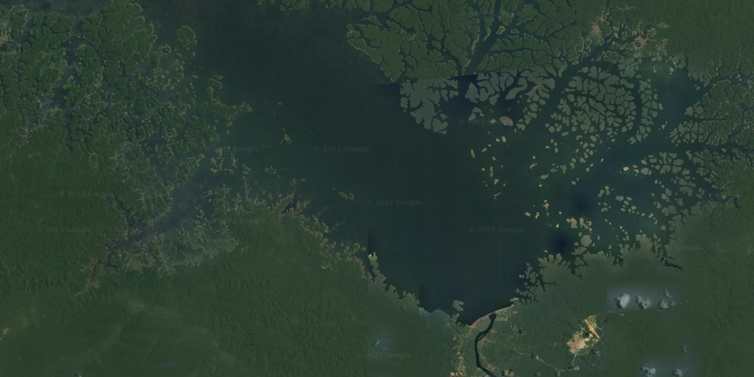
Built in the 1980s, the Balbina Dam is one of dozens of large dams across rivers in the Amazon Basin. Such dams might leave behind seemingly green patches of forest, but our new research has shown these disconnected patches of forest are no longer able to support thriving ecosystems.
The dam created one of the largest reservoirs in South America which stretches for almost 100km northwards through largely undisturbed rainforest. As this is a relatively hilly part of the Amazon basin, more than 3,500 islands formed as the reservoir filled up. What were once ridges or hilltops became insular forest patches.
For rainforest ecologists like us, the new landscape was an astonishing living lab – a way to test theories of what happens when a forest and its many animals are increasingly restricted to smaller and smaller patches.
We know that one of the main drivers of the ongoing biodiversity crisis is the loss of habitat and the fragmentation of the remaining areas. And we know that hydroelectric dams are one of the primary ways humans are disturbing these habitats, and that many developing countries (including those in the Amazon) are due to build many more dams.
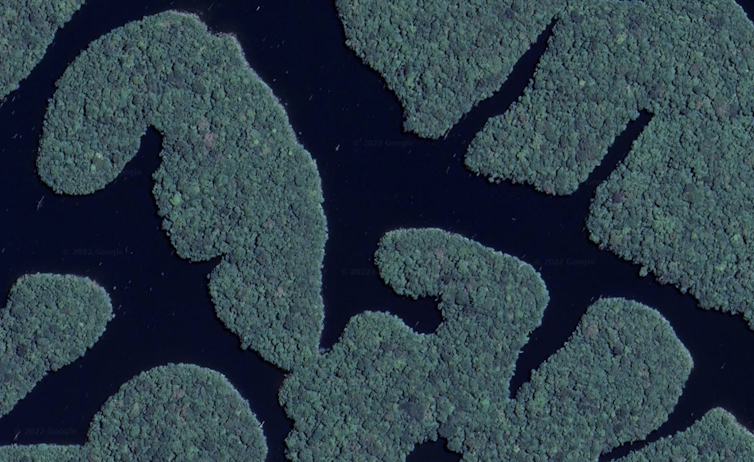
In the new landscape created after a dam fragments the forest, we expect species to disappear faster from smaller islands that simply can’t sustain viable populations. And we expect other factors to play a role, such as whether a species is resilient and can cope with its habitat being transformed.
That’s the theory, at least. And the Balbina Dam gave us a perfect chance to see it in practice.
22 Forest Islands, 608 Species
Over the past decade or so, scientists from many different institutions have made huge efforts to investigate which species are vanishing and which are persisting in the Balbina reservoir. In this study, we were able to compile those efforts.
In particular, we studied 22 forest islands of varying sizes. We also looked at three nearby sites that were connected to the main forest and weren’t islands, which we considered as a baseline reflecting the scenario before damming. We recorded 608 species representing eight biological groups: medium and large mammals, small mammals (excluding bats), diurnal lizards (active during the daytime), understorey birds, frogs, dung beetles, orchid bees and trees.
Our results are now published in Science Advances. We found that just a few larger islands held most of the diversity and had complete or nearly complete species assemblages. Meanwhile, smaller islands suffered. There, only more adaptable species like armadillos or rodent acouchis were able to survive for over three decades. These medium-sized animals can occupy relatively small areas. In contrast, bigger mammals such as tapirs and jaguars need more space, and might have vanished even from mid-size islands.
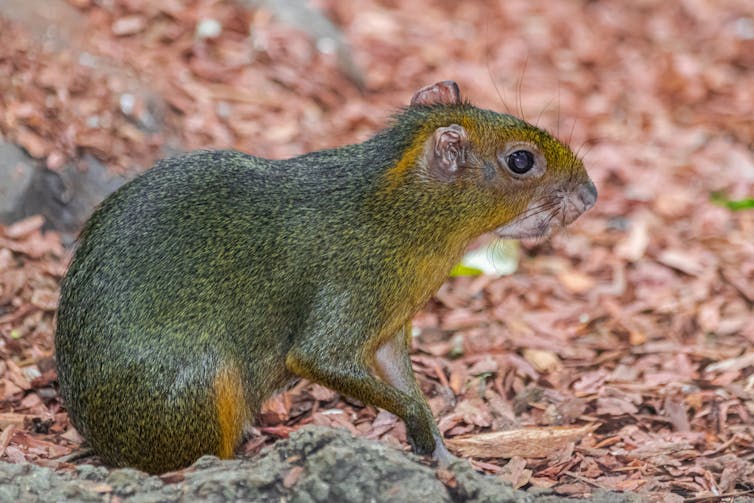
We also found widespread and non-random cases of species going extinct on individual islands. Bigger species were generally more likely to go extinct, but this varied across different groups of plants, vertebrates and invertebrates. For instance, the largest species of orchid bees Eulaema bombiformis or Eulaema meriana were also widely distributed across the landscapes. This was also the case for large understorey bird species, whereas the pattern was opposite for frogs, with the smallest species being more widely distributed.
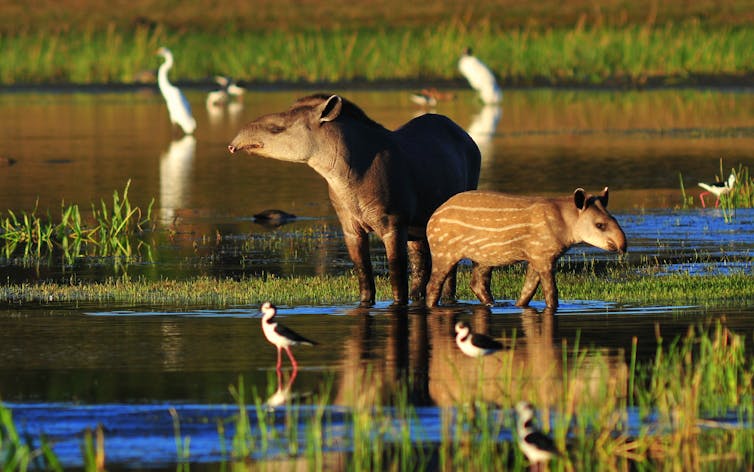
Most of the islands created by Balbina Dam, like those in other reservoirs containing forest islands elsewhere in lowland tropical forests, are relatively small. Indeed, 95% are smaller than a square kilometre. These islands proved able to sustain low levels of biodiversity, which further has major implications for ecosystem functioning.
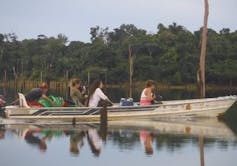
While the Amazon is famous for its extraordinary diversity, when we actually visited these islands we were struck by how they were dominated by species of animals and plants that were generalists and can be found elsewhere, with the forest-dependent specialist species found on the mainland and in the large islands almost nowhere to be seen.
Plans to develop hydropower across lowland tropical forests mean we expect this process to happen more and more in the aftermath of river damming. With this in mind, we recommend future hydroelectric projects should avoid flooding large expanses of forest and creating lots of small islands. This would minimise biodiversity loss and help ecosystems to keep functioning. Finally, biodiversity loss should be weighed alongside other environmental costs in future assessments of whether damming the world’s mega-diverse tropical rivers is really worth it.![]()
Ana Filipa Palmeirim, Postdoctoral Researcher, TROPIBIO Project, Universidade do Porto; Carine Emer, Associated Researcher, Biology, Rio de Janeiro Botanical Garden Research Institute, and Carlos Peres, Professor of Tropical Conservation Ecology, University of East Anglia
This article is republished from The Conversation under a Creative Commons license. Read the original article.
Pittwater Reserves: Histories + Notes + Pictorial Walks
A History Of The Campaign For Preservation Of The Warriewood Escarpment by David Palmer OAM and Angus Gordon OAM
America Bay Track Walk - photos by Joe Mills
An Aquatic June: North Narrabeen - Turimetta - Collaroy photos by Joe Mills
Angophora Reserve Angophora Reserve Flowers Grand Old Tree Of Angophora Reserve Falls Back To The Earth - History page
Annie Wyatt Reserve - A Pictorial
Avalon's Village Green: Avalon Park Becomes Dunbar Park - Some History + Toongari Reserve and Catalpa Reserve
Bairne Walking Track Ku-Ring-Gai Chase NP by Kevin Murray
Bangalley Headland Bangalley Mid Winter
Banksias of Pittwater
Barrenjoey Boathouse In Governor Phillip Park Part Of Our Community For 75 Years: Photos From The Collection Of Russell Walton, Son Of Victor Walton
Barrenjoey Headland: Spring flowers
Barrenjoey Headland after fire
Bayview Baths
Bayview Wetlands
Beeby Park
Bilgola Beach
Botham Beach by Barbara Davies
Bungan Beach Bush Care
Careel Bay Saltmarsh plants
Careel Bay Birds
Careel Bay Clean Up day
Careel Bay Playing Fields History and Current
Careel Creek
Careel Creek - If you rebuild it they will come
Centre trail in Ku-ring-gai Chase National Park
Chiltern Track- Ingleside by Marita Macrae
Clareville Beach
Clareville/Long Beach Reserve + some History
Coastal Stability Series: Cabbage Tree Bay To Barrenjoey To Observation Point by John Illingsworth, Pittwater Pathways, and Dr. Peter Mitchell OAM
Cowan Track by Kevin Murray
Curl Curl To Freshwater Walk: October 2021 by Kevin Murray and Joe Mills
Currawong and Palm Beach Views - Winter 2018
Currawong-Mackerel-The Basin A Stroll In Early November 2021 - photos by Selena Griffith
Currawong State Park Currawong Beach + Currawong Creek
Deep Creek To Warriewood Walk photos by Joe Mills
Drone Gives A New View On Coastal Stability; Bungan: Bungan Headland To Newport Beach + Bilgola: North Newport Beach To Avalon + Bangalley: Avalon Headland To Palm Beach
Duck Holes: McCarrs Creek by Joe Mills
Dunbar Park - Some History + Toongari Reserve and Catalpa Reserve
Dundundra Falls Reserve: August 2020 photos by Selena Griffith - Listed in 1935
Elsie Track, Scotland Island
Elvina Track in Late Winter 2019 by Penny Gleen
Elvina Bay Walking Track: Spring 2020 photos by Joe Mills
Elvina Bay-Lovett Bay Loop Spring 2020 by Kevin Murray and Joe Mills
Fern Creek - Ingleside Escarpment To Warriewood Walk + Some History photos by Joe Mills
Iluka Park, Woorak Park, Pittwater Park, Sand Point Reserve, Snapperman Beach Reserve - Palm Beach: Some History
Ingleside
Ingleside Wildflowers August 2013
Irrawong - Ingleside Escarpment Trail Walk Spring 2020 photos by Joe Mills
Irrawong - Mullet Creek Restoration
Katandra Bushland Sanctuary - Ingleside
Lucinda Park, Palm Beach: Some History + 2022 Pictures
McCarrs Creek
McCarr's Creek to Church Point to Bayview Waterfront Path
McKay Reserve
Mona Vale Beach - A Stroll Along, Spring 2021 by Kevin Murray
Mona Vale Headland, Basin and Beach Restoration
Mount Murray Anderson Walking Track by Kevin Murray and Joe Mills
Mullet Creek
Narrabeen Creek
Narrabeen Lagoon Catchment: Past Notes Present Photos by Margaret Woods
Narrabeen Lagoon State Park
Narrabeen Lagoon State Park Expansion
Narrabeen Rockshelf Aquatic Reserve
Nerang Track, Terrey Hills by Bea Pierce
Newport Bushlink - the Crown of the Hill Linked Reserves
Newport Community Garden - Woolcott Reserve
Newport to Bilgola Bushlink 'From The Crown To The Sea' Paths: Founded In 1956 - A Tip and Quarry Becomes Green Space For People and Wildlife
Pittwater spring: waterbirds return to Wetlands
Pittwater's Lone Rangers - 120 Years of Ku-Ring-Gai Chase and the Men of Flowers Inspired by Eccleston Du Faur
Pittwater's Parallel Estuary - The Cowan 'Creek
Resolute Track at West Head by Kevin Murray
Resolute Track Stroll by Joe Mills
Riddle Reserve, Bayview
Salvation Loop Trail, Ku-Ring-Gai Chase National Park- Spring 2020 - by Selena Griffith
Seagull Pair At Turimetta Beach: Spring Is In The Air!
Stapleton Reserve
Stapleton Park Reserve In Spring 2020: An Urban Ark Of Plants Found Nowhere Else
Stony Range Regional Botanical Garden: Some History On How A Reserve Became An Australian Plant Park
The Chiltern Track
The Resolute Beach Loop Track At West Head In Ku-Ring-Gai Chase National Park by Kevin Murray
Topham Track Ku-Ring-Gai Chase NP, August 2022 by Joe Mills and Kevin Murray
Towlers Bay Walking Track by Joe Mills
Trafalgar Square, Newport: A 'Commons' Park Dedicated By Private Landholders - The Green Heart Of This Community
Tranquil Turimetta Beach, April 2022 by Joe Mills
Turimetta Beach Reserve by Joe Mills, Bea Pierce and Lesley
Turimetta Beach Reserve: Old & New Images (by Kevin Murray) + Some History
Turimetta Headland
Warriewood Wetlands and Irrawong Reserve
Whale Beach Ocean Reserve: 'The Strand' - Some History On Another Great Protected Pittwater Reserve
Wilshire Park Palm Beach: Some History + Photos From May 2022
Winji Jimmi - Water Maze

New Shorebirds WingThing For Youngsters Available To Download
A Shorebirds WingThing educational brochure for kids (A5) helps children learn about shorebirds, their life and journey. The 2021 revised brochure version was published in February 2021 and is available now. You can download a file copy here.
If you would like a free print copy of this brochure, please send a self-addressed envelope with A$1.10 postage (or larger if you would like it unfolded) affixed to: BirdLife Australia, Shorebird WingThing Request, 2-05Shorebird WingThing/60 Leicester St, Carlton VIC 3053.

 Shorebird Identification Booklet
Shorebird Identification Booklet
The Migratory Shorebird Program has just released the third edition of its hugely popular Shorebird Identification Booklet. The team has thoroughly revised and updated this pocket-sized companion for all shorebird counters and interested birders, with lots of useful information on our most common shorebirds, key identification features, sighting distribution maps and short articles on some of BirdLife’s shorebird activities.
The booklet can be downloaded here in PDF file format: http://www.birdlife.org.au/documents/Shorebird_ID_Booklet_V3.pdf
Paper copies can be ordered as well, see http://www.birdlife.org.au/projects/shorebirds-2020/counter-resources for details.
Download BirdLife Australia's children’s education kit to help them learn more about our wading birdlife
Shorebirds are a group of wading birds that can be found feeding on swamps, tidal mudflats, estuaries, beaches and open country. For many people, shorebirds are just those brown birds feeding a long way out on the mud but they are actually a remarkably diverse collection of birds including stilts, sandpipers, snipe, curlews, godwits, plovers and oystercatchers. Each species is superbly adapted to suit its preferred habitat. The Red-necked Stint is as small as a sparrow, with relatively short legs and bill that it pecks food from the surface of the mud with, whereas the Eastern Curlew is over two feet long with a exceptionally long legs and a massively curved beak that it thrusts deep down into the mud to pull out crabs, worms and other creatures hidden below the surface.
Some shorebirds are fairly drab in plumage, especially when they are visiting Australia in their non-breeding season, but when they migrate to their Arctic nesting grounds, they develop a vibrant flush of bright colours to attract a mate. We have 37 types of shorebirds that annually migrate to Australia on some of the most lengthy and arduous journeys in the animal kingdom, but there are also 18 shorebirds that call Australia home all year round.
What all our shorebirds have in common—be they large or small, seasoned traveller or homebody, brightly coloured or in muted tones—is that each species needs adequate safe areas where they can successfully feed and breed.
The National Shorebird Monitoring Program is managed and supported by BirdLife Australia.
This project is supported by Glenelg Hopkins Catchment Management Authority and Hunter Local Land Services through funding from the Australian Government’s National Landcare Program. Funding from Helen Macpherson Smith Trust and Port Phillip Bay Fund is acknowledged.
The National Shorebird Monitoring Program is made possible with the help of over 1,600 volunteers working in coastal and inland habitats all over Australia.
The National Shorebird Monitoring program (started as the Shorebirds 2020 project initiated to re-invigorate monitoring around Australia) is raising awareness of how incredible shorebirds are, and actively engaging the community to participate in gathering information needed to conserve shorebirds.
In the short term, the destruction of tidal ecosystems will need to be stopped, and our program is designed to strengthen the case for protecting these important habitats.
In the long term, there will be a need to mitigate against the likely effects of climate change on a species that travels across the entire range of latitudes where impacts are likely.
The identification and protection of critical areas for shorebirds will need to continue in order to guard against the potential threats associated with habitats in close proximity to nearly half the human population.
Here in Australia, the place where these birds grow up and spend most of their lives, continued monitoring is necessary to inform the best management practice to maintain shorebird populations.
BirdLife Australia believe that we can help secure a brighter future for these remarkable birds by educating stakeholders, gathering information on how and why shorebird populations are changing, and working to grow the community of people who care about shorebirds.
To find out more visit: http://www.birdlife.org.au/projects/shorebirds-2020/shorebirds-2020-program
Aussie Bread Tags Collection Points

Viewfinder: Photography From The 1970s To Now Opens At The National Library

HSC Online Help Guides
Stay Healthy - Stay Active: HSC 2022

2023 Year 12 School Scholarship Program Now Open: DYRSL

Securing A Brighter Future For Disadvantaged Youth
The Unique Power Of Australian Seaweed
By BBC newsreel
Be The Boss: I Want To Be A Marine Electrician
- Troubleshoot wiring and other electrical systems on marine equipment and make repairs
- Test low and high-voltage circuit systems for safety
- Work on power generators or other alternative sources of energy, like solar or wind power
- Wire and test the alarm and communication systems
- Monitor for potential electrical voltage threats
- Design and update bonding systems to protect the ship against weather elements
- Protect the boat's equipment using drip loops and heat shrinks
- Interpret and write technical reports and estimate repair costs
- Install wiring and electrical equipment when building new ships
- Install and configure generators
- Test marine electrical equipment like voltmeters and oscilloscopes for efficiency
- Electrical power generation and distribution
- The ship's boats engine and steering systems
- Propulsion systems (gas turbines, diesel and electrical engines, gear boxes, propellers, thrusters, and positioning systems)
- Electrical systems (alternators, batteries, charging systems, electrical switchboards, and corrosion protection systems)
- Auxiliary engineering systems (air-conditioning, refrigeration, generators, air compressor systems, stabilisers, winches, and cranes)
- Hull structures and fittings
- Free medical and dental
- Competitive salary package
- Incremental salary increases as you progress through training and ranks
- 16.4% superannuation
- Job security
- Career progression and development
- Good work/life balance
- Travel opportunities
- Excellent social and fitness facilities
- Subsidised housing
- Balance of shore and sea postings
- Great chef made meals at sea
- Variety of allowances
- Technical: Working as a marine electrician involves a lot of technical work. You will need to troubleshoot the electrical system, rewire systems and install equipment in the ship.
- Mechanical: Good mechanical skills are also useful as you will use certain tools and machinery to install and repair systems. A basic understanding of mechanics can be helpful.
- Problem-solving: A big part of the job of a marine electrician is identifying electrical problems and repairing them. This involves good troubleshooting skills and the ability to quickly come up with a solution.
- Project management: Marine electricians will often manage multiple projects at one time. They may complete projects for different ships and will need to manage time and delegate tasks.
- Knowledge of electrical systems: A good working knowledge of electrical systems in ships is important. In addition to reading and navigating electrical blueprints, marine electricians will need to know where to find certain access points and wires.
- Coast guard: Some marine electricians may choose to work with the U.S. government on military ships. If this is your preferred route, you may need special coast guard training.
- Knowledge of circuit breakers, transformers and high-voltage control panels: Working as a marine electrician, you are likely to work with each of these things. An apprenticeship can be a good way to learn these areas in-depth.
- Knowledge of certain safety protocols: Up-to-date safety protocols are needed as marine electricians often work on electrical systems near water. Knowledge of emergency protocols is needed.
Also Available:
- Be The Boss: I want To Be A Cabinet Maker
- Be The Boss: I Want To Be An Automotive Mechanic
- Be The Boss: I Want To Be A Biotechnologist
- Be The Boss: I Want To Be A Pilot
- Be The Boss: I Want To Be A Music Producer
- Be The Boss: I Want To Be A Gardener
- Be The Boss: I Want To Be A Builder
- Be The Boss: I Want To Be A Confectioner
- Be The Boss: I Want To Be A Ship's Captain
Word Of The Week: Toll
noun
1. a charge payable to use a bridge or road. 2.the number of deaths or casualties arising from a natural disaster, conflict, accident, etc.
verb
1. (of a large bell) to ring slowly and repeatedly, or to cause a large bell to ring in this way.
A death knell is the ringing of a church bell immediately after a death to announce it. Historically it was the second of three bells rung around death, the first being the passing bell to warn of impending death, and the last was the lych bell or corpse bell, which survives today as the funeral toll.In England, an ancient custom was the ringing of bells at three specific times before and after death. Sometimes a passing bell was first rung when the person was still dying, then the death knell upon the death,and finally the lych bell, which was rung at the funeral as the procession approached the church. The ringing of the lych bell is now called the funeral toll. The canon law of the Church of England also permitted tolling after the funeral.
During the reign of Henry VIII and Elizabeth I, statutes regulated death knell, but the immediate ringing after death fell into disuse. It was customary in some places by the end of the 19th century to ring the death knell as soon as notice reached the clerk of the church (parish clerk) or sexton, unless the sun had set, in which case it was rung at an early hour the following morning. Elsewhere, it was customary to postpone the death knell and tellers to the evening preceding the funeral, or early in the morning on the day of the funeral to give warning of the ceremony.
The use of the passing bell for sick persons is indicated in the advertisements of Queen Elizabeth in 1564: "[W]here any Christian bodie is in passing, that the bell be tolled, and that the curate be specially called for to comfort the sick person".
Sometimes the age of the departed was signified by the number of chimes (or strokes) of the bell. This practice still persists in many places - the recent funeral of Her Majesty Queen Elizabeth II saw 96 tolls or peals of Big Ben to signify her 96 years of life.
This is shown again in the 1940 published novel For Whom the Bell Tolls by Ernest Hemingway. It tells the story of Robert Jordan, a young American volunteer attached to a Republican guerrilla unit during the Spanish Civil War. As a dynamiter, he is assigned to blow up a bridge during an attack on the city of Segovia.
The book's title is taken from the metaphysical poet John Donne's series of meditations and prayers on health, pain, and sickness (written while Donne was convalescing from a nearly fatal illness) published in 1624 as Devotions upon Emergent Occasions, specifically Meditation XVII. Hemingway quotes part of the meditation (using Donne's original spelling) in the book's epigraph. Donne refers to the practice of funeral tolling, universal in his time:
No man is an Island, intire of it selfe; every man is a piece of the Continent, a part of the maine; if a Clod bee washed away by the Sea, Europe is the lesse, as well as if a Promontorie were, as well as if a Mannor of thy friends or of thine owne were; any mans death diminishes me, because I am involved in Mankinde; And therefore never send to know for whom the bell tolls; It tolls for thee.
The use of "tellers" to denote the sex was almost universal. For instance in the greater number of churches in the counties of Kent and Surrey they used the customary number of tellers, viz., three times three strokes for a man, and three times two for a woman; with a varying usage for children. The word "tellers" became changed into "Tailors".
The funeral tolling of a bell is the technique of sounding a single bell very slowly, with a significant gap between strikes. It is used to mark the death of a person at a funeral or burial service. The expression "tolling" is derived from the English tradition of "telling" of the death by signalling with a bell. The term tolling may also be used to signify a single bell being rung slowly, and possibly half-muffled at a commemoration event many years later. Tolling is typically used for tenor bells in change ringing, it also applies to bourdon bells as well in a bell tower or cathedral.
Compare the invoking of silence instead of tolls denoting years:
Stop all the clocks
'Stop all the clocks, cut off the telephone'
Stop all the clocks, cut off the telephone,
Prevent the dog from barking with a juicy bone,
Silence the pianos and with muffled drum
Bring out the coffin, let the mourners come.
Let aeroplanes circle moaning overhead
Scribbling on the sky the message He Is Dead,
Put crepe bows round the white necks of the public doves,
Let the traffic policemen wear black cotton gloves.
He was my North, my South, my East and West,
My working week and my Sunday rest,
My noon, my midnight, my talk, my song;
I thought that love would last for ever: I was wrong.
The stars are not wanted now: put out every one;
Pack up the moon and dismantle the sun;
Pour away the ocean and sweep up the wood;
For nothing now can ever come to any good.
W H Auden
"Funeral Blues", or "Stop all the clocks", is a poem by W. H. Auden which first appeared in the 1936 play The Ascent of F6. Auden substantially rewrote the poem several years later as a cabaret song for the singer Hedli Anderson. Both versions were set to music by the composer Benjamin Britten. The second version was first published in 1938 and was titled "Funeral Blues" in Auden's 1940 Another Time. The poem experienced renewed popularity after being read in the film Four Weddings and a Funeral (1994), which also led to increased attention on Auden's other work. It has since been cited as one of the most popular modern poems in the United Kingdom.
Toll - From Middle English toll, tol, tolle, from Old English toll (“toll, duty, custom”), from Proto-Germanic *tullō (“what is counted or told”), from Proto-Indo-European *dol- (“calculation, fraud”). Cognate with Saterland Frisian Tol (“toll”), Dutch tol (“toll”), German Zoll (“toll, duty, customs”), Danish told (“toll, duty, tariff”), Swedish tull (“toll, customs”), Icelandic tollur (“toll, customs”). More at tell, tale.
Alternate etymology derives Old English toll, from Medieval Latin tolōneum, tolōnium, alteration (due to the Germanic forms above) of Latin telōneum, from Ancient Greek (telṓnion, “toll-house”), from τέλος (télos, “tax”).
Toll (bell peal) ME tollen to entice, lure, pull, hence prob. to make (a bell) ring by pulling a rope; akin to OE -tyllan, in fortyllan to attract, allure
ALKOO OF PALM BEACH.
When first I saw Alkoo, she was a pretty, young mother koala with a soft, grey furry coat, a white front, and ears fringed with feathery fur. She opened her bright eyes so wide when she gazed about the bush that she looked as if she was always surprised, though really she was not, for she knew every opossum and every cockatoo and parrot that lived in the gum forest near Palm Beach.
Alkoo’s coat was so silky, her eyes were so bright, her large nose so handsome that the koala colony thought Antony very lucky to have won her for his wife. But Alkoo did not agree with her friends. She thought she was the lucky one to have so kind and goo d-looking a husband, and when her little son, Bunyarra, was born, she was so proud that she hardly knew what to do.
The days and weeks passed quietly by, and Bunyarra grew steadily till he was big enough and strong enough to climb out of his mother’s pouch and look about. It is hard to say whether Alkoo or Antony was the prouder of him. They both doted on him, and he would have become thoroughly spoiled had not Alkoo been a really good mother and punished him when he was disobedient or cheeky.
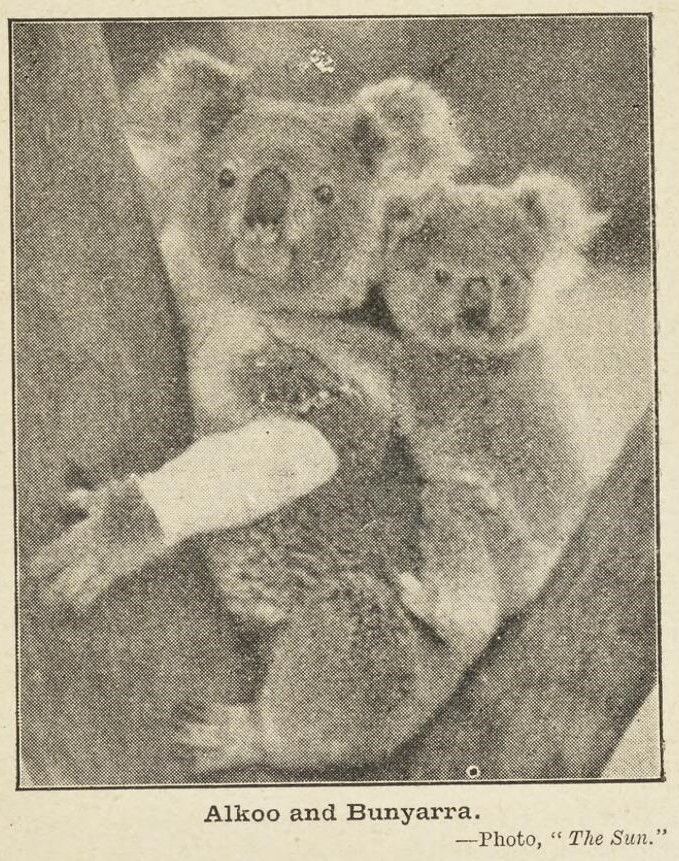
Alkoo and Bunyarra. —Photo, “ The Sun.”
If it had not been for Bunyarra’s curiosity, trouble would not have fallen on Alkoo. One Saturday afternoon he set off on his own when his parents were both fast asleep, for it was a hot afternoon towards the end of the summer.
Bunyarra trotted and hopped as fast as he could, and soon reached the edge of the concrete motor-road. There he sat in the shade of a little gum-tree and watched. He was so small and so much in the shade that no one noticed him. He loved watching the cars. What a lot he would have to tell everyone when he got home !
He was just feeling a little hungry, and thinking that he had better start for home, when he heard a soft grunt, and turned to see his mother. She did not say much, but was clearly very frightened about him and very cross. Bunyarra was beginning to explain how clever he was, and to tell Alkoo all about the cars, when a dog barked quite near them, and before Bunyarra had time to run away, a large, rough-coated dog sprang upon his mother, barking furiously.
Bunyarra ran away, and climbed a little tree. He could not quite see all that happened to his mother. At first he hardly dared to look. He knew that the dog had hurt her, for it had her down on the ground, and rolled her over, and then she screamed with pain.
Bunyarra was dreadfully upset. He sobbed and cried, but no one paid any attention to him. A boy and a girl came running up to his mother. They called off the dog and the boy picked up Alkoo. One of her arms hung limp, and one of her ears was bleeding. The boy carried her to a car, and a man drove him and the girl and Alkoo away.
Alkoo’s broken arm hurt her badly, so did her torn ear, but much worse to bear than the pain was her anxiety about Bunyarra. Was he still by the road ? Had he gone home to his father ? Could he find his way home ?
Alkoo was so terribly worried about Bunyarra that she hardly noticed what was happening to herself, nor did she care. The car was travelling fast, and after what seemed a long time it stopped.
“I’ll carry her in,” the big strong man told his son.
Alkoo knew, both from his voice and his touch, that he was a kind man. If only she could tell him about Bunyarra.
She was left alone in a big, bare room for what seemed a long time. Then the man came back and brought another man with him, who sat down and took Alkoo on his lap and felt her all over. He set her arm in a splint and bathed her ear. Alkoo began to cry like a baby.
The doctor stroked her and soothed her.
‘’Why, she must have had a baby in her pouch not many weeks ago ! It’s her baby she’s crying about, not the pain. I thought that wasn’t a pain cry. I’m afraid that baby will be killed, but we can’t go and look for it to-night.”
Although it was late, Alkoo was taken that night by the doctor to Koala Park. There she was put into the hospital, and made comfortable in a large enclosure where boughs of green formed a little arbour.
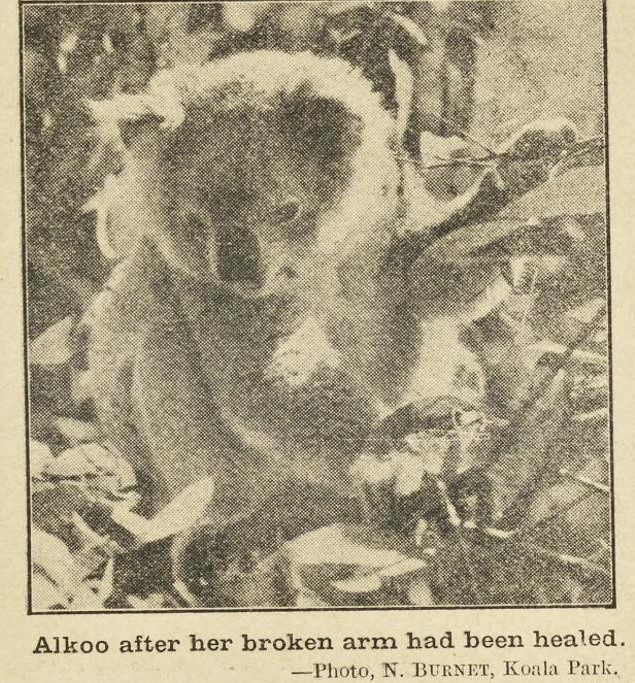
Alkoo after her broken arm had been heated. —Photo, N. BURNET, Koala Park.
The Secretary of the Koala Club, Mr. Edwards, had a telephone call late the next afternoon. Two children had found a baby koala at Palm Beach, sitting in a tree by the roadside, crying as if its heart would break. A dog was at the bottom of the tree barking at the poor little thing.
The children had carried Bunyarra home, but their parents did not want them to have him for a pet, for they knew how difficult it would be to get the right leaves for him.
Mr. Edwards, who will do anything to save a koala from pain or unhappiness, and who had heard all about Alkoo, thought that the koala the children had rescued must be Alkoo's baby. So he went off in his car, and found the house at Palm Beach where the children lived.
The children had gone to bed, but he was greeted by their mother. They had put Bunyarra in the tool shed for the night, but he had lolloped round and round, crying all the time. Mr. Edwards was taken to the boy’s bedroom, and there he saw a curly-headed boy with a little koala snuggled up against him, both sound asleep.
Mr . Edwards hated disturbing them, but he had motored a long way to fetch Bunyarra. The boy did not wake when Bunyarra was lifted gently from his bed, nor did Bunyarra till he was in the car, lying rolled up in a shawl on the seat. Then he began to cry his hardest, and he kept on crying until Mr. Edwards reached his home. He could not take him out to Koala Park that night. It was too late, so he put him in the washhouse, and arranged sticks so that he had a nice fork in which to sleep.
Bunyarra refused to use the perch provided for him, and sat in a corner and cried very loudly. This woke Mr. Edwards's little boy, who came running downstairs to see what was the matter.
“ I can make him stop crying,” he said at once. “Let me take him to bed.” He carried him upstairs and took him into bed with him, and there Bunyarra snuggled down against him and slept till the morning.
The next afternoon Bunyarra was taken out to Koala Park. Alkoo did not know how to express her joy when her baby was brought to her. The doctor was afraid Bunyarra would hurt his mother’s broken arm, but Alkoo would not be satisfied till she had smelled him all over, and combed out his coat as well as she could manage.
Then the Director of the Park took Bunyarra away, for he saw that he was going to be too much for Alkoo.
Now Bunyarra needed a mother to keep him in order by day and to cuddle him at night, and there was a very kind old granny, who badly needed a baby to look after.
The Director of the Park, Mr. Burnet, had had to punish old Booraby for stealing babies from their mothers. She had been shut up in the sun room for two days, and now he was glad to be able to give her Bunyarra to look after.
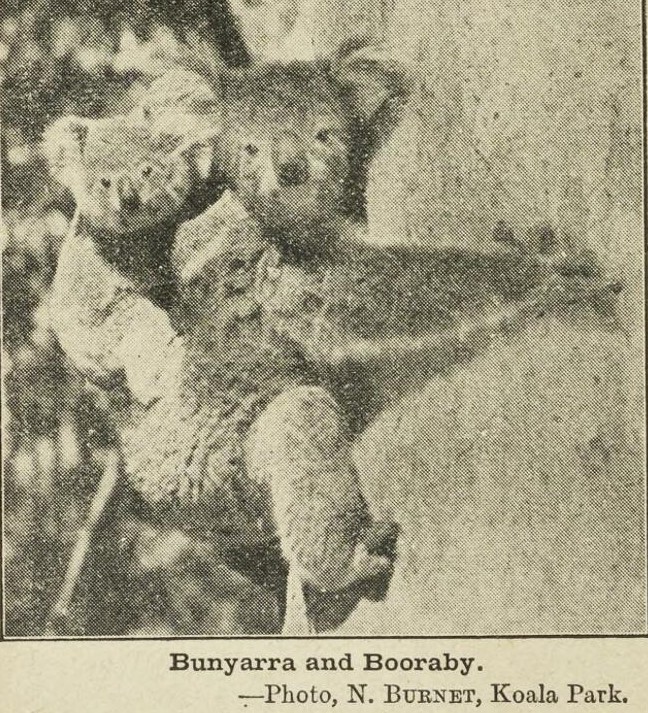
Bunyarra and Booraby. —Photo, N. BURNET, Koala Park.
She was so delighted and proud that she fetched all the best leaves for Bunyarra, and chose the best forks in the trees for sleeping. She had had four babies of her own, so she knew just how to cuddle Bunyarra.
But Bunyarra’s time with Granny Booraby was to end sooner than had been expected. As Bunyarra grew bigger and heavier his strong claws gripped Booraby’s fur too hard and pulled out great pieces, for, at seventeen, a koala’s fur is not nearly so close and strong as when she is young.
So a change of foster mothers had to be made, and Lallewoon, a young mother who had just brought up a baby, was chosen to look after Bunyarra. She had a splendid fur coat into which Bunyarra could put his claws and grip as hard as he liked without pulling out any tufts. Bunyarra was happy with Lallewoon, and was very popular at Koala Park, for he was the only young koala just then, and his adventures made visitors anxious to see him.
—From “Little Teddy Bear,” by LYDIA S. ELIOT. Price, 5/9. (Collins).
This book is recommended for school libraries. New South Wales. Department of Education. (). The school magazine of literature for our boys and girls September 1st, 1940, pages 115-118 Retrieved from http://nla.gov.au/nla.obj-774926280
Vale John Hamblin
March 18, 1935 – September 21, 2022.
 Known by his character names Funny John, or Naughty John, was an English-born Australian children's television presenter and actor of stage and screen who appeared in theatre productions, soap operas and made-for-TV films.
Known by his character names Funny John, or Naughty John, was an English-born Australian children's television presenter and actor of stage and screen who appeared in theatre productions, soap operas and made-for-TV films. Politics with Michelle Grattan: Professor Joseph Ibrahim on COVID in aged care – and the end of nursing homes

Joseph Ibrahim, Professor and Head, Health Law and Ageing Research Unit, Monash University, specialises in aged care issues. He has been a long-term advocate for improving the quality of life for those in residential care and for reform of the sector.
In this podcast, Ibrahim says currently COVID in aged care facilities is going largely unnoticed in the media. “If you have a look into the media coverage it would seem that it’s not a problem at all. [But] COVID deaths are far greater than at any time in the last two to three years”. While the vaccines have helped get things under control, the absence of restrictions is seeing infection rates at an all-time high. Ibrahim believes there should be a more tailored approach to outbreaks at facilities, depending on the circumstances.
A key election promise from Anthony Albanese was for a nurse on-site 24/7 in aged care facilities. Ibrahim is sceptical about how this will be achieved, given how many would be needed to meet the objective. “We would need 15,000 new nurses just to have one nurse in every facility, 24/7.”
More generally, in relation to the desperate staff shortages in the sector, Ibrahim says there is a “lack of respect” for aged care workers, citing low pay, the treatment they are given compared to healthcare professionals in hospitals, and the lesser opportunities for a career path.
Home care packages are key to the ability of many older people to stay at home. “I don’t think we’re keeping people at home for as long as we could […] Both governments have addressed and increased the amount of support packages available. The issue with that is, the package may be available, but the staff aren’t there to deliver on what’s within that package”. In some cases “I think people want to stay at home because they’re fearful of going into residential care, and so residential care isn’t seen as an option, it’s seen as a last resort”.
More radically, Ibrahim would like to see the end of nursing homes altogether. “We shouldn’t be having nursing homes at all […] do we believe that orphanages are a good way to look after children who have fractured family or who don’t have parents?”
One alternative to nursing homes would be “you might have small communal housing that might have five to ten people in them”.
“Or there are design changes around what you do when you get to 60, 70 or 80 in terms of downsizing and moving into a home that is more likely to meet your needs […] There’s also shared communal housing with people of different ages and different needs.
"I think we’ve been very lazy in just relying on aged care homes as a solution. So we’ve picked a lazy solution and we’re doing it badly.”![]()
Michelle Grattan, Professorial Fellow, University of Canberra
This article is republished from The Conversation under a Creative Commons license. Read the original article.
Entry Milestone Reached In First Pan Pacs Since 2018

U3A: Hippies Concert
- A day trip to Mount Wilson on 5 October (details on page 9);
- Our annual picnic on 20 October, this year at Clontarf Reserve (details on page 10); and
- Tunnels and Gunners Tour, with a guide from the Sydney Harbour Trust, on 3 November (details on page 10.


Remembering Kokoda
New Residential Aged Care Quality Indicators
- Activities of daily living – Percentage of care recipients who experienced a decline in activities of daily living
- Incontinence care – Percentage of care recipients who experienced incontinence associated dermatitis
- Hospitalisation – Percentage of care recipients who had one or more emergency department presentations
- Workforce – Percentage of staff turnover
- Consumer experience – Percentage of care recipients who report ‘good’ or ‘excellent’ experience of the service
- Quality of life – Percentage of care recipients who report ‘good’ or ‘excellent’ quality of life.
- start collecting new quality indicators in the April – June 2023 quarter
- submit quality indicator data in the 1 – 21 July 2023 reporting period.
Updated Dementia In Australia Report Released
- 1 in 2 provided an average of 60 or more hours of care per week.
- 3 in 4 reported 1 or more physical or emotional impacts of the role.
- 1 in 4 reported that they needed more respite care to support them.
- 1 in 2 experienced financial impacts since taking on the role.
- developing dementia
- experiencing higher dementia prevalence
- a greater number of years lived with a disability when compared with non-Indigenous Australians.
Men's Sheds Grants And Movember Improving Men's Health
Why wandering albatrosses get divorced – new research
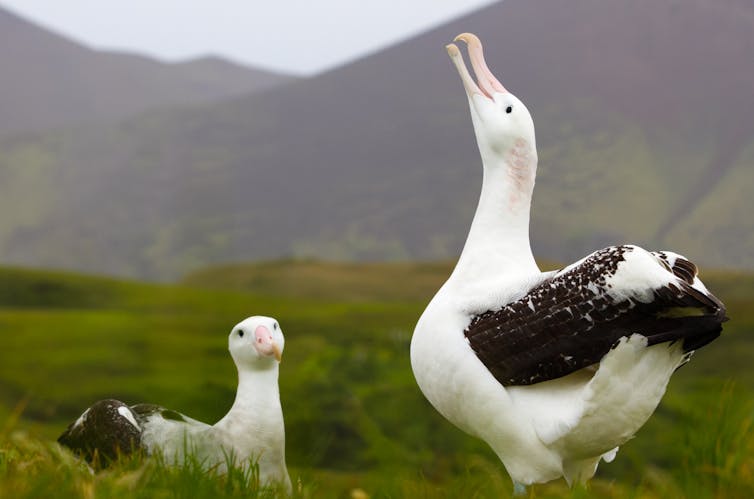
Monogamy is widespread among birds and it is well known that many seabird species mate for life. Famous examples include charismatic penguins and albatrosses which are often portrayed in the media as the perfect couples. But this romantic trope doesn’t tell the whole story.
Research has shown that up to 24% of wandering albatross chicks are reared by a male who is not their genetic father and this can be up to 31% in some penguin species. Not quite the tender idyll we are led to believe.
Seabirds are long-lived, with wandering albatrosses known to live for over 60 years. Their long pair bonding phase, accompanied by complex courtship dances, would make you think break ups should be rare. However, there is growing evidence seabirds do “divorce”.
In our new study we showed 13% of wandering albatrosses born on the remote Indian Ocean Crozet Archipelago divorce during their lifetime because of low numbers of females – and the actions of certain agressive males.
Sometimes birds split up to find a better mate. How birds assess mate quality is not fully understood. But it may be about age and behavioural traits the birds can observe. This is called adaptive divorce and has been noted in some seabird species before such as penguins.
But in our study something different was happening. Unlike some other birds divorce did not tend to increase the number of young a wandering albatross reared and didn’t seem to give them evolutionary advantages.
In the population we studied, couples were driven apart by what’s called forced divorce. This is where one bird, likely the males in our study, breaks up a bonded pair.
Show Some Personality
This was the first study in the wild which looked at behavioural characteristics such as aggression of these kind of “homewrecker” males.
Personality is well studied across the animal kingdom, from anemones to elephants. We know that seabirds have different personalities, linked to their foraging behaviour and reproductive success. Personality is defined as a consistent individual difference in behaviour and is measured using traits such as boldness, neophobia (fear of new things) and aggression.
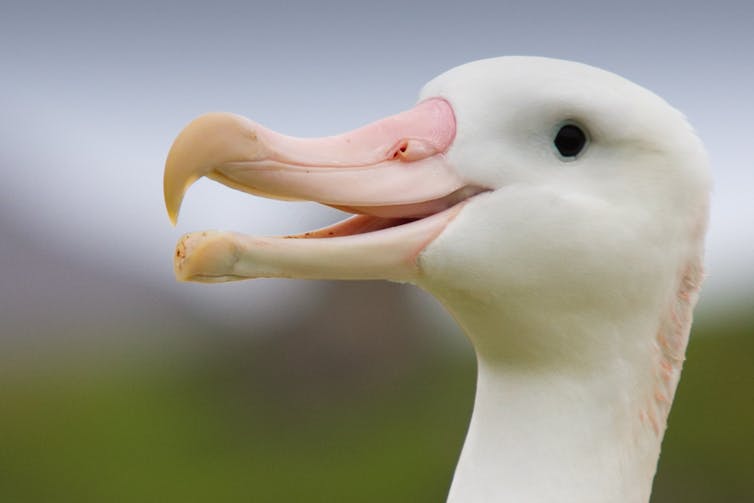
In wandering albatrosses, we measured personality in two different ways. The first is what is called a human approach, where a person walks towards a bird incubating an egg on the nest and records its response. Males and females share incubation duties and both sexes can be tested in this way. The birds nest on marshy land so the tester had to wear snow shoes to avoid sinking.
We also tested how the birds responded to a novel object, in this case Betsy the space hopper cow. Unfortunately for Betsy, while the personality differences persisted among different birds, the albatrosses were all much more aggressive towards her. Betsy did not survive an attack late in the season when a particularly bold bird ripped her open.
The albatrosses ranged from shy ones, who showed no response, to dauntless types that stood up and called out. Bold females were no more likely to divorce than timid ones. However, shyer males had higher divorce rates suggesting that bolder males may be forcing timid males out of pair bonds.
Unpaired females are rare. The Crozet albatross population is male skewed because more females die trapped in fishing equipment. Males and females have different hunting strategies that change throughout their life. For instance, as males mature, they move increasingly further south to Antarctic waters. Females stay in subtropical waters throughout their lives, and forage areas further north.
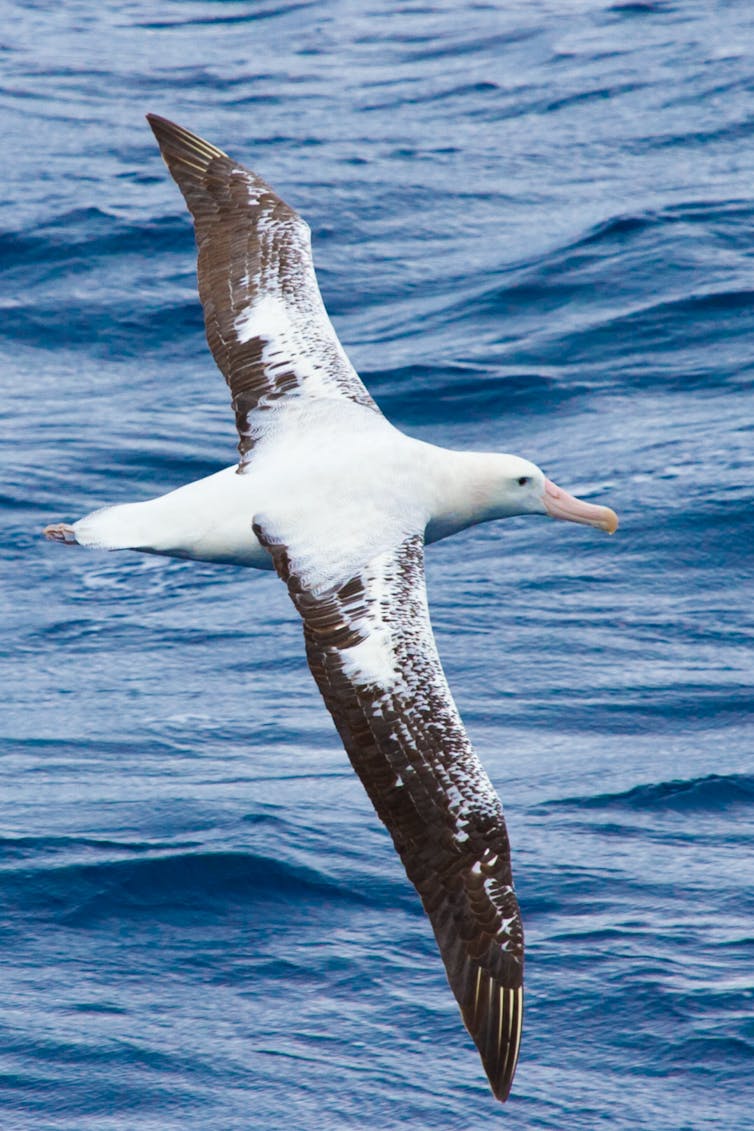
In a previous study we showed divorced wandering albatrosses do not have more chicks so females are unlikely to benefit from seeking new mates. This supports the theory that wandering albatross pairs are not choosing to divorce. Instead, it seems to be a few rogue males who are ending the partnerships of these otherwise monogamous birds.![]()
Samantha Patrick, Reader in Marine Biology, University of Liverpool
This article is republished from The Conversation under a Creative Commons license. Read the original article.
Alzheimer’s might not be primarily a brain disease. A new theory suggests it’s an autoimmune condition.

The pursuit of a cure for Alzheimer’s disease is becoming an increasingly competitive and contentious quest with recent years witnessing several important controversies.
In July 2022, Science magazine reported that a key 2006 research paper, published in the prestigious journal Nature, which identified a subtype of brain protein called beta-amyloid as the cause of Alzheimer’s, may have been based on fabricated data.
One year earlier, in June 2021, the U.S. Food and Drug Administration had approved aducanumab, an antibody-targeting beta-amyloid, as a treatment for Alzheimer’s, even though the data supporting its use were incomplete and contradictory. Some physicians believe aducanumab never should have been approved, while others maintain it should be given a chance.
With millions of people needing an effective treatment, why are researchers still fumbling in this quest for a cure for what is arguably one of the most important diseases confronting humankind?
Escaping The Beta-Amyloid Rut
For years, scientists have been focused on trying to come up with new treatments for Alzheimer’s by preventing the formation of brain-damaging clumps of this mysterious protein called beta-amyloid. In fact, we scientists have arguably got ourselves into a bit of an intellectual rut concentrating almost exclusively on this approach, often neglecting or even ignoring other possible explanations.
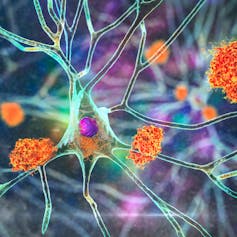
Regrettably, this dedication to studying the abnormal protein clumps has not translated into a useful drug or therapy. The need for a new “out-of-the-clump” way of thinking about Alzheimer’s is emerging as a top priority in brain science.
My laboratory at the Krembil Brain Institute, part of the University Health Network in Toronto, is devising a new theory of Alzheimer’s disease. Based on our past 30 years of research, we no longer think of Alzheimer’s as primarily a disease of the brain. Rather, we believe that Alzheimer’s is principally a disorder of the immune system within the brain.
The immune system, found in every organ in the body, is a collection of cells and molecules that work in harmony to help repair injuries and protect from foreign invaders. When a person trips and falls, the immune system helps to mend the damaged tissues. When someone experiences a viral or bacterial infection, the immune system helps in the fight against these microbial invaders.
The exact same processes are present in the brain. When there is head trauma, the brain’s immune system kicks into gear to help repair. When bacteria are present in the brain, the immune system is there to fight back.
Alzheimer’s As Autoimmune Disease
We believe that beta-amyloid is not an abnormally produced protein, but rather is a normally occurring molecule that is part of the brain’s immune system. It is supposed to be there. When brain trauma occurs or when bacteria are present in the brain, beta-amyloid is a key contributor to the brain’s comprehensive immune response. And this is where the problem begins.
Because of striking similarities between the fat molecules that make up both the membranes of bacteria and the membranes of brain cells, beta-amyloid cannot tell the difference between invading bacteria and host brain cells, and mistakenly attacks the very brain cells it is supposed to be protecting.
This leads to a chronic, progressive loss of brain cell function, which ultimately culminates in dementia — all because our body’s immune system cannot differentiate between bacteria and brain cells.
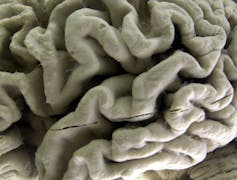
When regarded as a misdirected attack by the brain’s immune system on the very organ it is supposed to be defending, Alzheimer’s disease emerges as an autoimmune disease. There are many types of autoimmune diseases, such as rheumatoid arthritis, in which autoantibodies play a crucial role in the development of the disease, and for which steroid-based therapies can be effective. But these therapies will not work against Alzheimer’s disease.
The brain is a very special and distinctive organ, recognized as the most complex structure in the universe. In our model of Alzheimer’s, beta-amyloid helps to protect and bolster our immune system, but unfortunately, it also plays a central role in the autoimmune process that, we believe, may lead to the development of Alzheimer’s.
Though drugs conventionally used in the treatment of autoimmune diseases may not work against Alzheimer’s, we strongly believe that targeting other immune-regulating pathways in the brain will lead us to new and effective treatment approaches for the disease.
Other Theories Of The Disease

In addition to this autoimmune theory of Alzheimer’s, many other new and varied theories are beginning to appear. For example, some scientists believe that Alzheimer’s is a disease of tiny cellular structures called mitochondria — the energy factories in every brain cell. Mitochondria convert oxygen from the air we breathe and glucose from the food we eat into the energy required for remembering and thinking.
Some maintain that it is the end-result of a particular brain infection, with bacteria from the mouth often being suggested as the culprit. Still others suggest that the disease may arise from an abnormal handling of metals within the brain, possibly zinc, copper or iron.
It is gratifying to see new thinking about this age-old disease. Dementia currently affects more than 50 million people worldwide, with a new diagnosis being made every three seconds. Often, people living with Alzheimer’s disease are unable to recognize their own children or even their spouse of more than 50 years.
Alzheimer’s is a public health crisis in need of innovative ideas and fresh directions. For the well-being of the people and families living with dementia, and for the socioeconomic impact on our already stressed health-care system coping with the ever-escalating costs and demands of dementia, we need a better understanding of Alzheimer’s, its causes, and what we can do to treat it and to help the people and families who are living with it.![]()
Donald Weaver, Professor of Chemistry and Director of Krembil Research Institute, University Health Network, University of Toronto
This article is republished from The Conversation under a Creative Commons license. Read the original article.
Why does nature create patterns? A physicist explains the molecular-level processes behind crystals, stripes and basalt columns
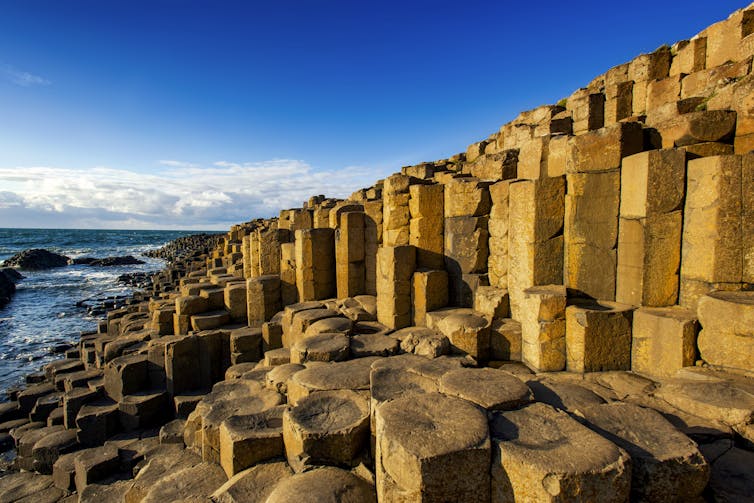

Curious Kids is a series for children of all ages. If you have a question you’d like an expert to answer, send it to curiouskidsus@theconversation.com.
Why does nature always create a pattern? – Saloni G., age 16, Alwar, Rajasthan, India
The reason patterns often appear in nature is simple: The same basic physical or chemical processes occur in many patterned substances and organisms as they form. Whether in plants and animals or rocks, foams and ice crystals, the intricate patterns that happen in nature come down to what’s happening at the level of atoms and molecules.
A pattern in nature is any regularly repeated arrangement of shapes or colors. Some of the most striking examples include the hexagonal arrays of rocks at Giant’s Causeway in the United Kingdom, the beautiful fractal arrangements of florets on a Romanesco broccoli and the colorful stripes and spots on tropical fish.
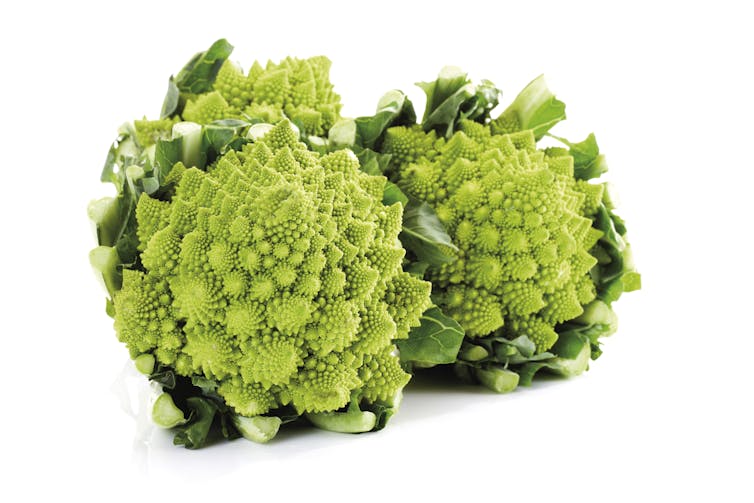
Patterns like these begin to form at a small scale when materials undergo processes like drying, freezing, wrinkling, diffusing and reacting. Those changes then give rise to complex patterns at a larger scale that people can see.
Patterns In Ice And Rock
Imagine delicate frozen crystals on a windowpane during a cold day. What creates that pattern?
When water freezes, its molecules begin clustering together. Water molecules have a particular bent shape that causes them to stack into clusters shaped like hexagons as they freeze.
As the cluster grows, many outside factors, including humidity and temperature, begin to affect its overall shape. If the water is freezing on a windowpane, for example, small and random imperfections on the glass surface redirect the stacking and create the larger pattern.

This same process of stacking molecules is responsible for the striking variety of snowflake shapes.
What about the amazing patterns of the basalt columns at Giant’s Causeway? These formed 50 million to 60 million years ago, as lava – hot rocky fluid from deep underground – rose to the Earth’s surface and began to lose heat. The cooling caused the top layer of basalt to contract. The deeper, hot layers resisted this pulling, creating cracks in the top layer.
As the lava cooled, the cracks spread deeper and deeper into the rock. The particular molecular qualities of basalt, as well as the basic physics of how materials fracture apart – laws of physics universal to all substances on Earth – caused the cracks to meet up with one another at certain angles to create hexagons, much like the stacking water molecules.
Eventually, the cooling basalt broke into the hexagon-shaped columns of rock that still create such an impressive pattern millions of years later.
Patterns In Animals
The creation of complex patterns in living organisms also begins with simple mechanisms at the molecular level. One important pattern-making process involves the way diffusing chemicals react with one another.
Imagine how a drop of food coloring spreads in a glass of water – that’s diffusion.

In 1952, English mathematician Alan Turing showed that a chemical spreading like this within another chemical can lead to the formation of all kinds of patterns in nature.
Scientists have proved that this process reproduces the patterns of a leopard’s spots, a zebra’s stripes and many other animal markings.
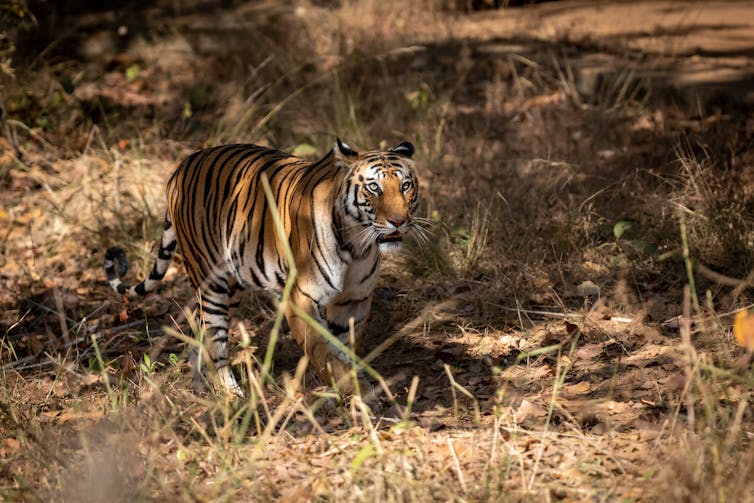
What makes these markings consistent from generation to generation? As animal species evolved, these chemical reactions evolved with them and became part of their genetic codes. This might be because the markings helped them survive. For example, a tiger’s stripes camouflage it while hunting in a forest or grassland, making it easier to surprise and catch its prey.
However, researchers are still working out the details of which particular chemicals are involved.
Scientists do not always know the purpose of a pattern, or even if there is one. The molecular processes involved are simple enough that they might coincidentally generate a pattern.
For example, in my research team’s work studying plant pollen grains, we have seen a huge variety of patterns, including spikes, stripes and many more.

We don’t yet understand why a plant produces one particular pollen pattern rather than another. Whatever the ultimate use this and other patterns in nature may have, their variety, complexity and order are amazing.
Hello, curious kids! Do you have a question you’d like an expert to answer? Ask an adult to send your question to CuriousKidsUS@theconversation.com. Please tell us your name, age and the city where you live.
And since curiosity has no age limit – adults, let us know what you’re wondering, too. We won’t be able to answer every question, but we will do our best.![]()
Maxim Lavrentovich, Assistant Professor of Theoretical Biophysics, University of Tennessee
This article is republished from The Conversation under a Creative Commons license. Read the original article.
Explainer: Socrates and the life worth living

Socrates was notoriously annoying. He was likened to a gadfly buzzing around while one is trying to sleep. The Oracle of Delphi declared him the wisest of all human beings. His life and death would go on to shape the history of Western thought.
And yet he proclaimed to know nothing. The genius of Socrates lay in his professed ignorance of what it means to be human.

Socrates (469-399 BCE) grew up in Athens over two and half thousand years ago. At the time, the Athenians were recovering from a devastating war with the Persians. As they rebuilt, the military general and politician, Pericles, championed democracy as the form of government to bring Greece into its Golden Age.
The Athenians practised a direct (as opposed to representative) form of democracy. Any male over the age of 20 was obligated to take part. The officials of the assembly were randomly selected through a lottery process and could make executive pronouncements, such as deciding to go to war or banishing Athenian citizens.
The Athens of Pericles flourished. Bustling crowds of traders from around the Mediterranean gathered at the port of Piraeus. In the Athenian agoras – the central marketplaces and assembly areas – the active social and political lives of the Athenian citizens would inspire the mind of Socrates.
Socrates At War
Alcibiades, who would go on to become a prominent Athenian statesman and general, recounts a story of what might be a pivotal moment in the development of Socrates’ thinking.
One morning during the campaign of Potidaea, Socrates became transfixed by a problem that he could not seem to solve. An entire day passed and Socrates had still not moved. In awe, and probably curious to see how long he could keep it up, his fellow soldiers moved their beds outside to watch him during the night. It was not until dawn the next morning that Socrates said a prayer to the new day and walked away.

Jonathan Lear argues in his Tanner Lectures that Socrates is not just standing still because he is lost in thought; he is standing still because he cannot walk. He is standing “not knowing what his next step should be”. Socrates wants to move in the right direction, but does not know what direction that is.
We will never know what Socrates was thinking about. But after standing still and thinking, he appears to have become invigorated. Alcibiades tells us that in the battle that followed Socrates saved his life. For the remainder of the campaign, Socrates fought with a fierceness and bravery that exemplified true courage.
Socrates The Gadfly
Socrates never wrote anything down. He hungered for the lively exchange of ideas and believed that writing only served to imprison a thought in letters. He argued that the written word shared a strange quality with paintings. Both appear to us “like living beings, but if one asks them a question, they preserve a solemn silence”.
Much of what we know of Socrates’ activities and conversations, and his death, was recorded by his devoted student Plato. Scholarly debate continues about just how much of Plato’s written record of Socrates’ interrogations we can attribute to Socrates himself. At some point in the Platonic corpus, Socrates becomes a mouthpiece for Plato’s own ideas, but no one can agree precisely when.
Socrates was unsure of what to make of being called the wisest of all human beings. He dedicated his time to questioning fellow Athenians about the nature of things, interrogating ideas such as friendship, love, justice and piety. He was searching for what he believed to be the highest good: knowledge.
The gadfly could show up anywhere. In Plato’s Euthyphro, for example, Socrates bumps into Euthyphro, who is on his way to court about to prosecute his father:
What strange thing has happened, Socrates, that you have left your accustomed haunts in the Lyceum and are now haunting the portico where the king archon sits?
Socrates is intrigued by Euthyphro’s legal case, and so begins his inquiry:
do you think your knowledge about divine laws and holiness […] is so exact that […] you are not afraid of doing something unholy yourself in prosecuting your father for murder?
Almost every Socratic dialogue is centred around Socrates’ recognition of his own ignorance. In Euthyphro, the subject he interrogates is piety. What follows adheres to a structure shared by most of the other dialogues, which is known as elenchus or the Socratic method.
Its basic form is as follows:
Socrates engages an interlocutor who appears to possess knowledge about an idea
the interlocutor makes an attempt to define the idea in question
Socrates asks a series of questions which test and unravel the interlocutor’s definition
the interlocutor tries to reassemble their definition, but Socrates repeats step three
both parties arrive at a state of perplexity, or aporia, in which neither can any further define the idea in question.
We can gain a sense of the frustration that this caused some of Socrates’ unwilling victims. Take the final lines of his encounter with Euthyphro as an example:
Socrates: Then don’t you see that now you say that what is precious to the gods is holy? And is not this what is dear to the gods?
Euthyphro: Certainly.
Socrates: Then either our agreement a while ago was wrong, or if that was right, we are wrong now.
Euthyphro: So it seems.
Socrates: Then we must begin again at the beginning and ask what holiness is. Since I shall not willingly give up until I learn. […]
Euthyphro: Some other time, Socrates. Now I am in a hurry and it is time for me to go.
In Meno, another of Plato’s dialogues, Socrates likens the sting of aporia to that of an electric stingray:
I find you are merely bewitching me with your spells and incantations, which have reduced me to utter perplexity. And if I am indeed to have my jest, I consider that both in your appearance and in other respects you are extremely like the flat torpedo sea-fish; for it benumbs anyone who approaches and touches it, and something of the sort is what I find you have done to me now. For in truth I feel my soul and my tongue quite benumbed, and I am at a loss what answer to give you.
Throughout the dialogues, Socrates demonstrates the disruptive and disorientating experience of aporia, which emerges from philosophical activity. Reflecting upon the declaration of the Oracle of Delphi, we learn that Socrates was wise because, unlike his interlocutors, he did not proclaim to know what he was ignorant of.
Corrupting The Youth And Replacing The Gods
In the early days of democracy and in a society which was rapidly expanding, one would think that a revolutionary thinker like Socrates would be a highly prized instrument of intellectual progress. But not everyone appreciated the disorientating sting of the gadfly’s thinking.
Plato would later comment on how the Athenians – and perhaps societies in general – react when faced with the disruptive force of critical reflection.
His famous allegory of the cave, which forms part of his Republic, is in many ways the story of a philosopher – the story of his great teacher, Socrates.
The allegory begins with prisoners locked in a cave. All the prisoners can see are the shadows of the passing guards reflected on the wall, and the echoes of the world behind them. This is the condition of a society content with the mere illusions of knowledge, a society that is unreflective and stagnant.
One prisoner manages to escape. Turned towards the entry of the cave, he first notices the brightness of the light – like knowledge, the light is uncomfortable and disruptive after years of contentment with shadows.
Escaping the cave, the prisoner
can see the reflections of people and things in water and then later see the people and things themselves. Eventually, he is able to look at the stars and moon at night until finally he can look upon the sun itself.
Only after he is able to look straight at the “sun itself” – i.e. knowledge of what is good – “is he able to reason about it” and what it is. The freed prisoner, argues Plato, would realise that life outside is far superior to being inside the cave. He would return and encourage the prisoners to free themselves and look around. But the comfort of their belief in the world of shadows and echoes is a strong force to overcome.
Plato says that the prisoners, fearing what awaits outside of the cave, would react violently towards the freed prisoner – even killing him in order to keep the peace.
This was Socrates’ fate.

When the citizens of Athens had finally had enough of Socrates’ pestering questions, they banded together and accused him of corrupting the youth and attempting to replace the old gods.
He was imprisoned. His followers planned an escape, but he refused. Socrates questioned what was to be gained by escaping. Life itself is not ultimately valuable – surely, he says, it is a good and just life that we ultimately value. If he were to escape, he would only be tarnishing his good life with an act of vengeance against the misinformed Athenian citizens. He had nothing to gain by escaping. He could only preserve the harmony of his own soul by accepting his fate.
In his final stand in front of the Athenian judges, Socrates denies all charges. His only crime was forcing Athenians to think:
If again I say that to talk every day about virtue and the other things about which you hear me talking and examining myself and others is the greatest good to man, and that the unexamined life is not worth living, you will believe me still less.
If you are to put me to death, warns Socrates, you will not easily find another like me. Striking dead the gadfly of Athens is easy, but “then you would sleep on for the remainder of your lives, unless the god in his care of you gives you another gadfly”.
But the judges had made up their minds. The majority voted that Socrates would be executed by drinking hemlock.
Socrates teaches us that philosophical contemplation prepares us for the good life. The experience of aporia – in all of its discomfort and disruption – is the very catalyst of wonder. The philosopher, the lover of wisdom, is anyone who dares to escape the cave and look upon the sun, anyone who lives for the values Socrates died for.![]()
Oscar Davis, Lecturer in Philosophy and History, Bond University
This article is republished from The Conversation under a Creative Commons license. Read the original article.
For the first time, robots on Mars found meteorite impact craters by sensing seismic shock waves
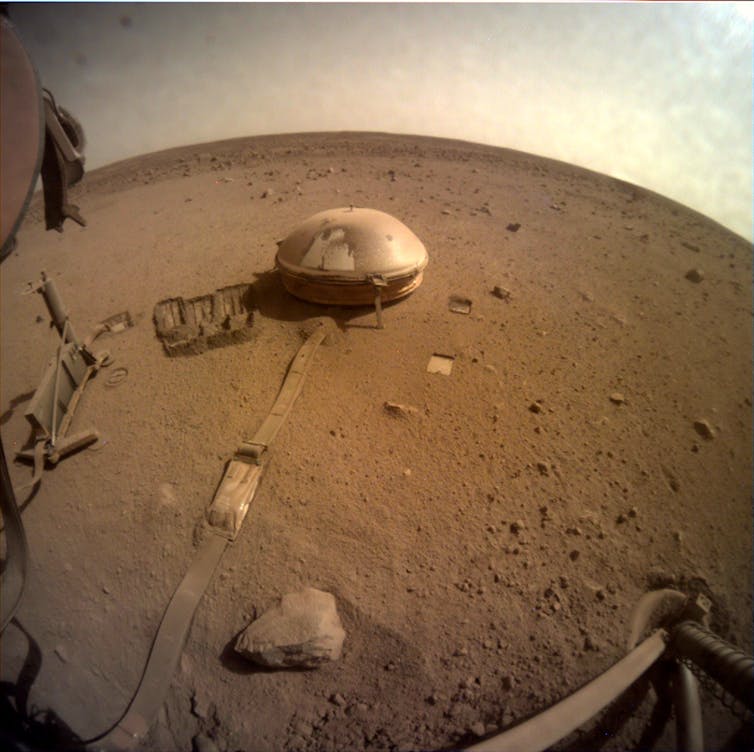
Since 2018, NASA’s InSight mission to Mars has recorded seismic waves from more than 1,300 marsquakes in its quest to probe the internal structure of the red planet. The solar panels of the car-sized robotic lander have become caked with Martian dust, and NASA scientists expect it will completely power down by the end of 2022.
But the internal rumblings of our planetary neighbour aren’t the only things that InSight’s seismometers detect: they also pick up the thuds of space rocks crashing into the Martian soil.
In new research published in Nature Geoscience, we used data from InSight to detect and locate four high-speed meteoroid collisions, and then tracked down the resulting craters in satellite images from NASA’s Mars Reconnaissance Orbiter.
Rocks From Space
The Solar System is full of relatively small rocks called meteoroids, and it’s common for them to collide with planets. When a meteoroid encounters a planet with an atmosphere, it heats up due to friction – and may burn up entirely before reaching the ground.
On Earth, we know these incoming meteoroids as shooting stars, or meteors: beautiful events to observe in the night sky. Sometimes a meteoroid explodes when it reaches the thicker atmosphere closer to the ground, creating a spectacular airburst.
Occasionally, a space rock survives its fiery path through the air and drops to the ground, where it is known as a meteorite.
A few of these meteorites hit the surface at such speed they blast a hole in the ground called an impact crater. Compared to a human lifetime, these events are very rare on Earth.
Recording Space Rock Impacts
Scientists have detected the vibrations from meteoroid airbursts using seismic detectors numerous times, including a recent survey of bright meteors above Australia.
However, only once has a high-speed space rock crashing into the ground been observed both visually and with modern seismic equipment. This was an impact crater that formed in 2007 near the village of Carancas in Peru.
Numerous impacts were detected on the Moon by the network of seismic sensors set up during the US Apollo missions of the 1960s and ’70s. However, there was no recording of a natural impact associated with visual detection of a new crater.
The closest things to such an observation were artificial impacts: the crash-landings of the booster rockets of the ascent modules that lifted Apollo astronauts off the Moon.
These human-made impacts on the Moon were recorded both in seismic data and visual imagery from orbit. These data were recently used to test simulations of how impacts produce seismic waves.
Martian Meteorites
Incoming meteoroids make waves in the atmosphere and also the ground. The atmosphere of Mars is equivalent to 1% of the Earth’s, and has a different chemical composition. This means meteor events on Mars take a different form.
For meteor events large enough to drop a meteorite, the fate of the meteorite and any resulting crater is different from what we have come to expect on our home planet.
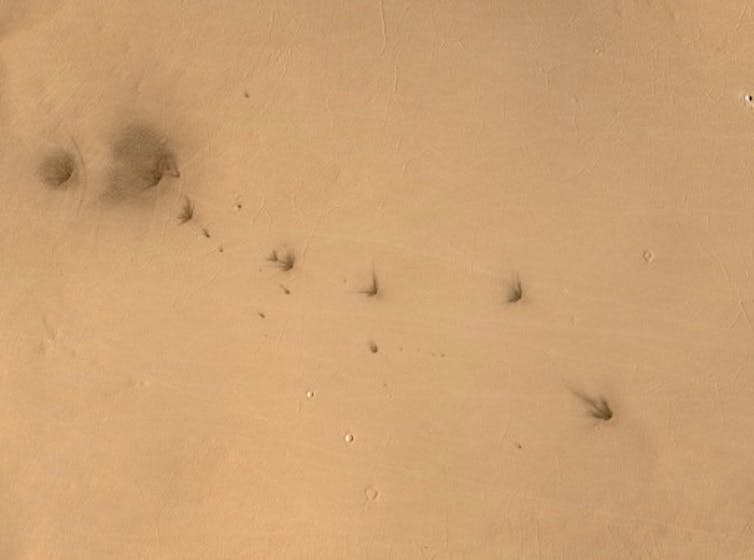
Here on Earth, or on the Moon, single craters are the norm. On Mars, however, about half the time a high-speed space rock will burst in the atmosphere shortly before impact, resulting in a tightly grouped cluster of craters.
The separation of these individual fragments remains close at ground level, forming a cluster of small impacts.
From Vibrations To Craters
Recently, the InSight mission has observed acoustic and seismic waves from four meteoroid impact events. These waves travel at different speeds, and comparing their different arrival times and other properties allowed us to estimate the location of the impacts.
These impact locations were then confirmed with satellite imaging from the Mars Reconnaissance Orbiter.
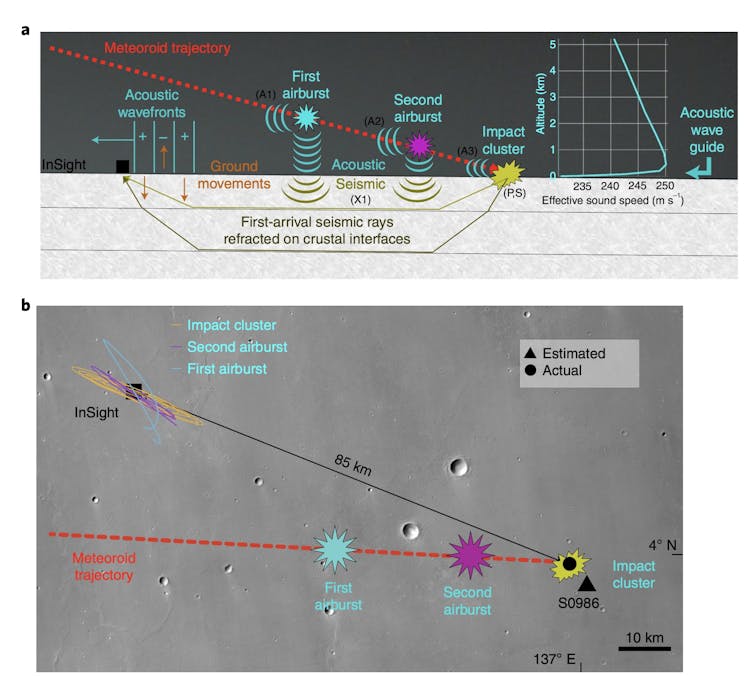
Knowing the size and exact location of these impact craters helps us calculate the size and speed of the incoming space rock and how much energy the impact released.
Once we are confident we know something about the impact that created the seismic waves we detected, we can use the waves to learn about the interior of Mars. What’s more, when we compare seismic observations on Mars with observations from Earth and the Moon, we can learn more about how the planets formed and how the Solar System evolved.![]()
Katarina Miljkovic, ARC Future Fellow, School of Earth and Planetary Sciences, Curtin University
This article is republished from The Conversation under a Creative Commons license. Read the original article.
10 months and hundreds of subjects: how I took portrait photography to the streets of Parramatta

For the past ten months, I have photographed hundreds of people in the Western Sydney suburb of Parramatta for a portrait project called Being Together: Parramatta Yearbook.
The portraits in the yearbook show the people who live, work and play in Parramatta against the backdrop of an ever-changing city.
The way a photographer and subject come together to make a portrait is usually invisible in a portrait.
Here, instead of trying to reveal the elusive individuality of a person, I have been focusing on the social dynamics of portraiture – what happens behind the scenes between me and the people I’m photographing.

As Daniel Palmer notes in his book Photography and Collaboration, portraiture is by definition relational and collaborative. That is, the process of photographic portraiture inherently brings the photographer and subjects together to arrive at an image.
In the context of this project, coming together for a portrait creates playful opportunities for social interactions among strangers.

It is amazing what strangers will share with me in the space of five minutes.
Two men reveal they are brothers and haven’t seen each other for ten years.
One woman tells me she thinks she’s ugly and asks me to make her look beautiful.
Another keenly describes the floral wonders she is holding from her community garden.
One man whispers that he can’t speak English.
Another tells me he’s in a hurry to go to lunch.

We chat about the everyday things, the weather, COVID, shopping and Rugby League.
There are stories of time spent in jail, and lives being turned around.
New arrivals to Australia speak of their family in lands faraway and citizens who have lived all their lives in Parramatta share insights on the city.
These are the stories photography can’t capture in the silent stillness of the image, but that’s no reason not to continue.
Performing Photography
Setting up a studio in the street and inviting people to pose together in front of the camera is a thing to see. We always had audiences of passersby watching and it wasn’t long before they were also in front of the camera.
If you look closely at the portraits there are talkative details and warm gestures: micro-movements of the body where people touch each other or hold hands; the spaces between our bodies; instances when we are caught by the camera laughing, chatting and applying lipstick.

I also see myself in action. I am both photographer and subject, a stranger dressed in red, wanting desperately to be with people, to steer them through a photographic moment, to pose and be uncomfortable together.
When people have their portraits made I want to know whether they enjoyed it or found it excruciating and awkward. After the photo is taken, we walk up to the laptop tethered to the camera and look at the photographs. They indicate which portraits they like and hate. I listen and take notes.
Involving people in the selection process creates instant trust.
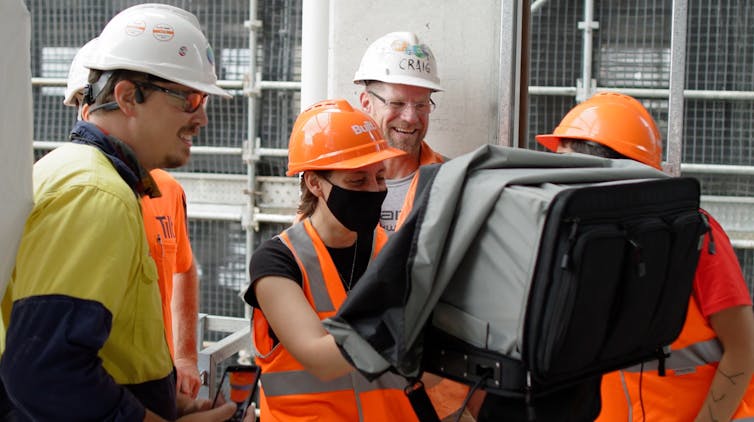
In bringing people together before a camera, I became acutely aware of photography’s potential to foster social inclusion, social participation, visibility and a sense of belonging and connection to one’s place and people.
Photography is something we all do. It is familiar and familial. Group portraits activate a social encounter and conversation, listening and storytelling.
The social experience of photography is also extended through time. After the photographs have been taken and printed, they are displayed as a collage on a large scale photo wall in the heart of Parramatta in Centenary Square. I love watching people looking for themselves or pointing to familiar faces.

As one passerby declared on seeing the photo wall:
Thanks for treating everyone the same, like we belong and are as deserving of recognition and dignity as others, instead of excluding us from being visible.
This feedback goes to the heart of the project that welcomed people from all walks of life to offer a view of Western Sydney that is far from the media stereotypes.
Fundamentally, the Parramatta Yearbook acts as a model for how cultural institutions and government can work together with artists to record and reflect community, create a sense of belonging and produce narratives about a place in transition that foregrounds the creativity of its citizens ahead of urban development.
The Parramatta Yearbook portraits are on public display in Parramatta’s Centenary Square until October 3, as well as in a 88-page downloadable yearbook from the Museum of Contemporary Art.![]()
Cherine Fahd, Associate Professor of Visual Communication in the School of Design, University of Technology Sydney
This article is republished from The Conversation under a Creative Commons license. Read the original article.
Hayao Miyazaki’s ‘Spirited Away’ continues to delight fans and inspire animators 20 years after its US premiere
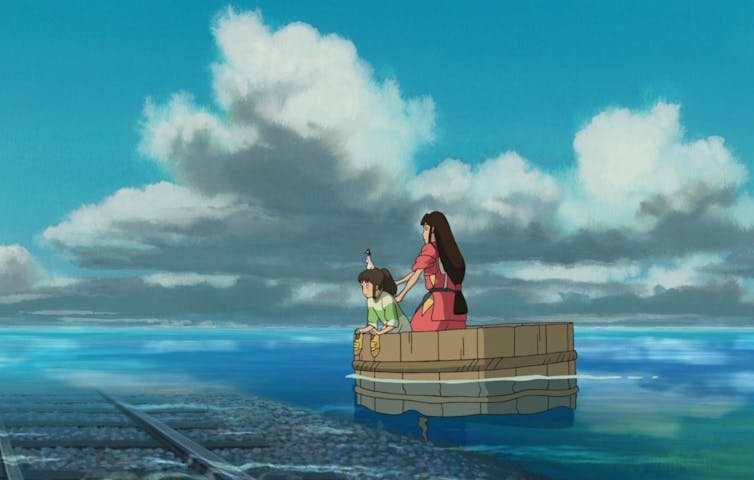
When Hayao Miyazaki’s animated feature “Spirited Away” premiered in the U.S. 20 years ago, most viewers hadn’t seen anything like it.
Disney distributed the film. But as one critic pointed out, “Seeing just 10 minutes of this English version … will quickly disabuse any discerning viewer of the notion that it is a Disney creation.”
It tells the story of a 10-year-old girl named Chihiro who, when traveling with her parents, stumbles across what appears to be an abandoned theme park. As they explore, the parents are transformed into giant pigs, and Chihiro soon realizes that the park is occupied by strange, supernatural spirits. She ends up working at a bathhouse as she tries to figure out a way to free herself and her parents so they can return home.
The film went on to win an Oscar for Best Animated Feature. Twenty years later, it’s frequently listed as one of the best animated films of all time.
Yet as a scholar of manga and anime studies, I’m often struck by how popular the film became – and how fondly viewers remember it – given that so many of its elements would have been alien to American audiences.
The Manga Revolution
Many of the first anime films were inspired by manga, or Japanese comics.
Some of the hallmarks of modern manga, such as characters with big eyes, streaks to signal movement and different-sized panels to convey action, character and emotion more effectively, can be traced to the work of Osamu Tezuka, the so-called “God of Manga.”
Tezuka was influenced by his childhood and Japanese culture, but he was also inspired by American movies, television and comics.
When Tezuka was a child, he attended the performances of Takarazuka, an all-female theater group in Tokyo whose actresses tended to have well-lit, expressive eyes. His father also showed him American animation on a Pathe projector, and he was drawn to wide-eyed characters like Betty Boop and Bambi. Together, they inspired the big, expressive eyes that would become characteristic of Tezuka’s work.
Tezuka’s debut manga, titled “New Treasure Island,” was published in 1947 and became a hit with Japanese youth. Soon an entire manga industry sprang up, churning out vibrantly creative and emotionally relatable comics in a wide range of genres.
Miyazaki was 21 years old when Tezuka’s popular manga “Astro Boy” appeared on TV in Japan in 1963. NBC soon picked it up, airing 102 episodes in the U.S. and exposing millions of Americans to Japanese anime for the first time.
Over the ensuing decades, Americans enthusiastically embraced a range of manga and anime series through franchises like “Dragon Ball,” “Naruto” and “Demon Slayer.”
Doing Anime Differently
Miyazaki began his career in 1963 as an entry-level animator for Toei animation. He went on to work on a number of animated TV shows and films before founding his own production company, Studio Ghibli, with his longtime friend and collaborator, Takahata Isao, in 1985.
Anime is often based on successful manga series, and it involves creating a vibrant character kingdom and the construction of a world that often lends itself to spinoffs like movies, television shows, musicals, toys and massive merchandising opportunities.
In this sense, many of the films that came out of Studio Ghibli were not really traditional anime. Most lack the merchandizing tie-ins that have become ubiquitous in franchises like “Pokemon” and “Yu-Gi-Oh.” And while some of Ghibli’s films originated as manga, many of them did not. Miyazaki and his team also broke from industry norms by hiring artists as full-time staffers, rather than as underpaid freelancers.
As Miyazaki once said, “Animation has the potential to be far more than just about business, or merchandising, or selling character goods; it can have its own ambitions.”
When The Line Between Good And Evil Blurs
When “Spirited Away” was released, the only feature-length Japanese animated film most Americans would have likely been exposed to in theaters was “Akira,” which had a limited run in 1990. The Academy of Motion Picture Arts and Sciences didn’t even award an Oscar for Best Animated Feature until 2001, because Disney and Pixar so thoroughly dominated the genre.
Compared with traditional Western animation, manga and anime tend to reflect a more adult and complicated view of morality, rather than the “good versus evil” paradigm common in children’s media.
“Spirited Away” centers on a spirit world that, while present in various other manga and anime films, challenges non-Japanese audiences. It is unclear whether the spirits will harm or help the protagonist. Miyazaki, New York Times film critic Elvis Mitchell wrote, captures “that fascinating and frightening aspect of having something that seems to represent good become evil.”
The world appears to be inspired by a class of spirits known as “kami” that are venerated in the religion of Shinto, although Miyazaki has noted that he invented his own spirits, rather than use previously known kami. “Demon Slayer,” a 2020 anime film that was a hit in the U.S., also contained characters from the spirit world.
As kami expert Matt Alt told me, “Only a place with countless shrines, each venerating their own locations and local deities, could have dreamed up something like ‘Spirited Away.’”

Yet thanks to the beauty of the film’s visuals – as well as the fact that, deep down, it contains universal storytelling tropes – Miyazaki can get viewers to buy into his world. No matter how strange a shape-shifting sludge spirit might appear to audiences, they can still relate to the spunky, and sometimes sullen, Chihiro.
As Miyazaki explained in an interview, the film’s idiosyncrasies ultimately enhance its universality: “No one waves weapons about or has showdowns using superpowers, but it’s still an adventure story. And while an adventure story, a confrontation between good and evil is not the main theme either. This is supposed to be the story of a young girl who is thrown into another world, where good people and bad are all mixed up and coexisting.”
“In this world,” he continues, “she undergoes rigorous training, learns about friendship and self-sacrifice and, using her own basic smarts, somehow not only survives but manages to return to our world.”
A Lasting Imprint
While Walt Disney and other American creators made a huge impression on Tezuka, the influences of anime can be seen in countless American films and TV shows.
This sort of cultural cross-pollination, which I detail in my book “Manga and Anime Go to Hollywood,” has been going on for decades.
Miyazaki’s films also have made a unique imprint on the imaginations of a generation of Western animators.
John Lasseter, the former chief creative officer of Pixar, has said that whenever he and his team got stuck for ideas, they would screen a Miyazaki film for inspiration. Domee Shi, the director for Pixar’s “Turning Red,” specifically cited “Spirited Away” as a huge influence. And a 2014 episode of “The Simpsons” even contained a tribute to Miyazaki.
Tezuka once said that a story was like a tree, which is only as strong as its roots.
To me, Miyazaki and his team achieved the highest level of filmmaking by not only creating gorgeous visuals, but by also crafting relatable lead characters, a compelling supporting cast and rich, enthralling worlds. Engaging viewers with a creative story arc, he always found a way to land with an timeless message.
Miyazaki noted that Chihiro ultimately returns to her ordinary world “not by vanquishing evil, but as a result of having learned a new way to live.”
This article has been updated to correct the class of Japanese spirits that those in “Spirited Away” evoke. It is “kami,” not “yokai.”![]()
Northrop Davis, Professor of Media Arts, University of South Carolina
This article is republished from The Conversation under a Creative Commons license. Read the original article.
Why do humans grow two sets of teeth? These marsupials are rewriting the story of dental evolution
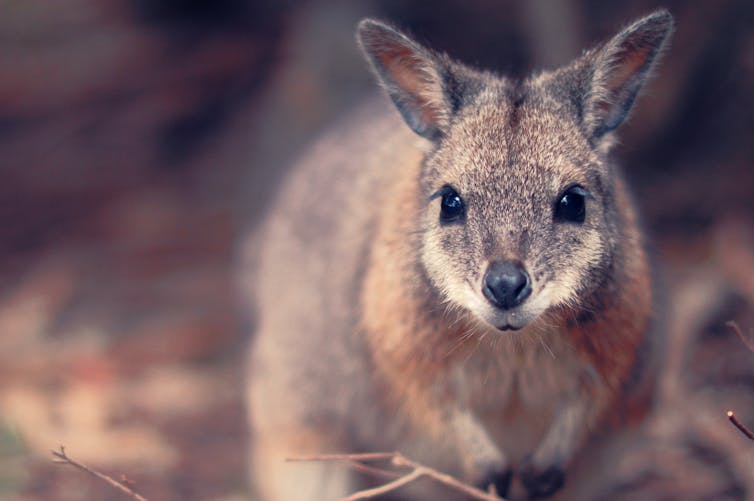
You only get 52 teeth in your lifetime: 20 baby teeth, followed by 32 adult teeth.
It’s not like that for all animals. Some, like rodents, never replace their teeth. Others, like sharks, keep replacing them again and again.
So why do we humans replace our teeth only once? And how does the whole tooth replacement process work?
These are tricky questions, and we don’t have all the answers. But a new discovery about the strange tooth-replacement habits of the tammar wallaby, a small Australian marsupial, may help shed some light on this dental mystery.
Not Everybody Replaces Teeth The Same Way
It has been long assumed modern mammals all replace their teeth the same way. However, advances in 3D scanning and modelling have revealed mammals with unusual tooth replacement, like the tammar wallaby (Macropus eugenii) and the fruit bat (Eidolon helvum).
These mammals have given us important clues as to how humans and other mammals have evolved from ancestors with continuous tooth replacement.
How Do Humans Make And Replace Teeth?
Human teeth begin growing between the sixth and eighth week of an embryo’s development, when a band of tissue within the gums called the primary dental lamina starts to thicken. Along this band, clusters of special stem cells appear at the sites of future teeth, known as “placodes”.
The placodes then begin to grow into teeth, going through the bud, cap and bell stages along the way. They form into their final shape and harden with layers of dentine and enamel. Eventually, they will erupt through the gums. The incisors are the first to erupt, as early as 6 months old, which is why its called theteethingphase!
This generation of teeth, which grow from the primary dental lamina, are known as “primary dentition”, or baby teeth.
Secondary or adult teeth grow a little bit differently. An offshoot of tissue called the successional lamina grows out from the baby tooth, and that tissue develops the replacement tooth like an apple on a branch of a tree. Adult teeth begin to grow before we are born, but take many years for the full set to form and eventually appear.
Replacement occurs when the adult teeth get large enough that they finally push out the baby teeth and remain as the permanent set of teeth for the rest of our lives. The first molar usually erupts between 6 and 7 years of age, while our wisdom teeth are the last to appear (roughly between 17 and 21 years of age).
Most mammals replace their teeth once in the course of their lives, like we do. This is known as “diphyodonty” (two sets of teeth).
Some groups of mammals, such as rodents, don’t replace their teeth at all. These “monophyodonts” get by with the same set of teeth for their whole lives. There are also a few unusual mammals, such as echidnas, that don’t grow any teeth at all!
Learning From The Wallaby
The tammar wallaby is also a diphyodont, replacing its teeth only once.
Scientists long assumed it replaced its teeth in the same way humans do, though historical notes going back as far as 1893 noticed unusual things about this marsupial’s tooth development. For starters, while we replace our incisors, canines and premolars, tammar wallabies only replace their premolars.

Recently my colleagues at Monash University and the University of Melbourne and I observed the teeth of tammar wallabies from the embryo through to adulthood. We used a technique called diceCT, which combines staining and CT scanning, and found something surprising.
Instead of replacement premolar teeth developing from the successional lamina, they were in fact delayed baby teeth developing from the primary dental lamina.
This means the tammar wallaby does not have any traditional tooth replacement. This discovery opens up a huge set of new questions. What exactly are these teeth?
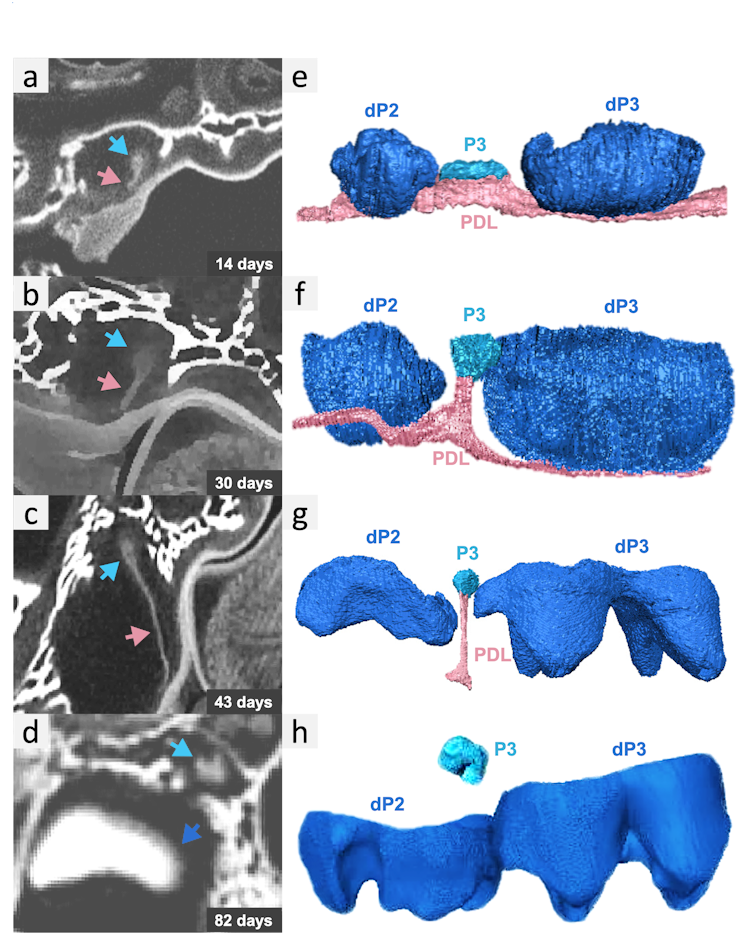
One explanation for these delayed baby teeth could be a link to our ancestry of continuous tooth replacement.
Your Teeth Are Millions Of Years In The Making
Unlike mammals, most other animals, including fish, sharks, amphibians and reptiles, replace their teeth multiple times (they are “polyphyodonts”). Mammals lost this ability around 205 million years ago.
The reason we stop making teeth is because our dental lamina degrades after our second set are made, while it remains active in polyphyodonts.
Interestingly, in modern and fossil polyphyodonts the replacement teeth often develop in groups of alternating waves, known as “Zahnreihen”.
While the tammar only replaces its premolars, these delayed baby teeth could represent the presence of the Zahnreihen still occurring in modern mammals.
This gives us a clue about how we have evolved from ancestors with continuous tooth replacement: by modifying and reducing a system that is hundreds of millions of years old.
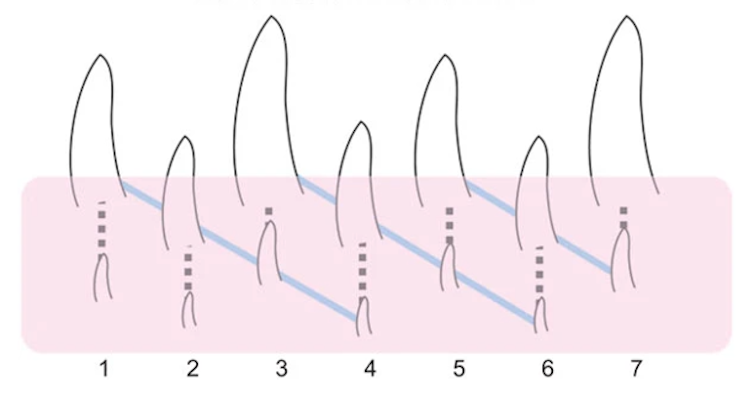
Research has also found that fruit bats (Eidolon helvum) make replacement teeth in unusual ways, including growing them in front of the baby tooth, behind it, beside it, or splitting off from it.
This is exciting because, together with the tammar, it shows there may well be a wealth of tooth replacement diversity across mammals happening right under our noses – or our gums!![]()
Qamariya Nasrullah, Postdoctoral Research Associate in Evolutionary Morphology, Monash University
This article is republished from The Conversation under a Creative Commons license. Read the original article.
In The Australian Wars, Rachel Perkins dispenses with the myth Aboriginal people didn’t fight back
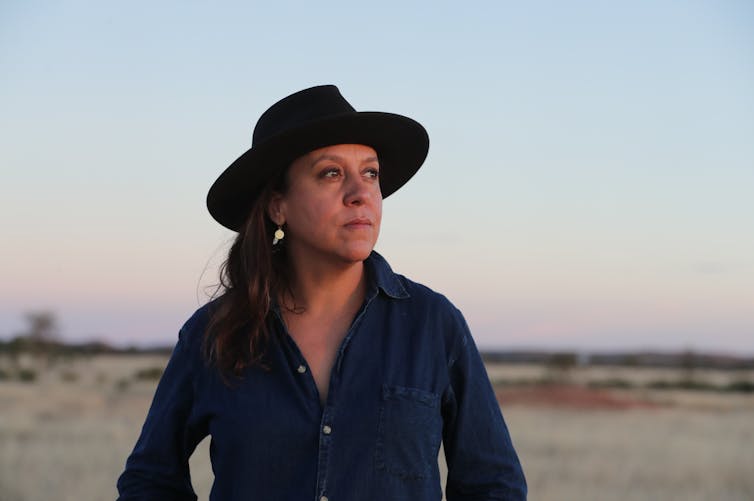
First Nations people please be advised this article mentions colonial violence towards Aboriginal and Torres Strait Islander people.
The Australian Wars is a new three-part TV series directed and produced by Arrernte and Kalkadoon nations filmmaker Rachel Perkins.
Perkins travels across vast territory to capture key aspects of a war that lasted more than 100 years, from the landing of the First Fleet in 1788 until the 1920s.
The series traces some of the key phases, sites and underlying features of frontier wars here on home soil.
It sets out to understand why the war was never declared, why the British didn’t follow their own laws, and the tactics and strategies Aboriginal people deployed defending their land and survival.
Perkins asks us to consider this difficult history, why there are only a handful of monuments to this warfare, and how it should be memorialised.
To ask these questions, Perkins deploys stunningly shot re-enactments, archives, artefacts, biography, expert evidence and uses place to great effect.
The series treats the viewer with the ability to critically reflect and ask why we still struggle to come to terms with this history.
The Frontier Wars
The “frontier wars” were the conflicts between Europeans and Aboriginal people over access to land the British sought to occupy exclusively without any agreement, treaty or settlement. This series emphasises Aboriginal people resisted these wars in multiple ways, including warfare. Aboriginal people are still resisting these wars today, in the courts.
The Australian Wars is an important contribution to truth-telling. Perkins provides a public reckoning with the means by which the British Empire – followed by independent democratic Australian governments – managed to grab the entirety of the land assets of the continent.
The dominant narrative of Australian settler colonialism was once sunny tales of possession, sustained by hard toil. Aboriginal acts of resistance, refusal and warfare were somehow miraculously omitted.
Only in recent decades has a more truthful account of the past emerged. New conversations and responsibility are slowly navigating the realities of the frontier, the shared history of “both sides” and how the past can be remembered.
Reconciliation Australia’s “Reconciliation Barometer” survey identified only 64% of non-Indigenous Australians believed the frontier wars occurred. Some 30% of respondents were unsure and 6% rejected the factual accuracy of significant aspects of Australia’s colonial history.
The Australian War Memorial, once tasked with considering how to reflect frontier wars in Australia’s story, rejected any inclusion of the frontier wars in its exhibitions.
The documentary returns to the theme of rejecting this part of Australia’s history and asks: how can the frontier wars be remembered and memorialised?
Perkins reminds us that as many people – both black and white – died in the frontier wars as did in overseas conflicts featured at the Australian War Memorial.
The Moving Frontier
The Australian Wars draws together experts of Australian history, detailed studies of the expansive colonial records, the oral testimony of survivors’ descendants and new archaeological research.
With this trove of references, Perkins reveals the extent and breadth of violence, the global networks of military men and the strategies they honed on the frontier, and the technology that came to enable this.
Ultimately, we learn unfettered access to the land resource was the driving factor. The rule of law, claims of humanitarianism and Christianity were readily dispensed with in pursuit of land.
Perkins begins this story in the nation’s capital at the War Memorial. She then follows the moving frontier from the Sydney settlement to Tasmania and crossing Bass Strait. The story then moves with rapid pace from south to north and across the top end to the Kimberley, as settlers expanded across landscapes in always violent encounters.
She dispenses with the abiding myth Aboriginal people didn’t fight back.
In each location Perkins focuses on, we see different strategies deployed, tactical advantage held at times by Aboriginal people, the fear and terror struck in the settlers, and the military actors and strategy that underpinned the colonial settlements.
By the third episode, as the frontier heads north, settlers take lessons from Sydney, Tasmania and the New South Wales grasslands country. Moving with much greater speed aided now by horses, the settlers recruited skilled Native Mounted Police, used repeating rifles and developed systems and infrastructure to confine Aboriginal people to prisons.
But the Aboriginal peoples whose lands were being invaded were fast developing new tactics.
In Queensland alone it is estimated 72,000 Aboriginal men, women and children were killed.
How Do We Remember?
The series prompts us to ask: if not war, then what do we call the process by which the land, once all carefully delineated and peopled, is occupied by settlers?
How do we remember this and memorialise those who died?
Perkins tells us this violence was often very well documented. This violence was acted against people whose eyes you could see. Yet from Lake George, just outside the nation’s capital, to the Sydney wars and massacres, Tasmania, Queensland and to the Kimberley, sites of violence are overwhelmingly unmarked, unobserved, save for colonial names: “Blackfellows Bones”, “Victory Hill”.
The silence continues.
Leading Australian historian Henry Reynolds says the frontier wars are our most important war because of where they were fought and what they were about: the outcome determined the ownership and sovereign control of a whole continent.
As he comments in the series “what can be more important than that to us?”
The Australian Wars is on SBS and SBS on Demand from today.![]()
Heidi Norman, Professor, Faculty of Arts and Social Sciences, University of Technology Sydney and Anne Maree Payne, Lecturer, Centre for the Advancement of Indigenous Knowledges, University of Technology Sydney
This article is republished from The Conversation under a Creative Commons license. Read the original article.
Deepfake audio has a tell – researchers use fluid dynamics to spot artificial imposter voices

Imagine the following scenario. A phone rings. An office worker answers it and hears his boss, in a panic, tell him that she forgot to transfer money to the new contractor before she left for the day and needs him to do it. She gives him the wire transfer information, and with the money transferred, the crisis has been averted.
The worker sits back in his chair, takes a deep breath, and watches as his boss walks in the door. The voice on the other end of the call was not his boss. In fact, it wasn’t even a human. The voice he heard was that of an audio deepfake, a machine-generated audio sample designed to sound exactly like his boss.
Attacks like this using recorded audio have already occurred, and conversational audio deepfakes might not be far off.
Deepfakes, both audio and video, have been possible only with the development of sophisticated machine learning technologies in recent years. Deepfakes have brought with them a new level of uncertainty around digital media. To detect deepfakes, many researchers have turned to analyzing visual artifacts – minute glitches and inconsistencies – found in video deepfakes.
Audio deepfakes potentially pose an even greater threat, because people often communicate verbally without video – for example, via phone calls, radio and voice recordings. These voice-only communications greatly expand the possibilities for attackers to use deepfakes.
To detect audio deepfakes, we and our research colleagues at the University of Florida have developed a technique that measures the acoustic and fluid dynamic differences between voice samples created organically by human speakers and those generated synthetically by computers.
Organic Vs. Synthetic Voices
Humans vocalize by forcing air over the various structures of the vocal tract, including vocal folds, tongue and lips. By rearranging these structures, you alter the acoustical properties of your vocal tract, allowing you to create over 200 distinct sounds, or phonemes. However, human anatomy fundamentally limits the acoustic behavior of these different phonemes, resulting in a relatively small range of correct sounds for each.
In contrast, audio deepfakes are created by first allowing a computer to listen to audio recordings of a targeted victim speaker. Depending on the exact techniques used, the computer might need to listen to as little as 10 to 20 seconds of audio. This audio is used to extract key information about the unique aspects of the victim’s voice.
The attacker selects a phrase for the deepfake to speak and then, using a modified text-to-speech algorithm, generates an audio sample that sounds like the victim saying the selected phrase. This process of creating a single deepfaked audio sample can be accomplished in a matter of seconds, potentially allowing attackers enough flexibility to use the deepfake voice in a conversation.
Detecting Audio Deepfakes
The first step in differentiating speech produced by humans from speech generated by deepfakes is understanding how to acoustically model the vocal tract. Luckily scientists have techniques to estimate what someone – or some being such as a dinosaur – would sound like based on anatomical measurements of its vocal tract.
We did the reverse. By inverting many of these same techniques, we were able to extract an approximation of a speaker’s vocal tract during a segment of speech. This allowed us to effectively peer into the anatomy of the speaker who created the audio sample.
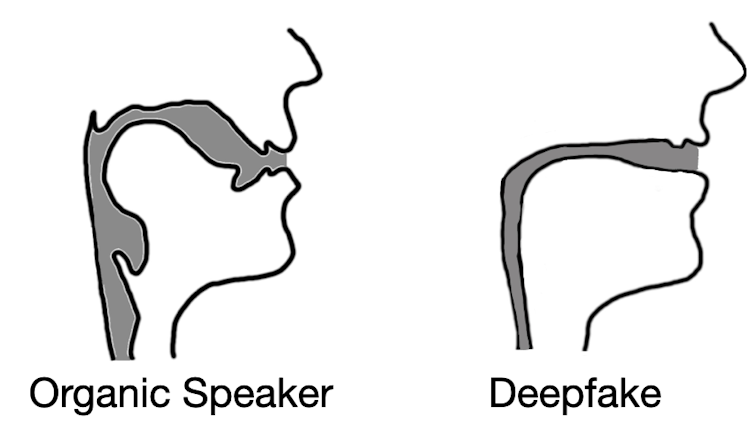
From here, we hypothesized that deepfake audio samples would fail to be constrained by the same anatomical limitations humans have. In other words, the analysis of deepfaked audio samples simulated vocal tract shapes that do not exist in people.
Our testing results not only confirmed our hypothesis but revealed something interesting. When extracting vocal tract estimations from deepfake audio, we found that the estimations were often comically incorrect. For instance, it was common for deepfake audio to result in vocal tracts with the same relative diameter and consistency as a drinking straw, in contrast to human vocal tracts, which are much wider and more variable in shape.
This realization demonstrates that deepfake audio, even when convincing to human listeners, is far from indistinguishable from human-generated speech. By estimating the anatomy responsible for creating the observed speech, it’s possible to identify the whether the audio was generated by a person or a computer.
Why This Matters
Today’s world is defined by the digital exchange of media and information. Everything from news to entertainment to conversations with loved ones typically happens via digital exchanges. Even in their infancy, deepfake video and audio undermine the confidence people have in these exchanges, effectively limiting their usefulness.
If the digital world is to remain a critical resource for information in people’s lives, effective and secure techniques for determining the source of an audio sample are crucial.![]()
Logan Blue, PhD student in Computer & Information Science & Engineering, University of Florida and Patrick Traynor, Professor of Computer and Information Science and Engineering, University of Florida
This article is republished from The Conversation under a Creative Commons license. Read the original article.
Book Of The Month: October 2022 - Voss By Patrick White
Originally published: London: Eyre & Spottiswoode, 1957.
Set in nineteenth-century Australia, Voss is White's best-known book, a sweeping novel about a secret passion between the explorer Voss and the young orphan Laura. As Voss is tested by hardship, mutiny, and betrayal during his crossing of the brutal Australian desert, Laura awaits his return in Sydney, where she endures their months of separation as if her life were a dream and Voss the only reality. Marrying a sensitive rendering of hidden love with a stark adventure narrative, Voss is a novel of extraordinary power and virtuosity from a twentieth-century master.
This law makes it illegal for companies to collect third-party data to profile you. But they do anyway

A little-known provision of the Privacy Act makes it illegal for many companies in Australia to buy or exchange consumers’ personal data for profiling or targeting purposes. It’s almost never enforced. In a research paper published today, I argue that needs to change.
“Data enrichment” is the intrusive practice of companies going behind our backs to “fill in the gaps” of the information we provide.
When you purchase a product or service from a company, fill out an online form, or sign up for a newsletter, you might provide only the necessary data such as your name, email, delivery address and/or payment information.
That company may then turn to other retailers or data brokers to purchase or exchange extra data about you. This could include your age, family, health, habits and more.
This allows them to build a more detailed individual profile on you, which helps them predict your behaviour and more precisely target you with ads.
For almost ten years, there has been a law in Australia that makes this kind of data enrichment illegal if a company can “reasonably and practicably” request that information directly from the consumer. And at least one major data broker has asked the government to “remove” this law.
The burning question is: why is there not a single published case of this law being enforced against companies “enriching” customer data for profiling and targeting purposes?
Data Collection ‘Only From The Individual’
The relevant law is Australian Privacy Principle 3.6 and is part of the federal Privacy Act. It applies to most organisations that operate businesses with annual revenues higher than A$3 million, and smaller data businesses.
The law says such organisations:
must collect personal information about an individual only from the individual […] unless it is unreasonable or impracticable to do so.
This “direct collection rule” protects individuals’ privacy by allowing them some control over information collected about them, and avoiding a combination of data sources that could reveal sensitive information about their vulnerabilities.
But this rule has received almost no attention. There’s only one published determination of the federal privacy regulator on it, and that was against the Australian Defence Force in a different context.
According to Australian Privacy Principle 3.6, it’s only legal for an organisation to collect personal information from a third party if it would be “unreasonable or impracticable” to collect that information from the individual alone.
This exception was intended to apply to limited situations, such as when:
- the individual is being investigated for some wrongdoing
- the individual’s address needs to be updated for delivery of legal or official documents.
The exception shouldn’t apply simply because a company wants to collect extra information for profiling and targeting, but realises the customer would probably refuse to provide it.
Who’s Bypassing Customers For Third-Party Data?
Aside from data brokers, companies also exchange information with each other about their respective customers to get extra information on customers’ lives. This is often referred to as “data matching” or “data partnerships”.
Companies tend to be very vague about who they share information with, and who they get information from. So we don’t know for certain who’s buying data-enrichment services from data brokers, or “matching” customer data.
Major companies such as Amazon Australia, eBay Australia, Meta (Facebook), 10Play Viacom and Twitter include terms in the fine print of their privacy policies that state they collect personal information from third parties, including demographic details and/or interests.
Google, News Corp, Seven, Nine and others also say they collect personal information from third parties, but are more vague about the nature of that information.
These privacy policies don’t explain why it would be unreasonable or impracticable to collect that information directly from customers.
Consumer ‘Consent’ Is Not An Exception
Some companies may try to justify going behind customers’ backs to collect data because there’s an obscure term in their privacy policy that mentions they collect personal information from third parties. Or because the company disclosing the data has a privacy policy term about sharing data with “trusted data partners”.
But even if this amounts to consumer “consent” under the relatively weak standards for consent in our current privacy law, this is not an exception to the direct collection rule.
The law allows a “consent” exception for government agencies under a separate part of the direct collection rule, but not for private organisations.
Data Enrichment Involves Personal Information
Many companies with third-party data collection terms in their privacy policies acknowledge this is personal information. But some may argue the collected data isn’t “personal information” under the Privacy Act, so the direct collection rule doesn’t apply.
Companies often exchange information about an individual without using the individual’s legal name or email. Instead they may use a unique advertising identifier for that individual, or “hash” the email address to turn it into a unique string of numbers and letters.
They essentially allocate a “code name” to the consumer. So the companies can exchange information that can be linked to the individual, yet say this information wasn’t connected to their actual name or email.
However, this information should still be treated as personal information because it can be linked back to the individual when combined with other information about them.
At Least One Major Data Broker Is Against It
Data broker Experian Australia has asked the government to “remove” Australian Privacy Principle 3.6 “altogether”. In its submission to the Privacy Act Review in January, Experian argued:
It is outdated and does not fit well with modern data uses.
Others who profit from data enrichment or data matching would probably agree, but prefer to let sleeping dogs lie.

Experian argued the law favours large companies with direct access to lots of customers and opportunities to pool data collected from across their own corporate group. It said companies with access to fewer consumers and less data would be disadvantaged if they can’t purchase data from brokers.
But the fact that some digital platforms impose extensive personal data collection on customers supports the case for stronger privacy laws. It doesn’t mean there should be a data free-for-all.
Our Privacy Regulator Should Take Action
It has been three years since the consumer watchdog recommended major reforms to our privacy laws to reduce the disadvantages consumers suffer from invasive data practices. These reforms are probably still years away, if they eventuate at all.
The direct collection rule is a very rare thing. It is an existing Australian privacy law that favours consumers. The privacy regulator should prioritise the enforcement of this law for the benefit of consumers.![]()
Katharine Kemp, Senior Lecturer, Faculty of Law & Justice, UNSW, UNSW Sydney
This article is republished from The Conversation under a Creative Commons license. Read the original article.
Hilary Mantel was one of the great voices of historical fiction – and so much more

Dame Hilary Mantel was a writer of immense skill and originality, and her death represents an incalculable loss to British literature. She will be chiefly remembered for her trilogy on the life of the Tudor politician Thomas Cromwell.
The grace and vigour of these gripping novels transformed our understanding of what historical fiction can do. They were extraordinarily successful. Wolf Hall (2009) and Bring Up the Bodies (2012) both won the Booker Prize (she was the first woman to win the prize more than once), and The Mirror and the Light (2020) was longlisted. I was a member of the jury that awarded the Booker Prize to Bring Up the Bodies, and we were of one mind about the superb quality of that novel.
Adaptations for both television and stage followed, and it is a tribute to the power of Mantel’s exploration of the ambiguities surrounding Cromwell’s dramatic life that these versions brought many enthusiastic new readers to her novels. She became, relatively late in her life, a literary star.
The popularity of Mantel’s trilogy should not overshadow the remarkable range of her achievement. Her treatment of Thomas Cromwell brought a mass readership, but the accomplishment of her earlier novels had already won critical recognition.
A Writer’s Life
Mantel graduated from LSE and Sheffield University, and married Gerald McEwan, a geologist, in 1972 (they divorced in 1981, and remarried in 1982). A short spell of employment as a social worker lay behind her first published novel, the darkly comic Every Day is Mother’s Day (1985), and its sequel Vacant Possession (1986).

A major historical novel, A Place of Greater Safety (completed in 1979, but not published until 1992) is a characteristically innovative interpretation of the French Revolution. Here, as throughout Mantel’s writing, a far-sighted grasp of the sweep of history and politics was fused with the inward particularities of individual experience.
Mantel had a lyrical sense of the irreducible strangeness of the world, with its vivid moments of beauty and threat, but this was never removed from her understanding of the moral imperatives of our shared responsibilities. She was never a neutral observer of the ebb and flow of history.
Mantel spent extended periods of her life overseas – notably in Botswana and Saudi Arabia – and she was always alert to a world beyond Britain. Eight Months on Ghazzah Street (1988) is a tense account of misunderstandings between westerners and Saudis living in Jeddah. A Change of Climate (1994) draws on her life in Botswana, and the traumatic social divisions she had witnessed in southern Africa.

Mantel had an unusually wide and well-informed grasp of social and cultural politics, but she never lost her interest in lives that unfold on the edge of what might be perceived as normality. Fludd (1989), describes a quasi-supernatural stranger whose arrival turns a dismal Catholic community upside down. It is never quite clear who Fludd is, or where he has come from, or whether he is an agent of good or evil.
The Giant, O’Brien (1998), based on the Irish giant Charles Byrne and the Scottish surgeon John Hunter, is in part a rueful reflection on Mantel’s own Irish roots. The legacies of Irish Catholicism also shadow An Experiment in Love (1995), a novel that looks back on the lives of girls of Mantel’s postwar generation - eager to take advantage of new opportunities for education, but still haunted by the constraints of the past.
A Rich Legacy
The sense that another world exists, its presence flickering just past our everyday vision, underlies all of Mantel’s work. Beyond Black (2005) is an unsettling and brilliantly entertaining account of the life of a medium, who may or may not be a fraud.

Giving up the Ghost (2003), a searing memoir, repeatedly returns to the ghosts that stalked her early years – family ghosts, ghosts of unborn children, ghosts of lives that might have taken a different shape. Learning to Talk (2003), published in the same year, is a collection of short stories that turn on the same theme.
These stories are in part autobiographical recollections of Mantel’s childhood in Glossop, as she began to remove herself from the divided world of her family. Here too, it is the sharply observed details that linger – Miss Webster, for instance, the elocution teacher, with her careful accent – “precariously genteel, Manchester with icing”.
More recent short stories have been openly political, and sometimes controversial – notably The Assassination of Margaret Thatcher, the provocative title story in a collection published in 2014.
This shining stream of writing has now come to an end. It’s good to know that Hilary Mantel experienced and enjoyed all the success she had so richly earned, and that we are left with such a rich body of writing to relish and revisit. But the sense of immediate loss is painful. She was a unique and generous talent, and she will be hugely missed.![]()
Dinah Birch, Pro-Vice-Chancellor for Cultural Engagement, Professor of English Literature, University of Liverpool
This article is republished from The Conversation under a Creative Commons license. Read the original article.
Youth Mental Health Improves Despite COVID Pressure
Address The Logjam To End The Cycle Of Horror Stories: AMA
Even mild COVID raises the chance of heart attack and stroke. What to know about the risks ahead

A concerning report recently published in Nature Medicine suggests even a mild case of COVID can increase the long-term risks of serious cardiovascular diseases such as stroke, heart attack and heart failure. The study highlights our limited understanding of the full consequences of COVID infection and the long-term impact of the COVID pandemic.
Australia has now reported more than 10 million cases of acute COVID infection and more than 14,000 deaths, with at least 600 million more people infected worldwide.
The immediate effects of COVID infection on the heart have been well documented, with myocarditis (inflammation of the heart muscle) an infrequent but potentially lethal complication. But myocarditis only occurs in about 40 people per million infected.
The big concern raised by this fresh study is that medium- to long-term harms on the body’s blood vessel network (the vascular system) may be much more common than that. And it could drive a new pandemic of cardiovascular disease over the coming years.
What They Found
The study, led by researchers at Washington University, showed a heightened risk of future cardiovascular events among people who have recovered from COVID.
The authors analysed the health records of around 150,000 US veterans, who are often studied because they are a well-documented group within a discrete health-care system. They compared the rates of cardiovascular disease in veterans who’d experienced a COVID infection against uninfected control groups that included some 10 million people.
Between 30 days and a year after recovery from COVID, survivors were 52% more likely to have a stroke, 63% more likely to have a heart attack, and 72% more likely to develop heart failure. This means that over one year, for every 1,000 people who had COVID, there would be five extra strokes, three extra heart attacks and 12 extra cases of heart failure. There was also evidence of an increased risk of serious blood clots on the lungs.
While these numbers might sound small to some, when scaled to 600 million COVID infections worldwide, the implications are enormous.
One particularly concerning finding was that while those with more severe acute COVID infections had the highest risk of a cardiovascular events over the following year, even those with a mild infection were at increased risk. And that risk was not restricted to those who’d had heart health problems before – it could affect anyone.
Necessary Cautions
The study was large and had many strengths. But the findings must be reviewed with a degree of caution. It was an observational study (in which researchers draw inferences from what they see in a population, rather than control variables for an experimental study). So, we can’t be certain the increased risk of heart disease or stroke was definitely caused by the COVID infection. The people infected with COVID were not identical to the people who were uninfected.
That said, the researchers made statistical adjustments and could not identify another explanation for the large increases in risks seen.
It is also likely some people with asymptomatic COVID infection were accidentally included in the control groups. However, the effect of this would have been to underestimate the risks of COVID infection on cardiovascular risk.
And of course, US veterans are a very particular set of individuals (mostly older, male and white). Even if the effects of COVID on cardiovascular risk are real for them, there must be some uncertainty about whether the same effects would be seen in other populations.
COVID And Hearts
The clear, but low, risk of heart disease at the time of COVID infection also provides support for a connection between COVID infection and medium- to long-term heart disease.
Even before the COVID pandemic there was a well-established link between the inflammation caused by infection and the risk of heart attack.
A heart attack occurs when an artery supplying blood to the heart is blocked and the heart muscle is starved of oxygen. This usually happens when rupture of a fatty plaque in the artery causes a blood clot to form. This process is driven by inflammation in the tissues and thickening of the blood, both of which can occur with COVID, and both of which can persist long after the initial infection has resolved.
These data remind us once again of the importance of limiting the spread of the SARS-CoV-2 virus. The best way to reduce COVID-related risks is to prevent COVID infection and reduce the severity of infection. We must maintain high vaccination rates and support infection control measures such as mask wearing in high-risk situations. Ever stronger evidence of the long-term effects of COVID redoubles the importance of these efforts.
Future Problems
We rightly feared the respiratory complications of COVID throughout 2020 and 2021 but only now are we appreciating the full impact of the pandemic across other body systems.
Doctors will need to view COVID infection as a new long-term risk factor for cardiovascular disease in much the same way that many other chronic inflammatory conditions such as rheumatoid arthritis are viewed now. We should advocate for fair access to heart disease prevention and treatment in all Australians, particularly those at highest risk such as First Nations people. And most importantly, as patients, we must prioritise our own heart health.
And we’ll need to remain vigilant for the effects of new strains. Over the decades to come we’ll need to plan for the enduring effects of COVID.![]()
Clare Arnott, Co-Director of Global Chronic and Complex Diseases, George Institute for Global Health; Bruce Neal, Executive Director, George Institute Australia, George Institute for Global Health, and Jamie Cham, Lecturer, University of Sydney
This article is republished from The Conversation under a Creative Commons license. Read the original article.
I’ve had COVID and am constantly getting colds. Did COVID harm my immune system? Am I now at risk of other infectious diseases?

So you’ve had COVID and have now recovered. You don’t have ongoing symptoms and luckily, you don’t seem to have developed long COVID.
But what impacts has COVID had on your overall immune system?
It’s early days yet. But growing evidence suggests there are changes to your immune system that may put you at risk of other infectious diseases.
Here’s what we know so far.
A Round Of Viral Infections
Over this past winter, many of us have had what seemed like a continual round of viral illness. This may have included COVID, influenza or infection with respiratory syncytial virus. We may have recovered from one infection, only to get another.
Then there is the re-emergence of infectious diseases globally such as monkeypox or polio.
Could these all be connected? Does COVID somehow weaken the immune system to make us more prone to other infectious diseases?
There are many reasons for infectious diseases to emerge in new locations, after many decades, or in new populations. So we cannot jump to the conclusion COVID infections have given rise to these and other viral infections.
But evidence is building of the negative impact of COVID on a healthy individual’s immune system, several weeks after symptoms have subsided.
What Happens When You Catch A Virus?
There are three possible outcomes after a viral infection:
1) your immune system clears the infection and you recover (for instance, with rhinovirus which causes the common cold)
2) your immune system fights the virus into “latency” and you recover with a virus dormant in our bodies (for instance, varicella zoster virus, which causes chickenpox)
3) your immune system fights, and despite best efforts the virus remains “chronic”, replicating at very low levels (this can occur for hepatitis C virus).
Ideally we all want option 1, to clear the virus. In fact, most of us clear SARS-CoV-2, the virus that causes COVID. That’s through a complex process, using many different parts of our immune system.
But international evidence suggests changes to our immune cells after SARS-CoV-2 infection may have other impacts. It may affect our ability to fight other viruses, as well as other pathogens, such as bacteria or fungi.
How Much Do We Know?
An Australian study has found SARS-CoV-2 alters the balance of immune cells up to 24 weeks after clearing the infection.
There were changes to the relative numbers and types of immune cells between people who had recovered from COVID compared with healthy people who had not been infected.
This included changes to cells of the innate immune system (which provides a non-specific immune response) and the adaptive immune system (a specific immune response, targeting a recognised foreign invader).
Another study focused specifically on dendritic cells – the immune cells that are often considered the body’s “first line of defence”.
Researchers found fewer of these cells circulating after people recovered from COVID. The ones that remained were less able to activate white blood cells known as T-cells, a critical step in activating anti-viral immunity.

Other studies have found different impacts on T-cells, and other types of white blood cells known as B-cells (cells involved in producing antibodies).
After SARS-CoV-2 infection, one study found evidence many of these cells had been activated and “exhausted”. This suggests the cells are dysfunctional, and might not be able to adequately fight a subsequent infection. In other words, sustained activation of these immune cells after a SARS-CoV-2 infection may have an impact on other inflammatory diseases.
One study found people who had recovered from COVID have changes in different types of B-cells. This included changes in the cells’ metabolism, which may impact how these cells function. Given B-cells are critical for producing antibodies, we’re not quite sure of the precise implications.
Could this influence how our bodies produce antibodies against SARS-CoV-2 should we encounter it again? Or could this impact our ability to produce antibodies against pathogens more broadly – against other viruses, bacteria or fungi? The study did not say.
What Impact Will These Changes Have?
One of the main concerns is whether such changes may impact how the immune system responds to other infections, or whether these changes might worsen or cause other chronic conditions.
So more work needs to be done to understand the long-term impact of SARS-CoV-2 infection on a person’s immune system.
For instance, we still don’t know how long these changes to the immune system last, and if the immune system recovers. We also don’t know if SARS-CoV-2 triggers other chronic illnesses, such as chronic fatigue syndrome (myalgic encephalomyelitis). Research into this is ongoing.
What we do know is that having a healthy immune system and being vaccinated (when a vaccine has been developed) is critically important to have the best chance of fighting any infection.![]()
Lara Herrero, Research Leader in Virology and Infectious Disease, Griffith University
This article is republished from The Conversation under a Creative Commons license. Read the original article.
Did My Computer Say It Best?
Genetic Variants Linked To Congenital Urinary Tract Obstruction In Males
Zebrafish To Help In Search For MS Drugs
Octopuses Prefer Certain Arms When Hunting And Adjust Tactics To Prey
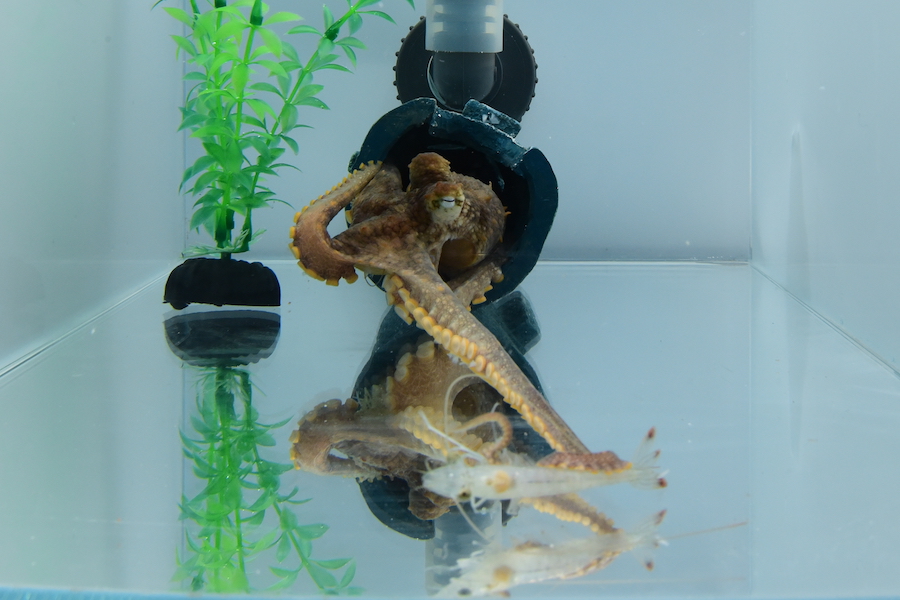
- Octopuses used arms on the same side as the eye viewing the prey.
- No matter what type of prey came by, each octopus attacked using the second arm from the middle.
- When hunting crabs, octopuses pounced on the prey with a cat-like movement, leading with the second arm.
- When hunting shrimp, the octopuses were more careful to avoid spooking the prey. They led with the second arm and after it made contact with the shrimp, they used neighbouring arms one and three to secure it.
World First Achievement In Diabetes Research: WSU
Malaria Spike Linked To Amphibian Die-Off
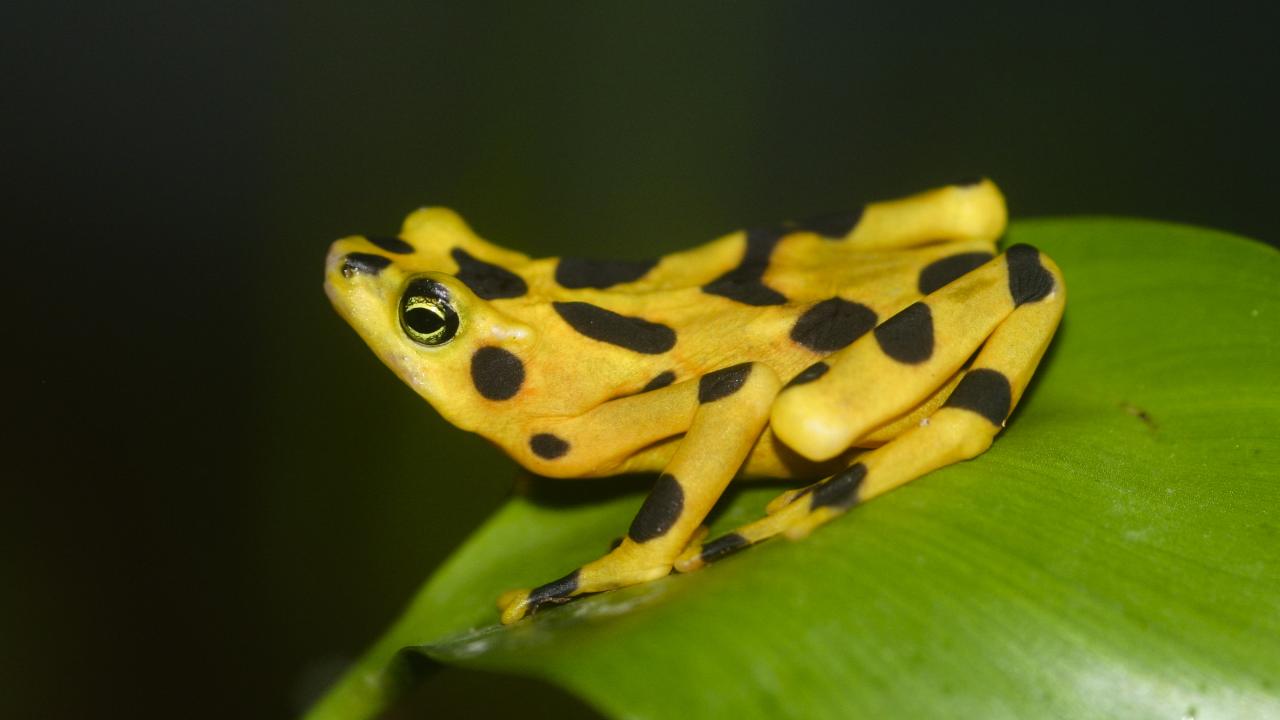
UNSW: T Cells Use Force To Destroy Cancer Cells
Disclaimer: These articles are not intended to provide medical advice, diagnosis or treatment. Views expressed here do not necessarily reflect those of Pittwater Online News or its staff.